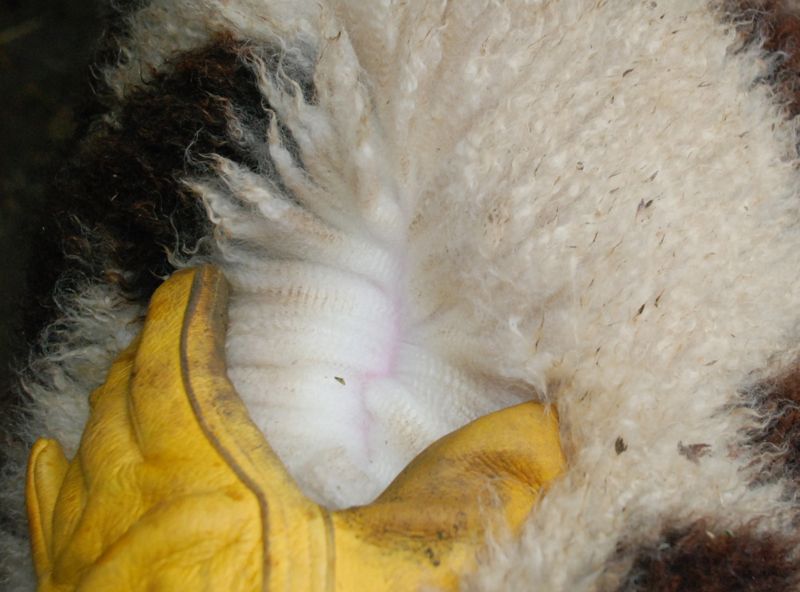Lambs Grow Up
/Lambs will be here at the end of February and I have been thinking about how fast they grow. Here are some of the 2013 favorite lambs as they grew up.
 This is Marilyn with her mom, Hot Lips.
This is Marilyn with her mom, Hot Lips.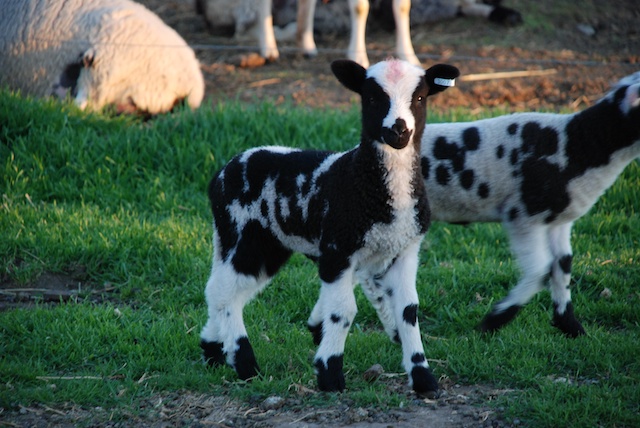 2 1/2 weeks old.
2 1/2 weeks old. First in her class at Black Sheep Gathering, 4 months old.
First in her class at Black Sheep Gathering, 4 months old.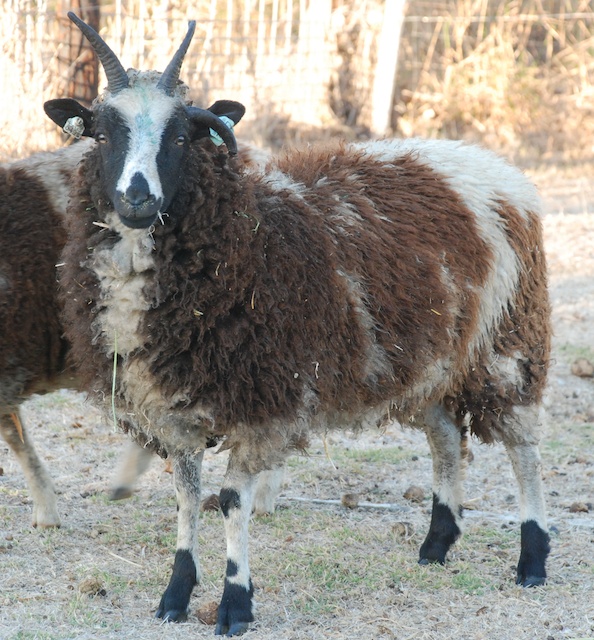 Marilyn at 8 months old. Isn't she pretty?
Marilyn at 8 months old. Isn't she pretty?  Santana at 10 days old.
Santana at 10 days old.  About a month old.
About a month old. Not quite two months old.
Not quite two months old. 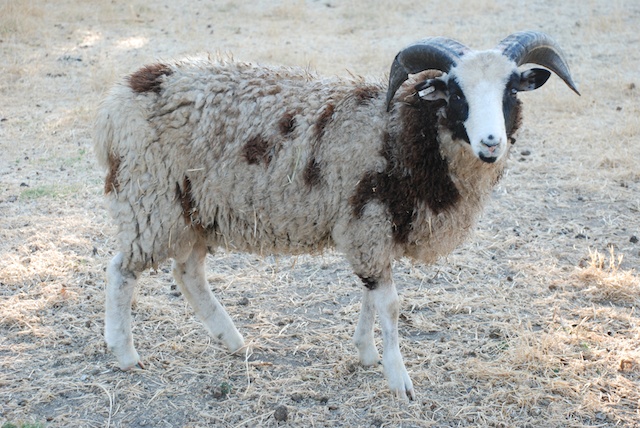 5 1/2 months old with a great horn spread.
5 1/2 months old with a great horn spread. Santana with his ewes 7 1/2 months old.
Santana with his ewes 7 1/2 months old.  That's Alex on the right at about 10 days old. Not much color on that side. Fortunately he has more on the other.
That's Alex on the right at about 10 days old. Not much color on that side. Fortunately he has more on the other.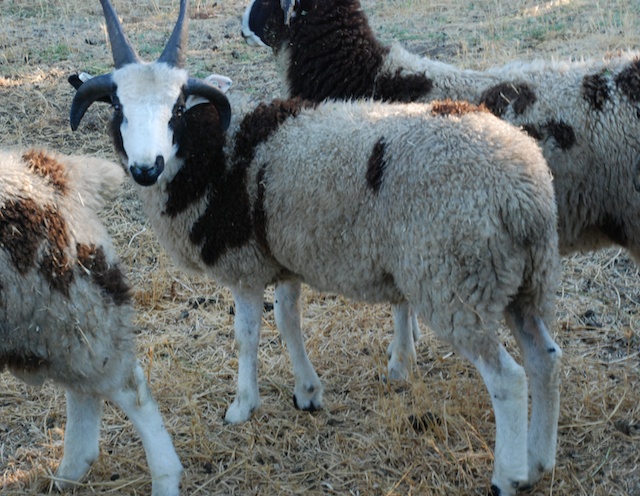 About 4 months old.
About 4 months old. About 8 months old.
About 8 months old. Alex after shearing, 9 months.
Alex after shearing, 9 months. This is Cascade at 10 days old.
This is Cascade at 10 days old. Two months old.
Two months old.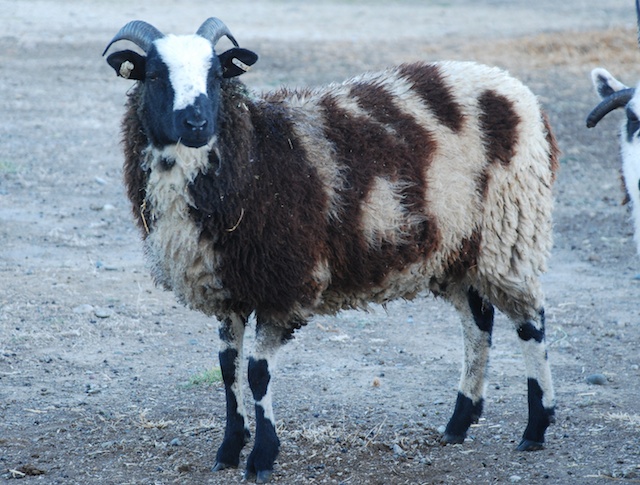 Here she is at 7 1/2 months.
Here she is at 7 1/2 months.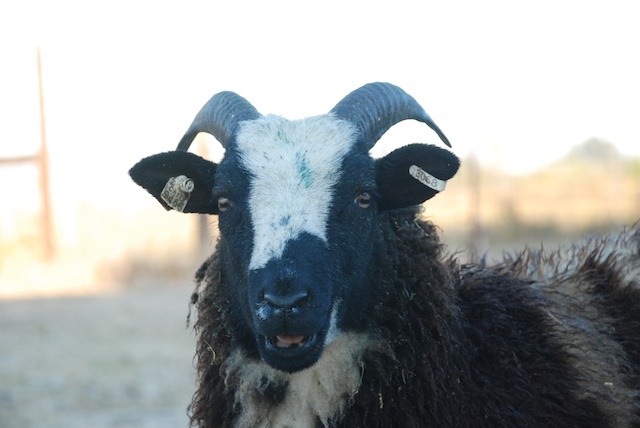
Fall Grazing
/Hendrix and his group of ewes have been in the back pasture since breeding season started and they have been at the north end of that pasture for a couple of weeks. Since hardly anything is growing (start the rain dance please) I figured that they couldn't do too much damage leaving them that long. I thought that maybe that could take down the dallisgrass and they actually did a pretty good job of it in most of the pasture. It is still a challenge however along the ditch and the fence-line. (If you search dallis in the blog search you'll see several posts about my attempts to conquer it.)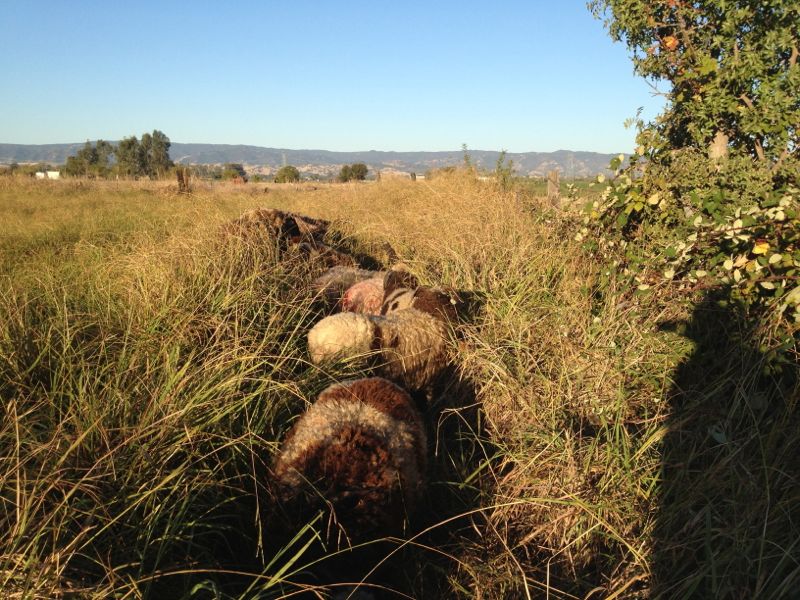 This is the north end of the property. Notice the blackberries on the north fence. I cut these away in the spring to uncover the electric fence wire on the inside of the field fence. The sheep could help in that job except that this time of year the dallis grass growing in and around the ditch keeps them from going over there. It may seem hard to believe that a grass keeps sheep from something, but this stuff is so coarse and strong it's like hacking your way through a jungle. And it's very sticky now from a fungus that grows on the seed head. Several years ago I found a ewe whose horns were so tangled in it that she was stuck upside down in this ditch. The only reason that I knew she was there was that she was baaing. The sheep in the photo above are in the ditch because I trampled some of the grass and put alfalfa there.
This is the north end of the property. Notice the blackberries on the north fence. I cut these away in the spring to uncover the electric fence wire on the inside of the field fence. The sheep could help in that job except that this time of year the dallis grass growing in and around the ditch keeps them from going over there. It may seem hard to believe that a grass keeps sheep from something, but this stuff is so coarse and strong it's like hacking your way through a jungle. And it's very sticky now from a fungus that grows on the seed head. Several years ago I found a ewe whose horns were so tangled in it that she was stuck upside down in this ditch. The only reason that I knew she was there was that she was baaing. The sheep in the photo above are in the ditch because I trampled some of the grass and put alfalfa there. 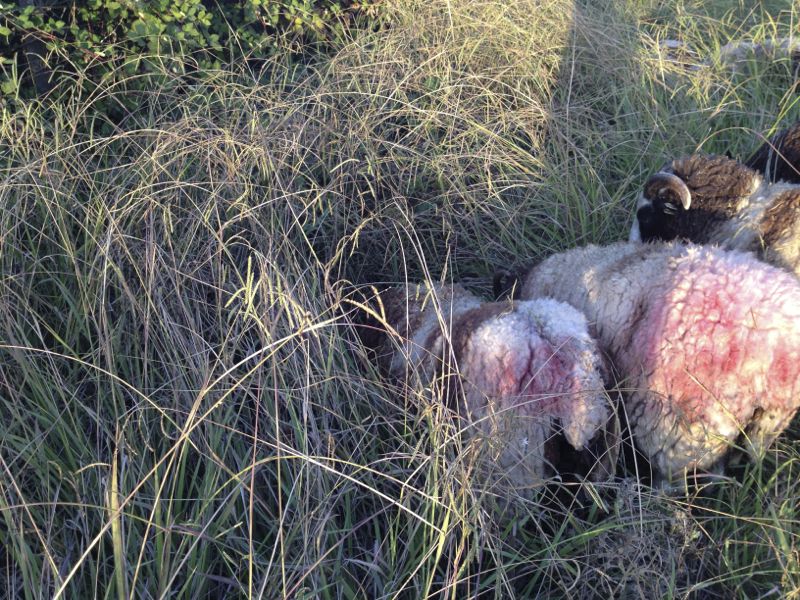
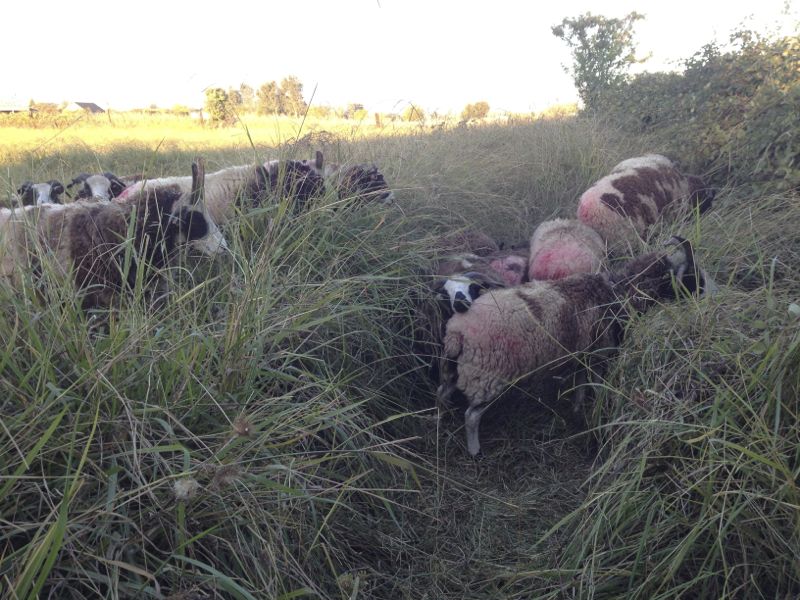 This photo shows that they are making progress. Now I can actually see a ditch and the sheep can get through it to the side with the blackberries.
This photo shows that they are making progress. Now I can actually see a ditch and the sheep can get through it to the side with the blackberries.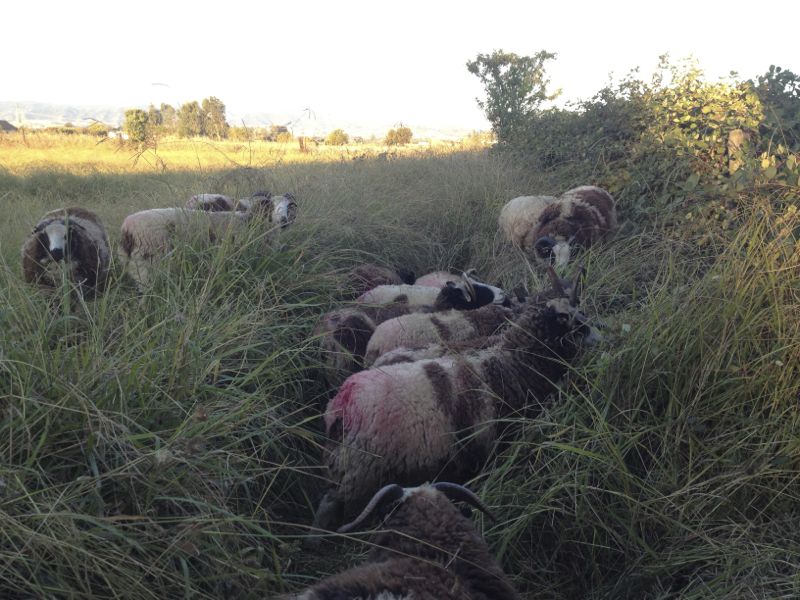 They are finding the hay in the blackberries and it makes it worth their while to work their way through the grass.
They are finding the hay in the blackberries and it makes it worth their while to work their way through the grass.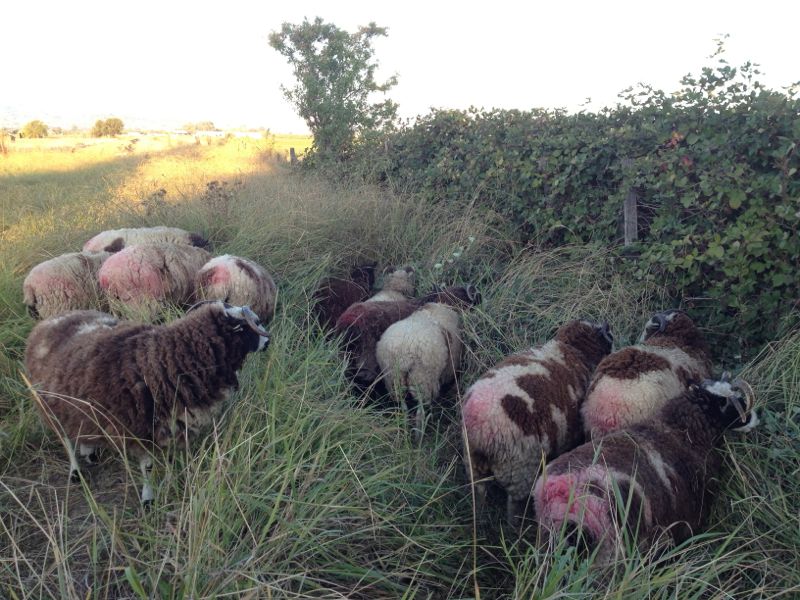
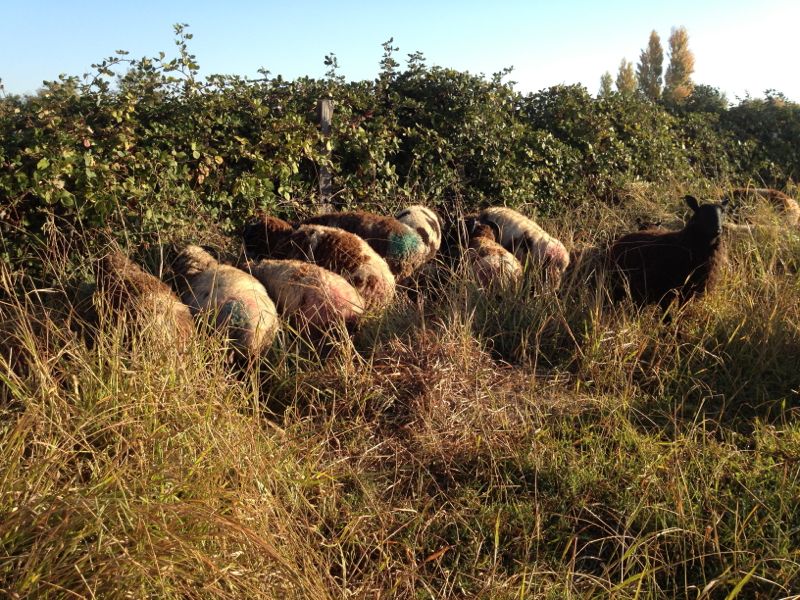 After about a week we have worked our way through the ditch and I'm putting the hay near the fence.
After about a week we have worked our way through the ditch and I'm putting the hay near the fence. 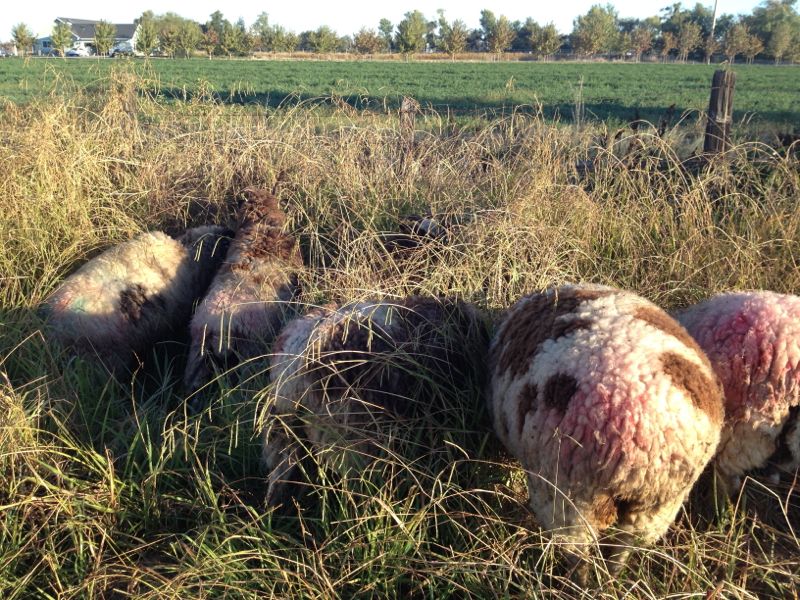 Then I moved beyond the blackberries and had them trample the dallisgrass along the rest of the fenceline.
Then I moved beyond the blackberries and had them trample the dallisgrass along the rest of the fenceline.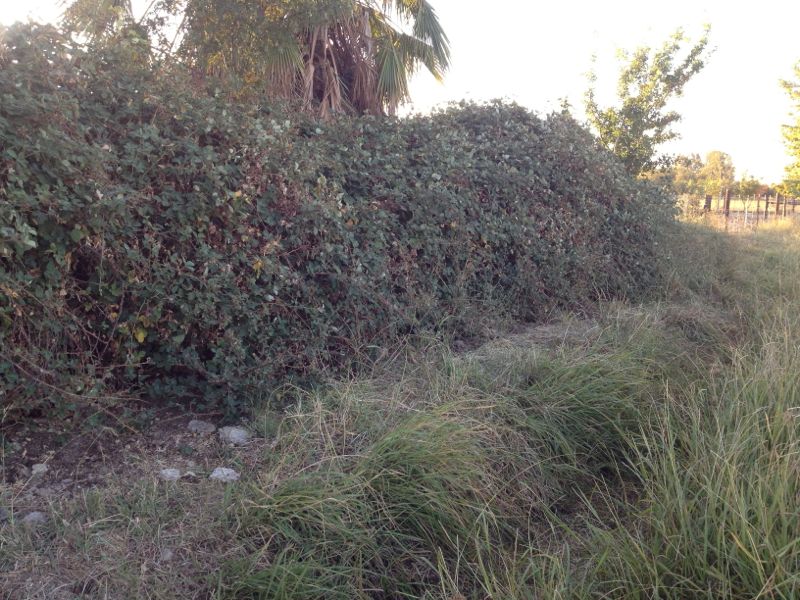 This is the east fence and it looked almost as full of grass before I started this project. It is more overrun with blackberries. The sheep have eaten some of the leaves off. I think I have to get in there with clippers now though. There is an electric fence hiding in there somewhere.
This is the east fence and it looked almost as full of grass before I started this project. It is more overrun with blackberries. The sheep have eaten some of the leaves off. I think I have to get in there with clippers now though. There is an electric fence hiding in there somewhere.
Red & Green in October
/I put the rams in with the ewes on October 1. This is Day 16 so it's time to change the marker. The ewe's heat cycle averages 17 days. If one of the previously marked ewes is remarked then I know that she wasn't bred in the first cycle. If multiple ewes are remarked I may have a ram fertility problem. 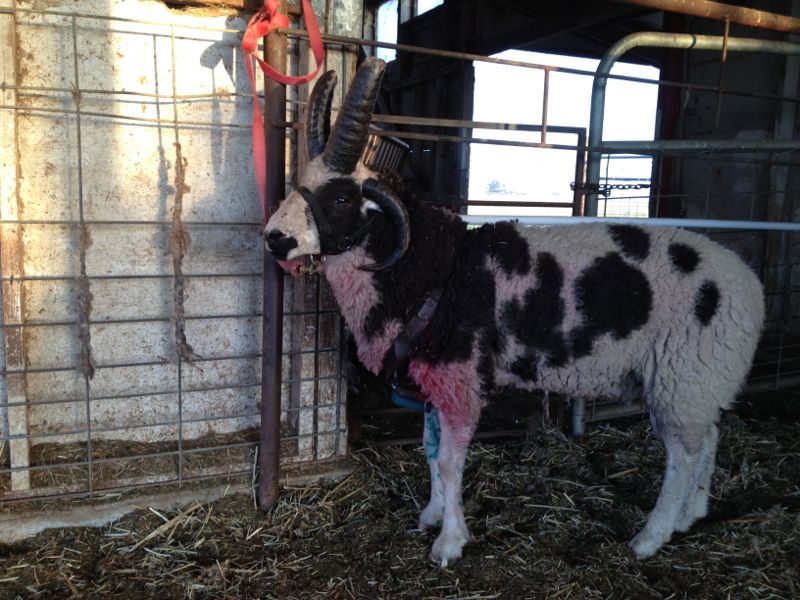 I changed the markers for all four rams from red to green.
I changed the markers for all four rams from red to green.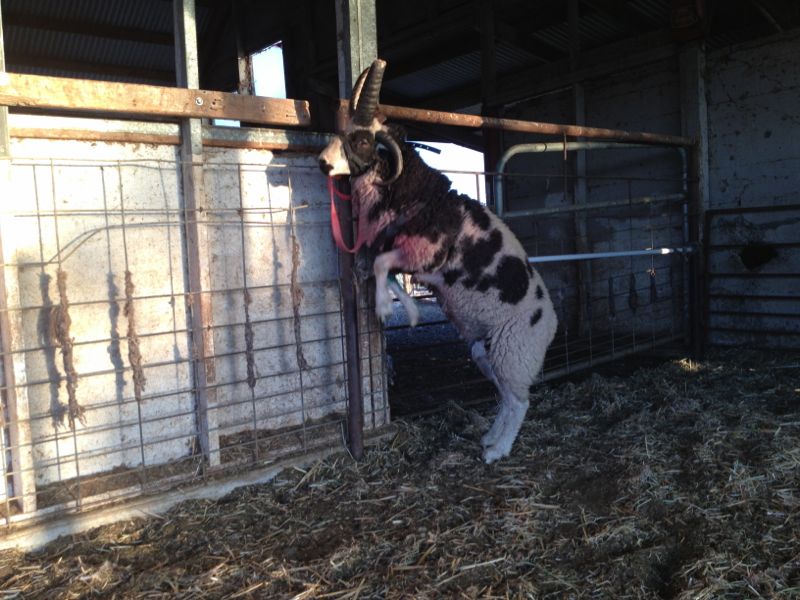 Hendrix was not very happy about being tied up.
Hendrix was not very happy about being tied up.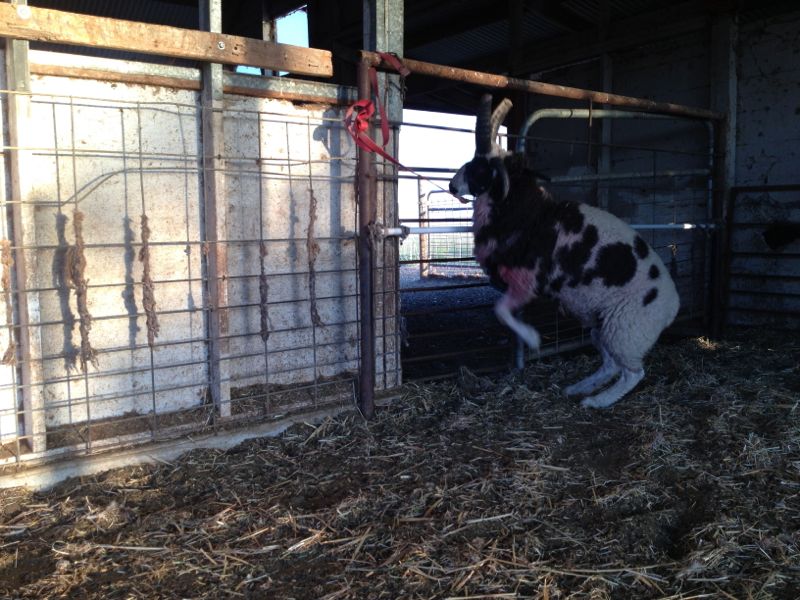
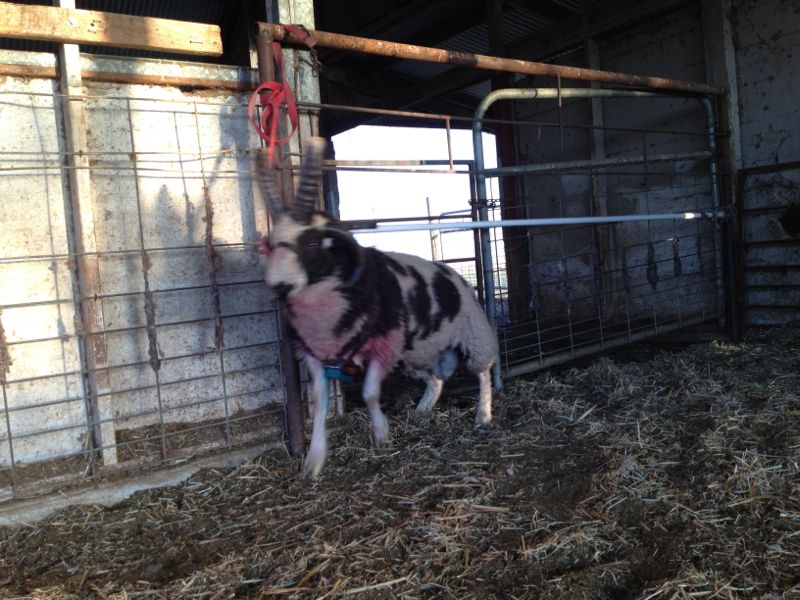
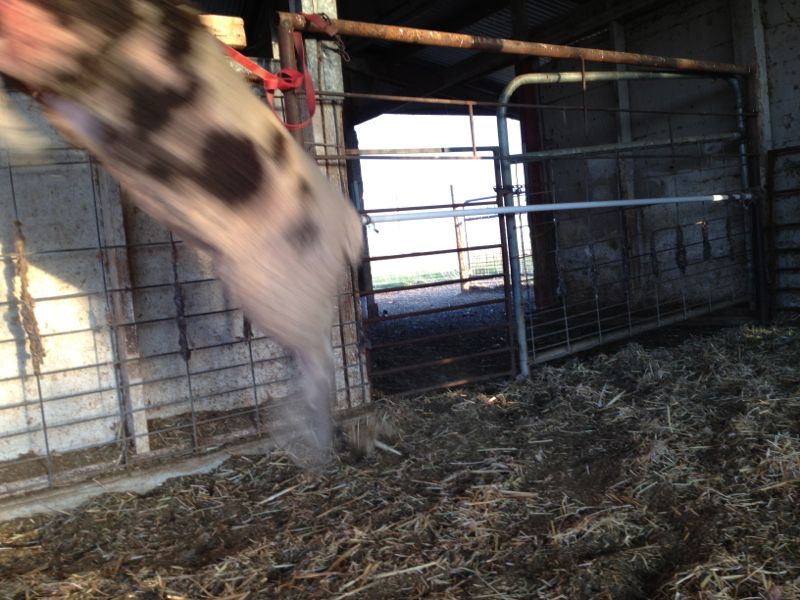
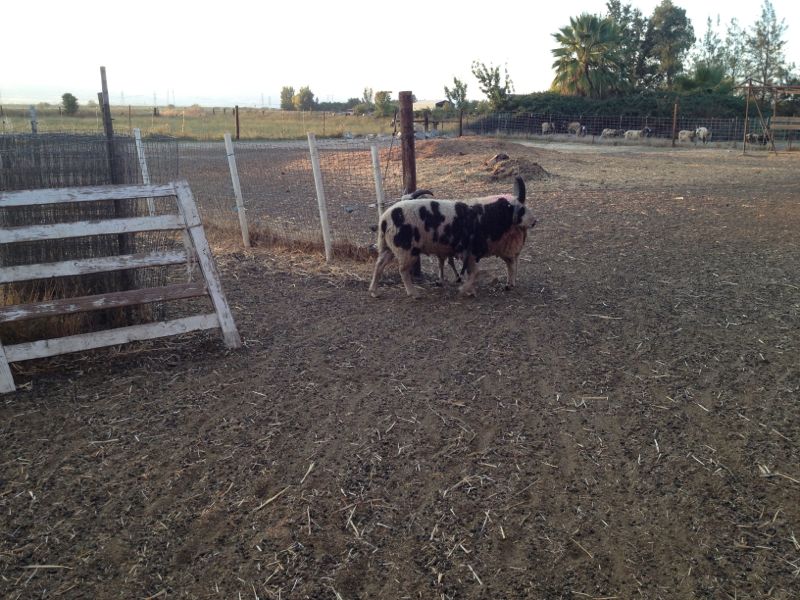 All he wanted was to get back to the ewe in heat.
All he wanted was to get back to the ewe in heat.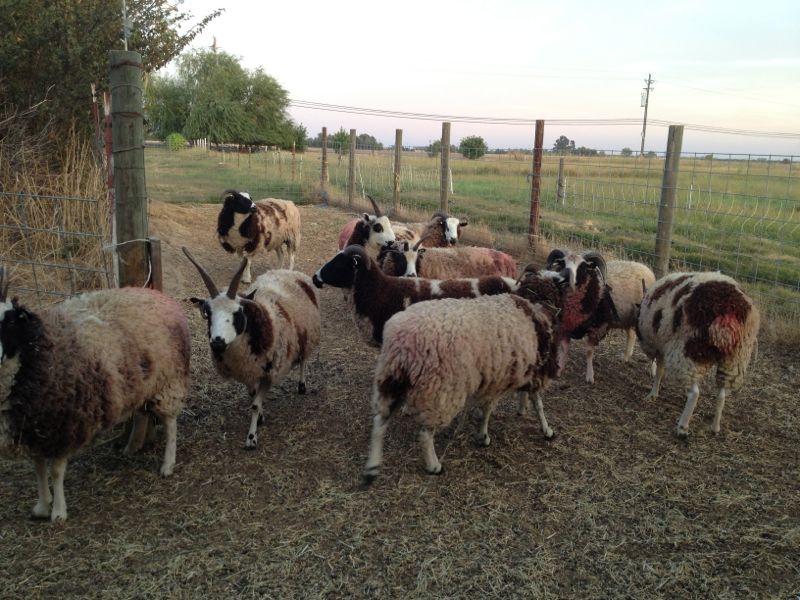 The young ram, now named Santana, (second from right) wasn't put in with the ewes until October 7 but several ewes have been marked.
The young ram, now named Santana, (second from right) wasn't put in with the ewes until October 7 but several ewes have been marked. 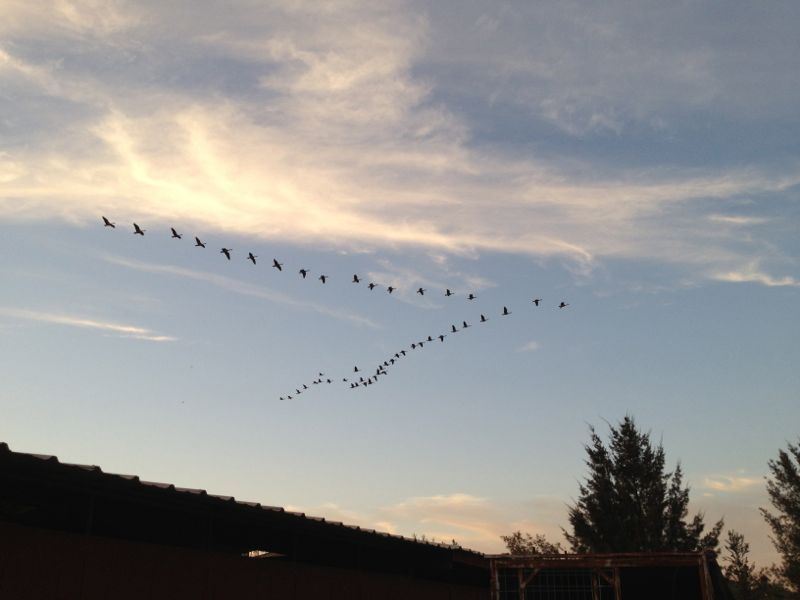 As I was working with the sheep I heard geese honking. It's that time of year.
As I was working with the sheep I heard geese honking. It's that time of year. And here is the gorgeous evening sky.
And here is the gorgeous evening sky.
Breeding Season
/It's time to think ahead five months to lambs. But that won't happen if I don't do something about it now. What with events and classes the last few weeks it was hard to get all the rams and ewes sorted into the right places but they are there now. 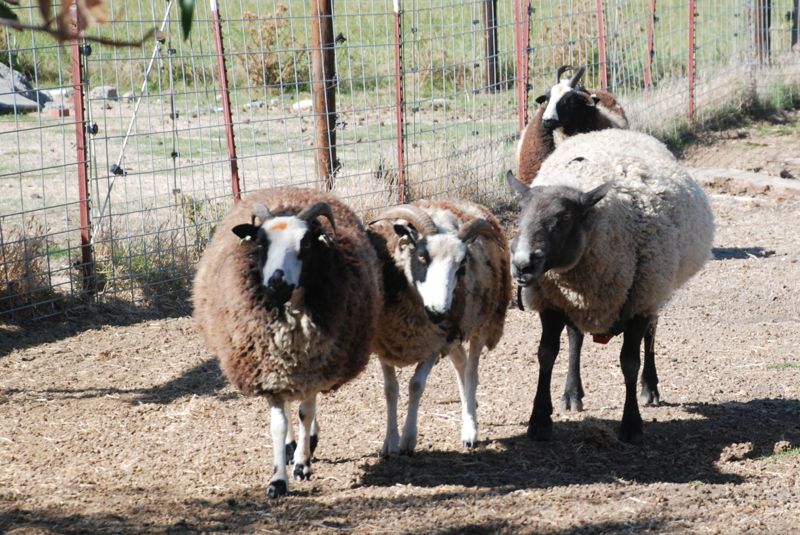 Faulkner's ewes were first to sort because at least I knew where I would put them. They are staying in Faulkner's pen. He has 7 ewes.
Faulkner's ewes were first to sort because at least I knew where I would put them. They are staying in Faulkner's pen. He has 7 ewes.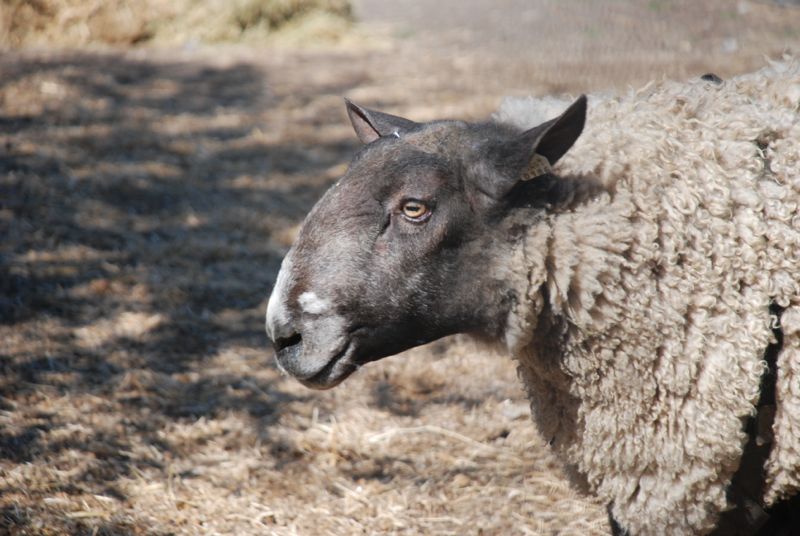
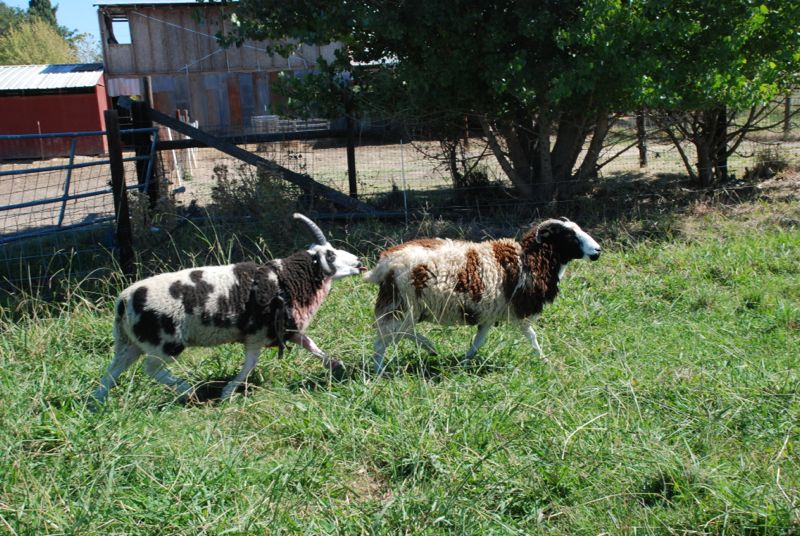 Hendrix, with 18 ewes, tried to get started right away.
Hendrix, with 18 ewes, tried to get started right away.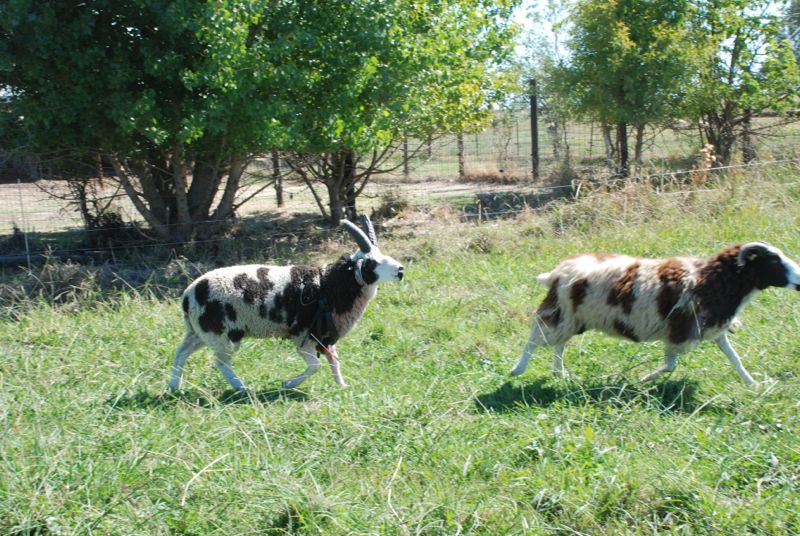 He didn't choose the right ewe.
He didn't choose the right ewe.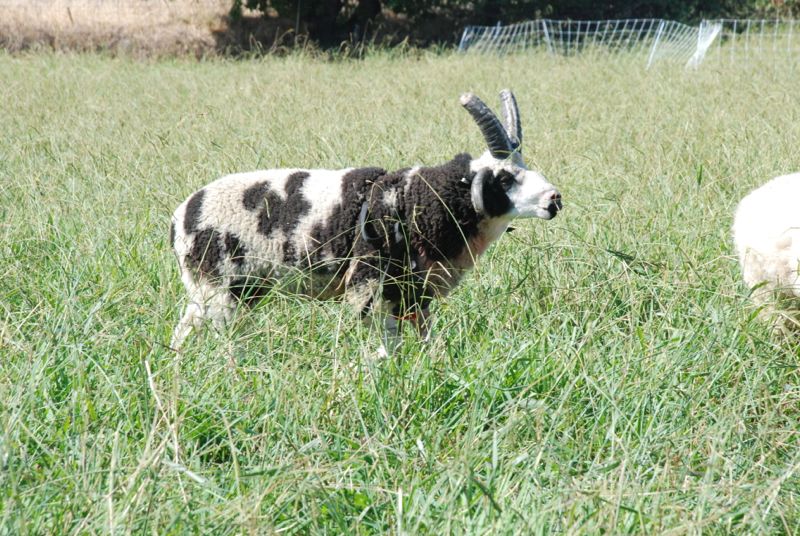
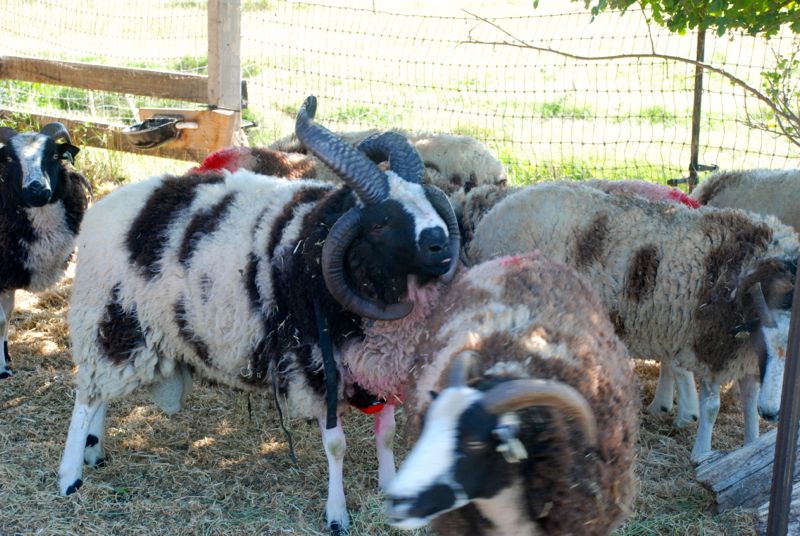 Miller, with 9 ewes, had no problem figuring it out. Each ram wears a marking harness so that I know when each ewe is bred. I will change the markers to another color after two weeks. If the ewes are marked again then there may be a problem with ram fertility.
Miller, with 9 ewes, had no problem figuring it out. Each ram wears a marking harness so that I know when each ewe is bred. I will change the markers to another color after two weeks. If the ewes are marked again then there may be a problem with ram fertility. 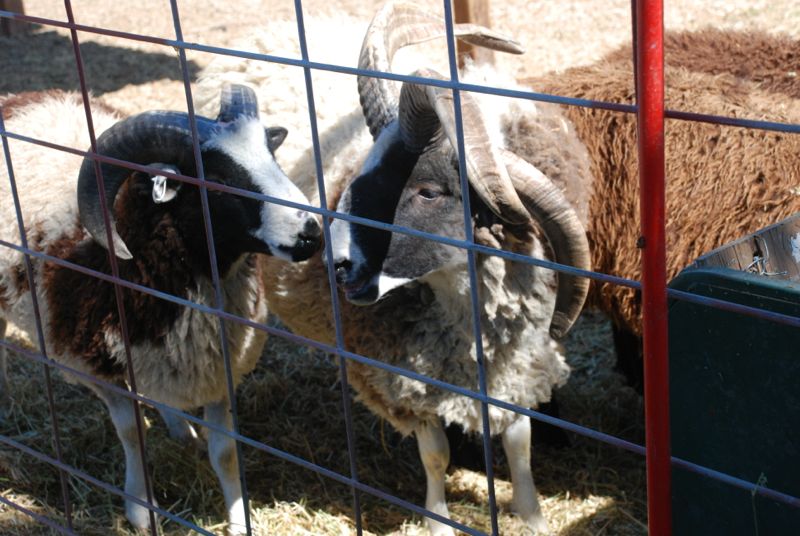 Presley is another adult ram but I don't plan to use him because he is closely related to the others. (He is for sale.) He was hopeful when I moved him to another pen, but he gave up after finding that there were only ram lambs.
Presley is another adult ram but I don't plan to use him because he is closely related to the others. (He is for sale.) He was hopeful when I moved him to another pen, but he gave up after finding that there were only ram lambs. 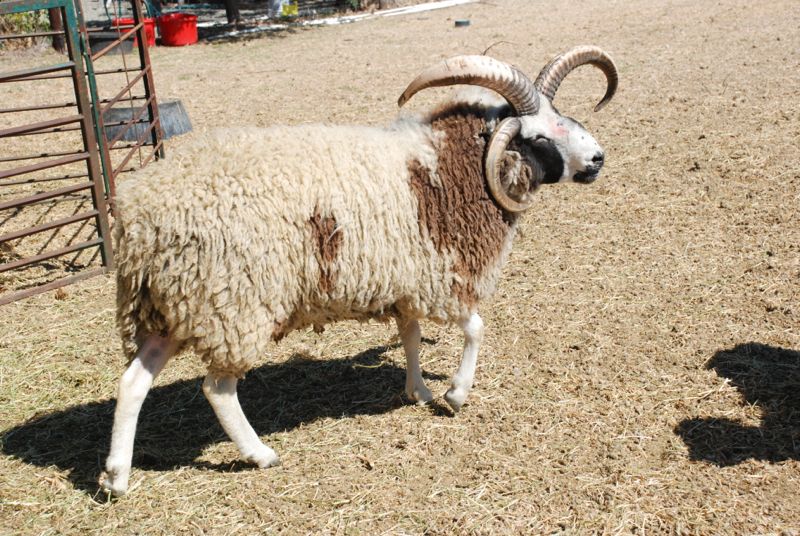 I wanted to use one of this year's ram lambs for the fourth group of ewes. I had a hard time choosing among the rams I have saved. My first choice was a four-horn ram lamb who I think has promise and also placed well at the summer shows. Unfortunately, he was very sick with bluetongue (insect transmitted virus common in the fall) a few weeks ago. He pulled through (I lost two others) but with the 106+ temperature I can not be sure that he is fertile. He may have his chance next year, but this year I needed to find another ram.
I wanted to use one of this year's ram lambs for the fourth group of ewes. I had a hard time choosing among the rams I have saved. My first choice was a four-horn ram lamb who I think has promise and also placed well at the summer shows. Unfortunately, he was very sick with bluetongue (insect transmitted virus common in the fall) a few weeks ago. He pulled through (I lost two others) but with the 106+ temperature I can not be sure that he is fertile. He may have his chance next year, but this year I needed to find another ram. 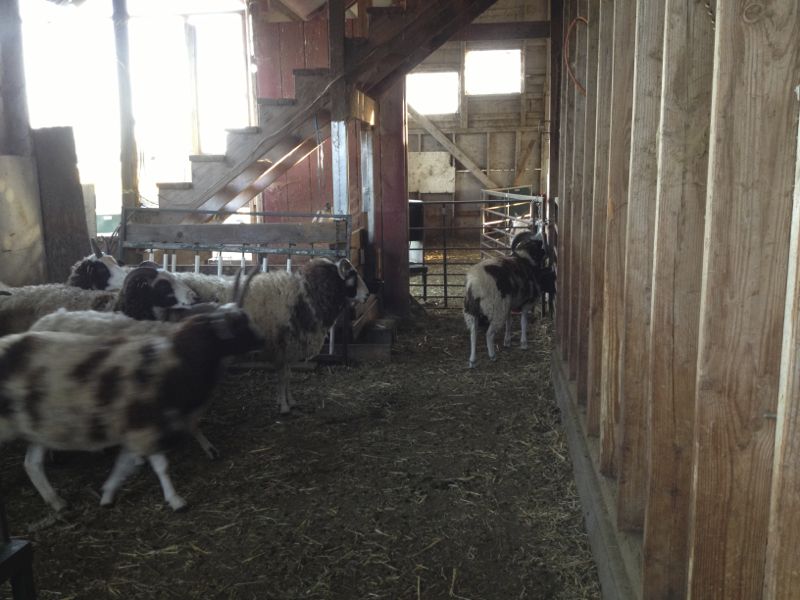 I chose a two-horn ram whose wool I like. He wasn't happy about the whole thing. The ewes were a little rough on him the first day. I could just hear the comments under their breaths "little pipsqueak", "a lot of gall thinking he can handle us", "take that" (rib-bashing)
I chose a two-horn ram whose wool I like. He wasn't happy about the whole thing. The ewes were a little rough on him the first day. I could just hear the comments under their breaths "little pipsqueak", "a lot of gall thinking he can handle us", "take that" (rib-bashing)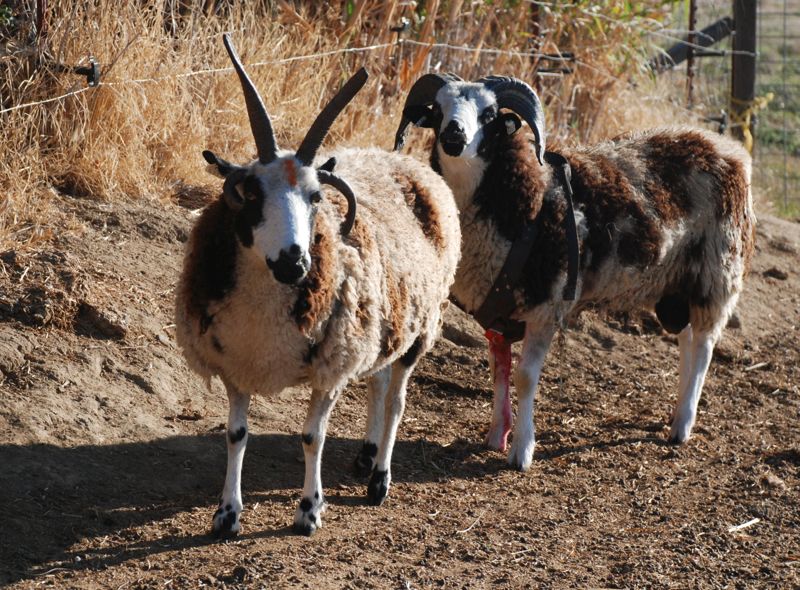 There were times when I thought that this ram would do OK, but most of the time I found him lying down away from the ewes. I started to wonder if he also had bluetongue because he acted so depressed and showed no interest in food or the ewes. I finally removed him and chose a second ram. Now I think that he just wasn't ready to breed and the ewes knew that and beat him up. Most Jacob rams are ready to breed at six months, but not always.
There were times when I thought that this ram would do OK, but most of the time I found him lying down away from the ewes. I started to wonder if he also had bluetongue because he acted so depressed and showed no interest in food or the ewes. I finally removed him and chose a second ram. Now I think that he just wasn't ready to breed and the ewes knew that and beat him up. Most Jacob rams are ready to breed at six months, but not always. 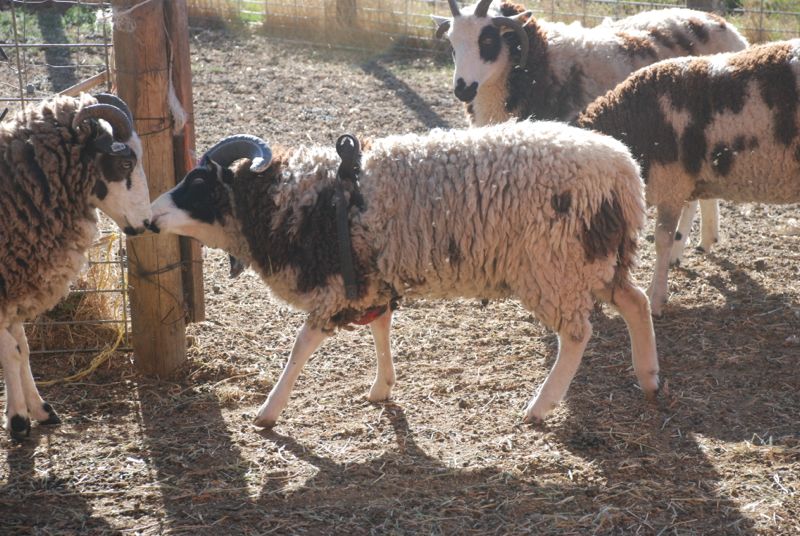 This guy seems to be interested and ready to go.
This guy seems to be interested and ready to go.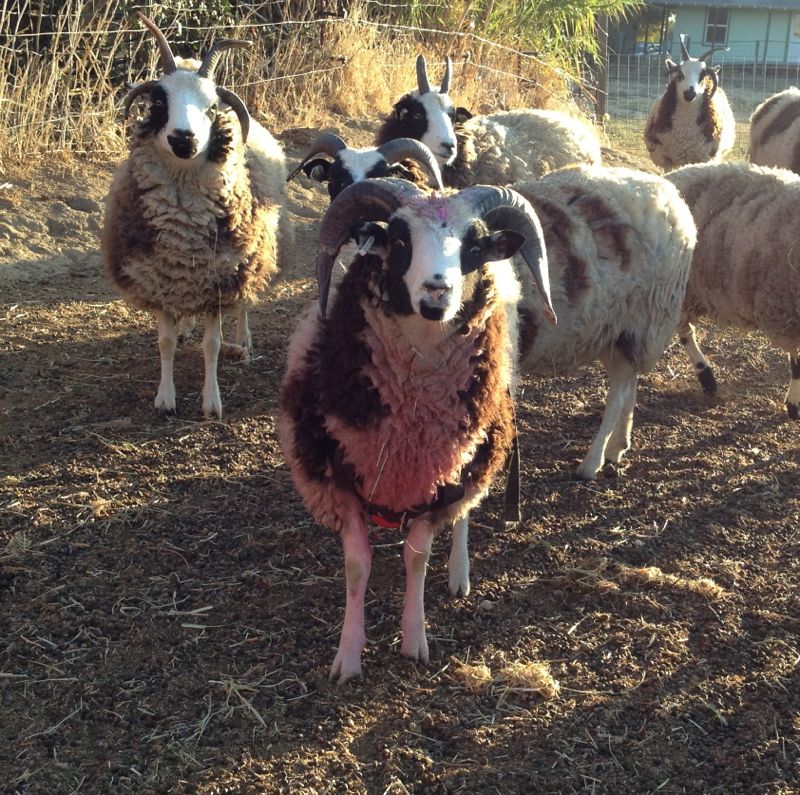 He weighs less than all these ewes but that doesn't seem to bother him (or the ewes).
He weighs less than all these ewes but that doesn't seem to bother him (or the ewes).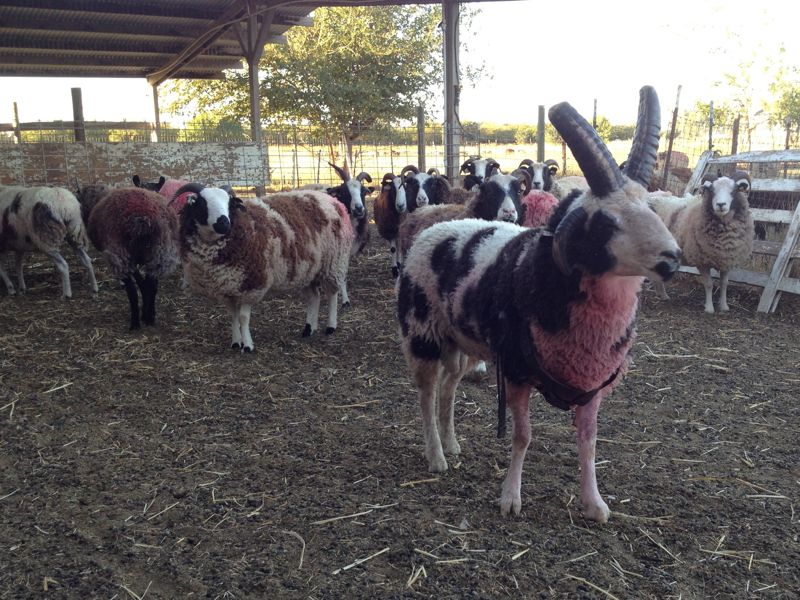 Hendrix has been with his ewes for a week and seven are marked.
Hendrix has been with his ewes for a week and seven are marked.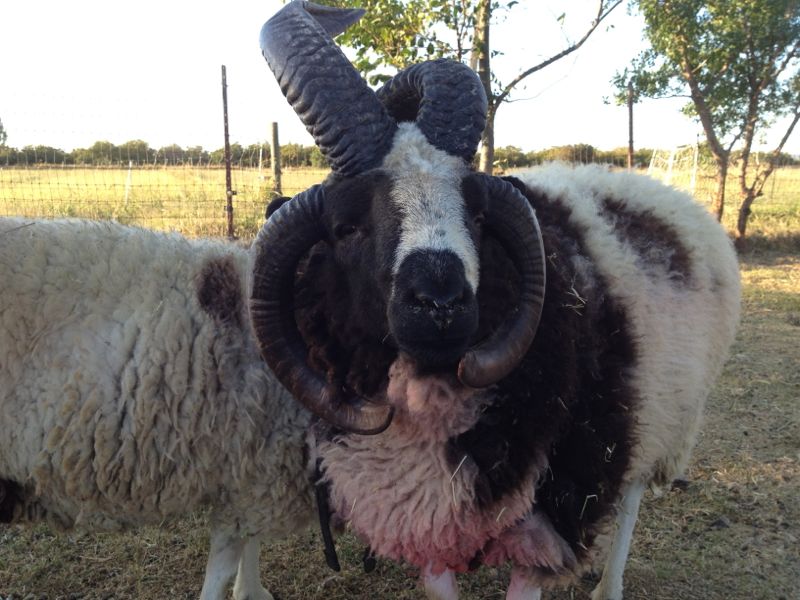 Miller has five marked.
Miller has five marked.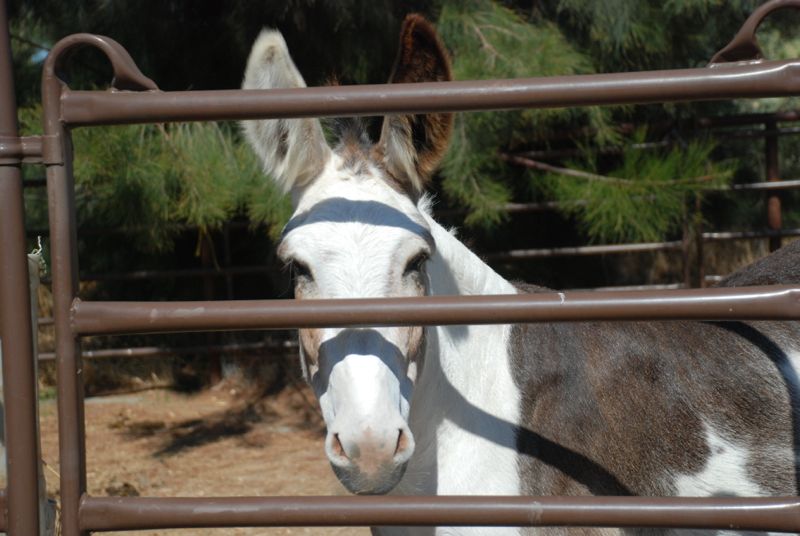 Poor Amaryllis is exiled for the moment. I don't want the rams fighting through the fence so they are all in areas with no fence-line contact. Besides the four ram groups there are the non-breeding ewes (spring lambs, summer-lambing ewes, cull lambs) and non-breeding rams. That doesn't leave much space for Amaryllis since she has to be on a grass hay diet without pasture (she broke the grazing muzzle) or alfalfa. So she has her own corral for the moment.
Poor Amaryllis is exiled for the moment. I don't want the rams fighting through the fence so they are all in areas with no fence-line contact. Besides the four ram groups there are the non-breeding ewes (spring lambs, summer-lambing ewes, cull lambs) and non-breeding rams. That doesn't leave much space for Amaryllis since she has to be on a grass hay diet without pasture (she broke the grazing muzzle) or alfalfa. So she has her own corral for the moment.
Sheepy Morning
/
 The sheep follow me, always hopeful that I'll switch them to a new paddock.
The sheep follow me, always hopeful that I'll switch them to a new paddock.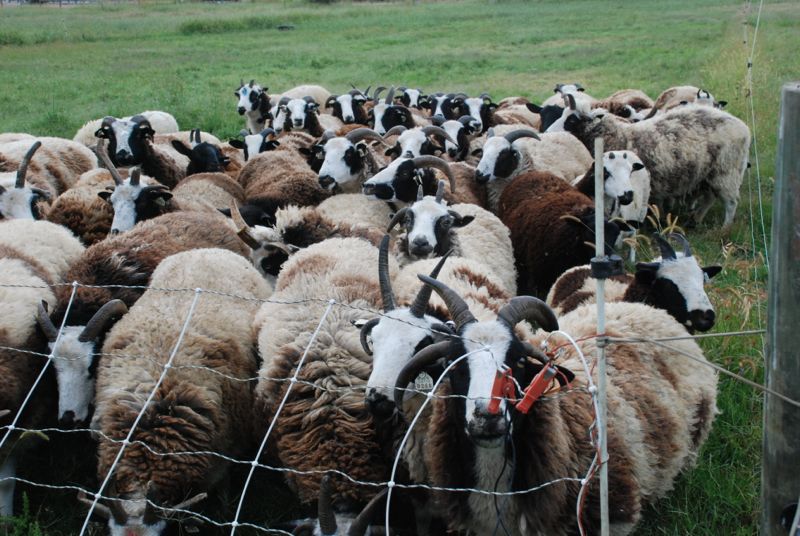 They are in luck this morning.
They are in luck this morning.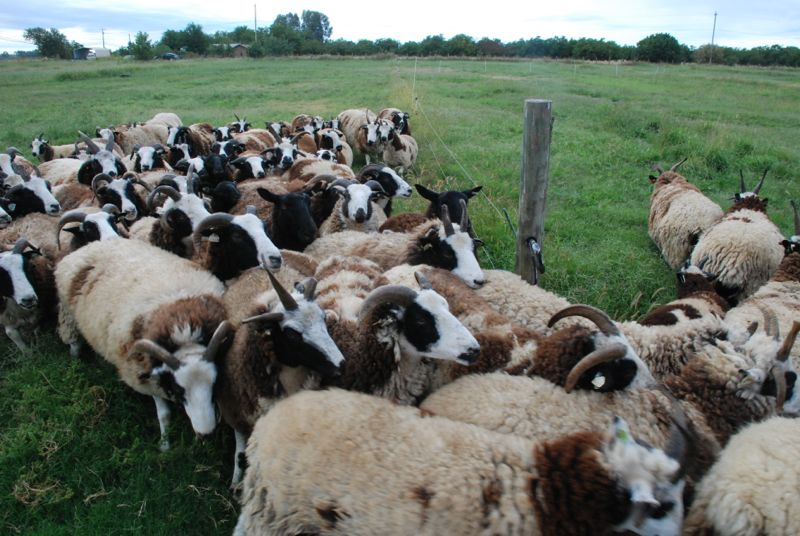
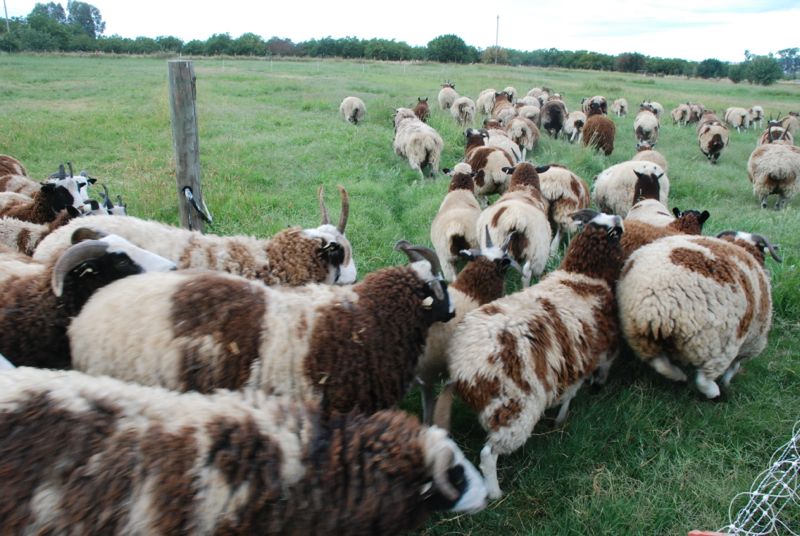
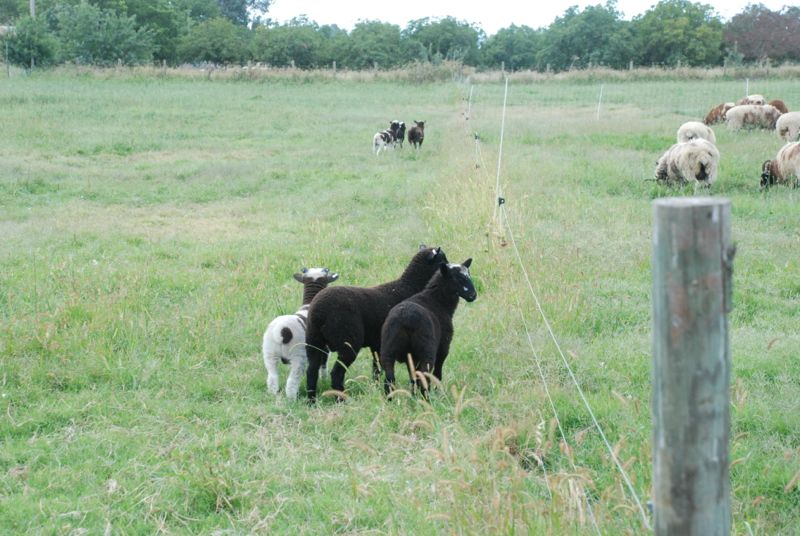 The young lambs don't always figure out going around the post.
The young lambs don't always figure out going around the post.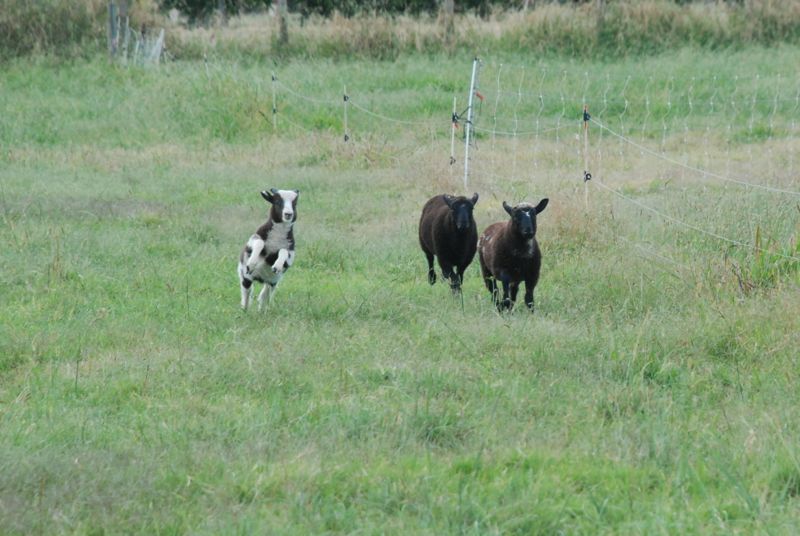
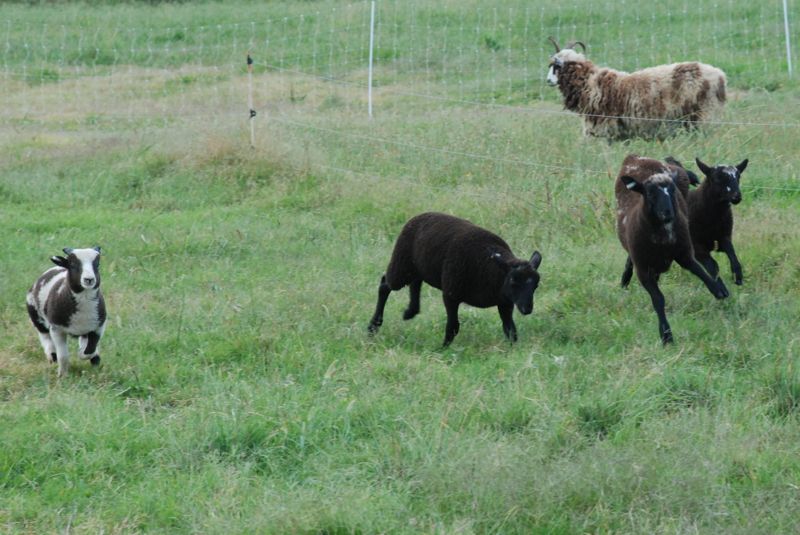
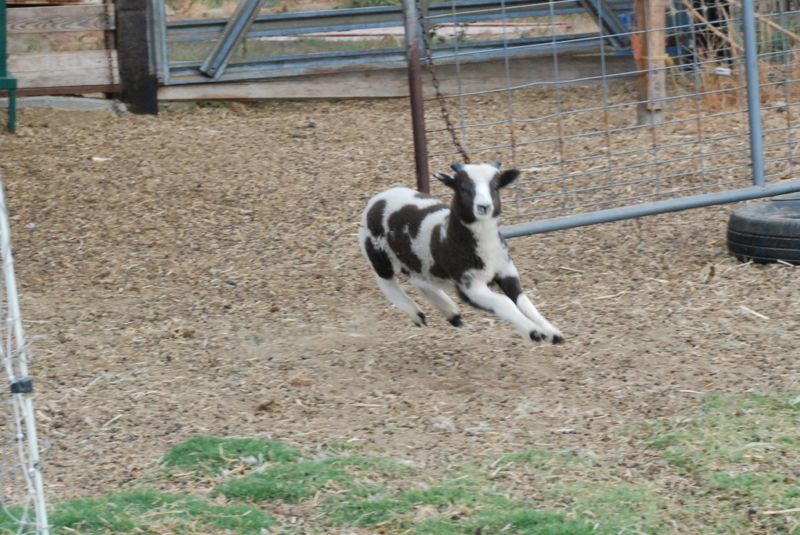
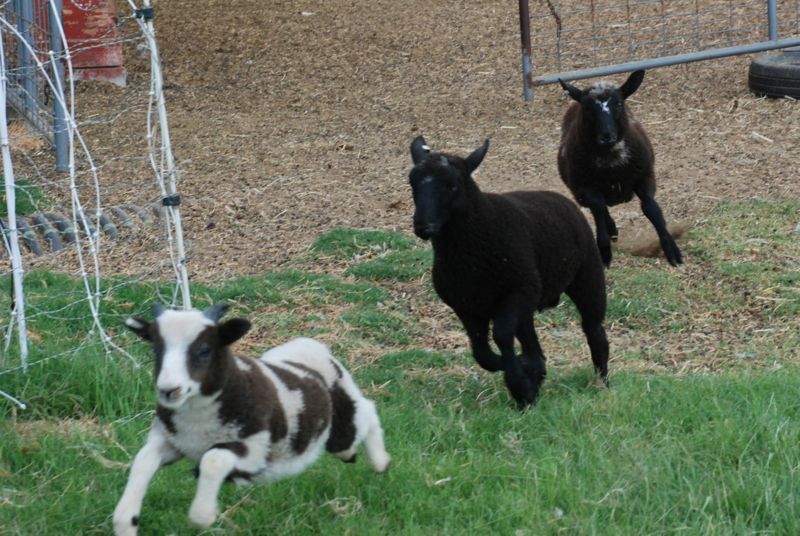 Now they're going the right way.
Now they're going the right way. 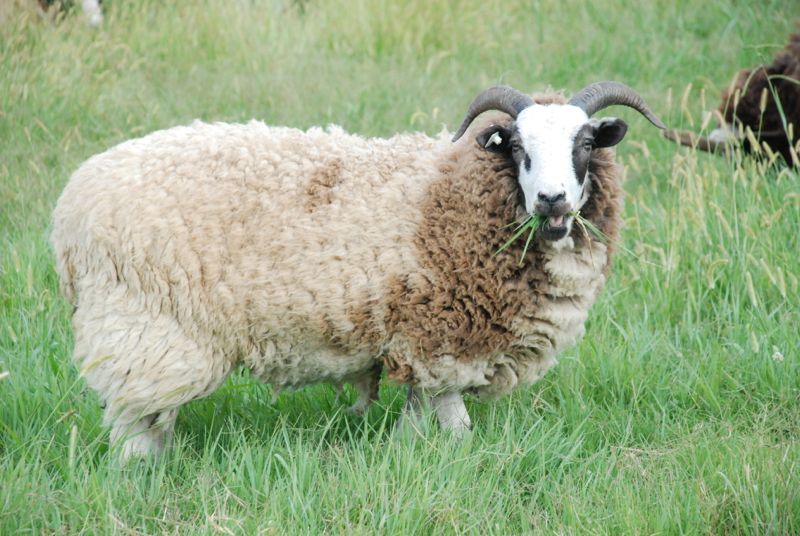 Sheep aren't the only thing in the pasture.
Sheep aren't the only thing in the pasture.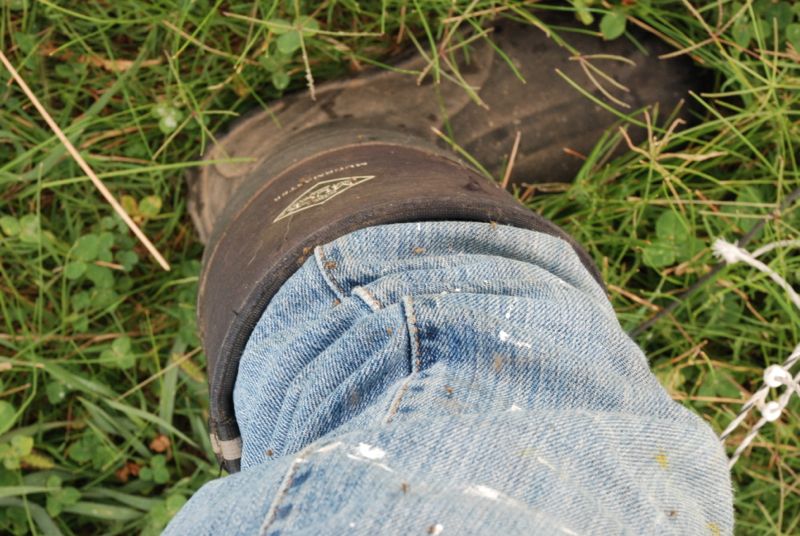 Can you tell what I'm looking at?
Can you tell what I'm looking at?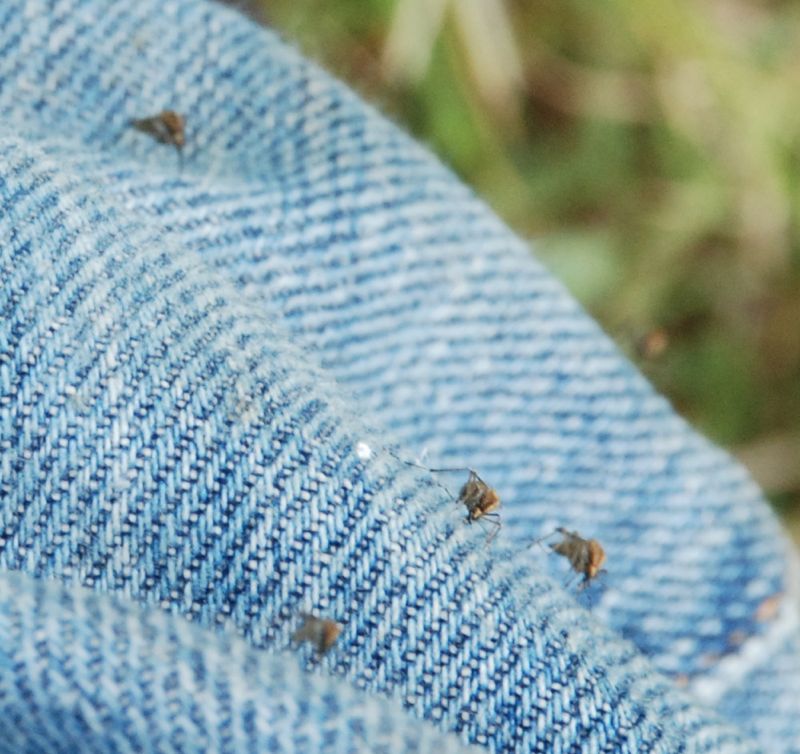 The mosquitoes haven't been too bad this year, but that has changed now. The pasture mosquitoes are out in force. I don't go out in the pasture without my long sleeved "mosquito shirt".
The mosquitoes haven't been too bad this year, but that has changed now. The pasture mosquitoes are out in force. I don't go out in the pasture without my long sleeved "mosquito shirt".
Real life farming is not always pretty
/DISCLAIMER: You wanted it real, right? At least that's what I hear from some people who say they want to know what it's like to raise sheep. So this post is real. No pretty pictures; in fact, some down-right yucky ones. A few sad stories. It's the other part of life on the farm. Skip this post if you don't want to know. Over the last couple of months I have had to deal with several relatively minor veterinary issues. If I had to call a vet for each of these I might as well give up raising sheep. There are some things you just have to do on your own. But also note that if I hadn't dealt with these issues as they arose they would have become much more serious. As it is, they are mostly nuisances, taking time away from other things on the never-ending list of things-to-do.
Problem: Ram horn growing too close to jaw.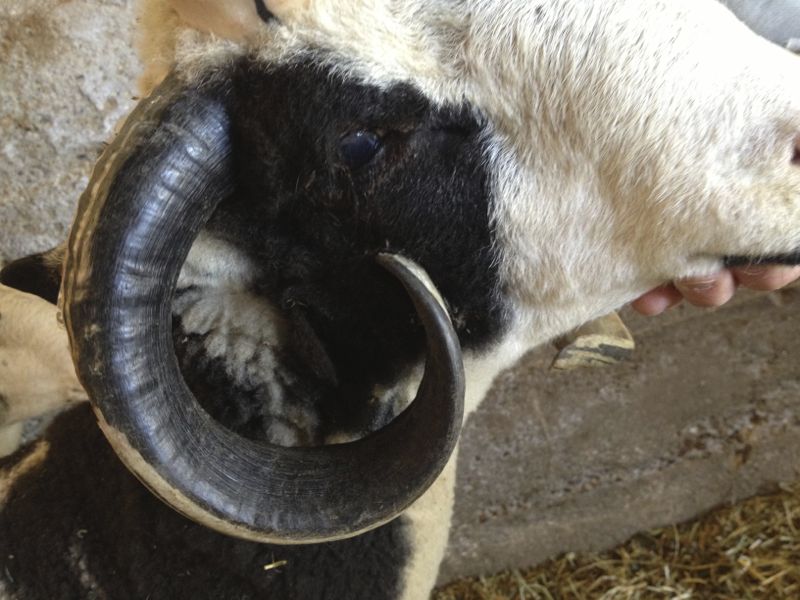 It doesn't look too bad here but...
It doesn't look too bad here but...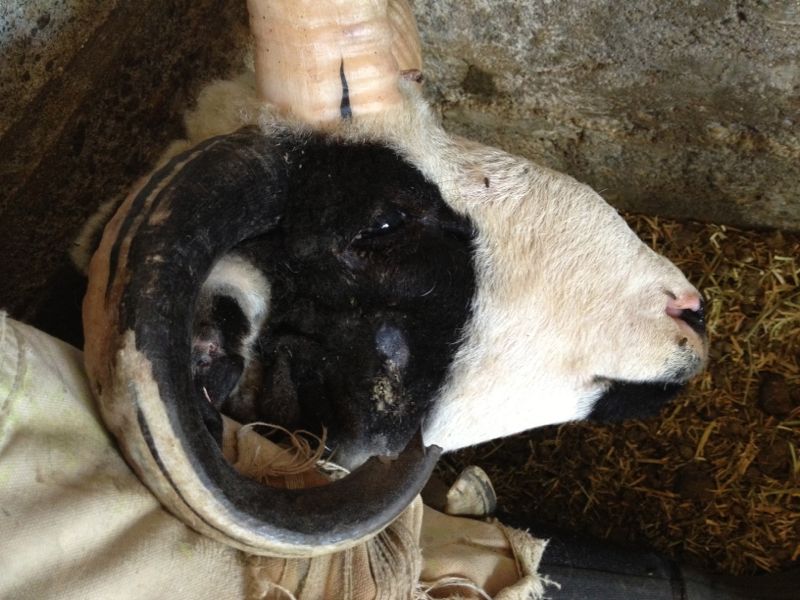 ...here is how it looked after I cut the horn. There was already an open sore on the skin which is the perfect place for infection and fly strike to start. This ram was never registered and destined for butcher because of his horns and his personality. In fact I had counted on using his very cool striped horns for dozens of fabulous buttons. The sad story is that his horns were lost at the butcher facility and no one seems to know what happened to them. Discouraging.
...here is how it looked after I cut the horn. There was already an open sore on the skin which is the perfect place for infection and fly strike to start. This ram was never registered and destined for butcher because of his horns and his personality. In fact I had counted on using his very cool striped horns for dozens of fabulous buttons. The sad story is that his horns were lost at the butcher facility and no one seems to know what happened to them. Discouraging.
Problem: Ram horn growing into skull.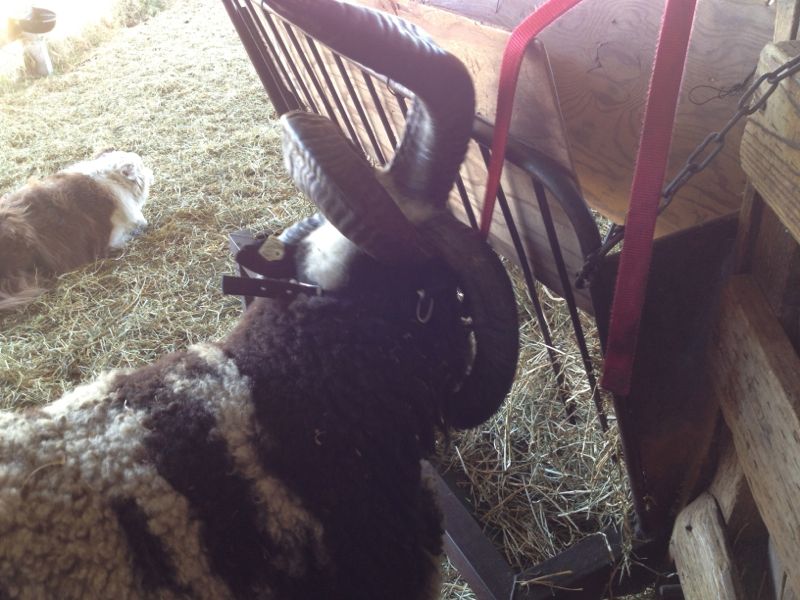 This is Miller. He started life out with nice looking horns, but after one broke it started to grow in the wrong direction. (Those photos will be another post.) This is looking down and you can see the horn going into the top of his skull behind his ear.
This is Miller. He started life out with nice looking horns, but after one broke it started to grow in the wrong direction. (Those photos will be another post.) This is looking down and you can see the horn going into the top of his skull behind his ear.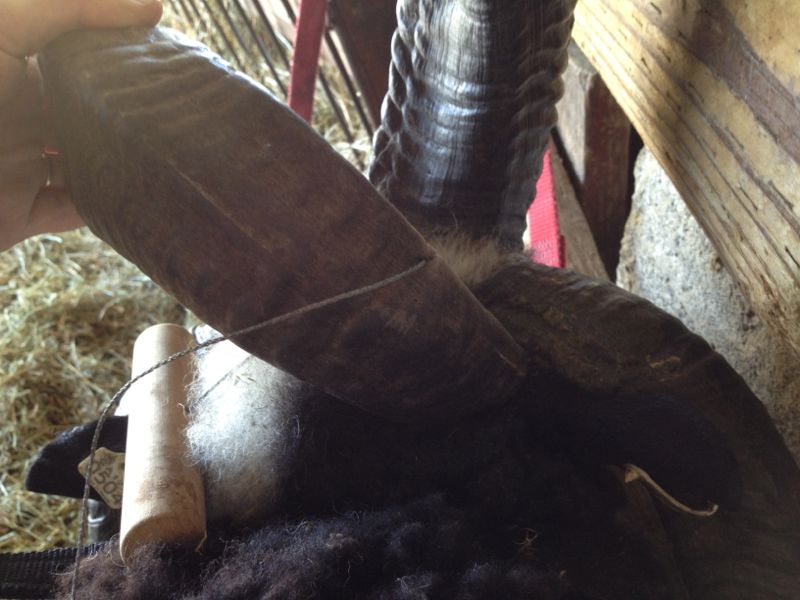 This is the kind of saw that you use to cut horns. It's a wire piece with two handles. I can't find mine so this belongs to a friend (thanks, Jackie).
This is the kind of saw that you use to cut horns. It's a wire piece with two handles. I can't find mine so this belongs to a friend (thanks, Jackie). 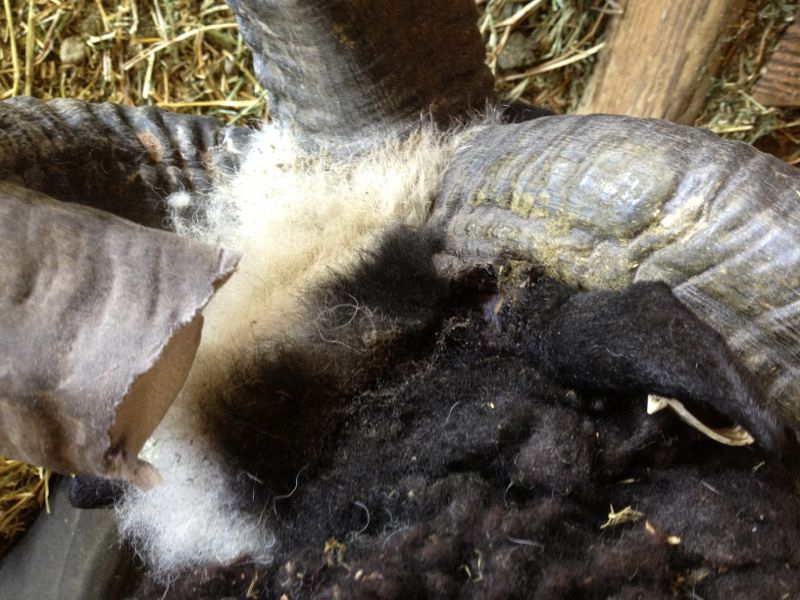 Here is a close up after cutting the horn. It's hard to tell but the horn had already gone into the flesh making an open wound.
Here is a close up after cutting the horn. It's hard to tell but the horn had already gone into the flesh making an open wound.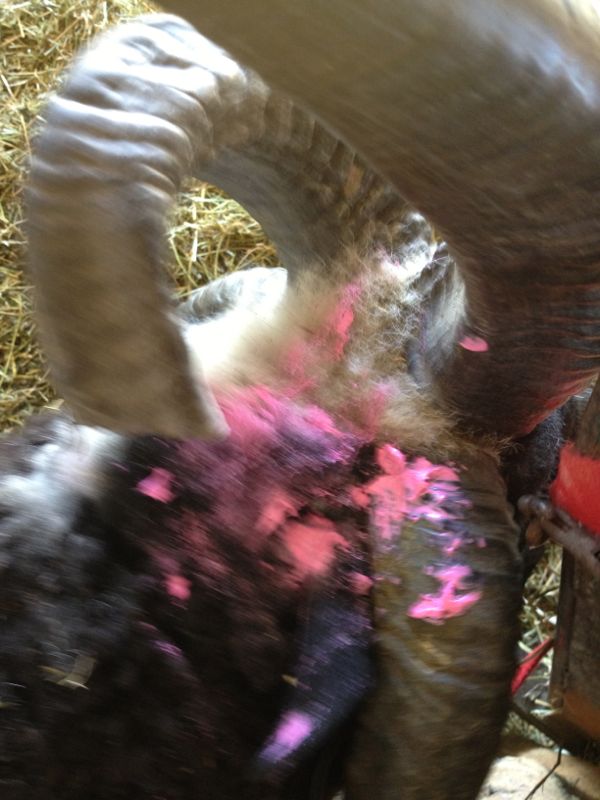 This is the same view covered with Swat, an product that keeps the flies away. It comes in clear or pink. I like pink because I can see that it is still there. Sorry boys. I took these photos in mid-June. It's early August and this horn needs to be cut again. I just looked up the wire saw on-line because I need to buy one. I read that the wire gets dull with use. No wonder that when I tried to cut this horn again I couldn't get anywhere. I will buy two of these wire saws (with the wire that can be replaced) and give one to Jackie.
This is the same view covered with Swat, an product that keeps the flies away. It comes in clear or pink. I like pink because I can see that it is still there. Sorry boys. I took these photos in mid-June. It's early August and this horn needs to be cut again. I just looked up the wire saw on-line because I need to buy one. I read that the wire gets dull with use. No wonder that when I tried to cut this horn again I couldn't get anywhere. I will buy two of these wire saws (with the wire that can be replaced) and give one to Jackie.
Problem: Ewe depressed (not in the psychiatric way), not eating, getting worse quickly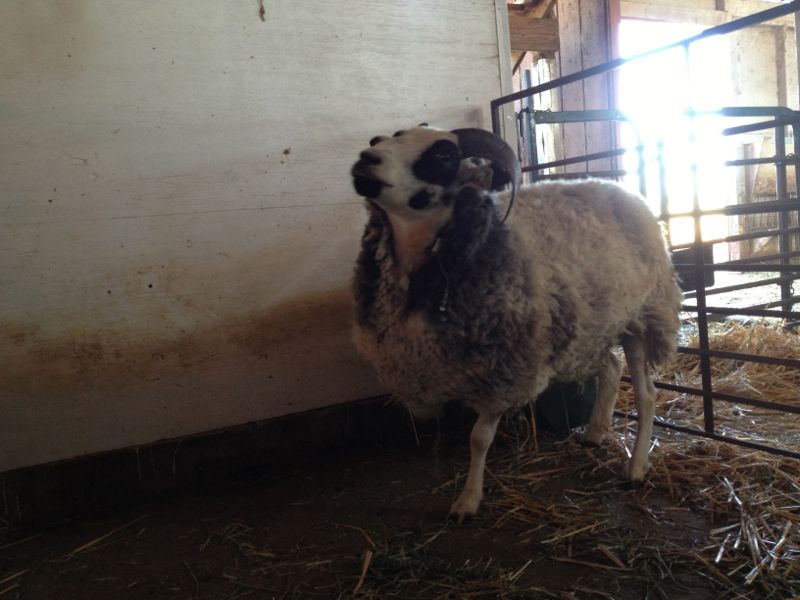 One morning I found Hattie, an otherwise healthy 3 year old ewe who was in a group of ewes I had recently weaned, not wanting to eat and not responding to much I did. I was teaching a class that morning and couldn't do much other than put her in her own pen and get back to her later.
One morning I found Hattie, an otherwise healthy 3 year old ewe who was in a group of ewes I had recently weaned, not wanting to eat and not responding to much I did. I was teaching a class that morning and couldn't do much other than put her in her own pen and get back to her later.
Do you see Hattie's posture in the photo above? That is known as star-gazing and sometimes is a result of a thiamine deficiency. I didn't think Hattie could see--not a problem with the eyes, but a neurologic problem. From Sheep101:
Polioencephalomalacia (PEM, CCN, polio, cerebrocortical necrosis) Polioencephalomalacia is a disease of the central nervous system, caused by a vitamin B1 (thiamine) deficiency. Since the rumen manufactures B vitamins, polio is not caused by insufficient thiamine, but rather the inability to utilize it. The most common symptom of polio is blindness and star-gazing. Polio most commonly occurs in lambs that are consuming high concentrate diets. Polio can also occur in sheep that consume plants that contain a thiamase inhibitor. Polio symptoms mimic other neurological disease conditions, but a differential diagnosis can be made based on the animals' response to injections of vitamin B1.
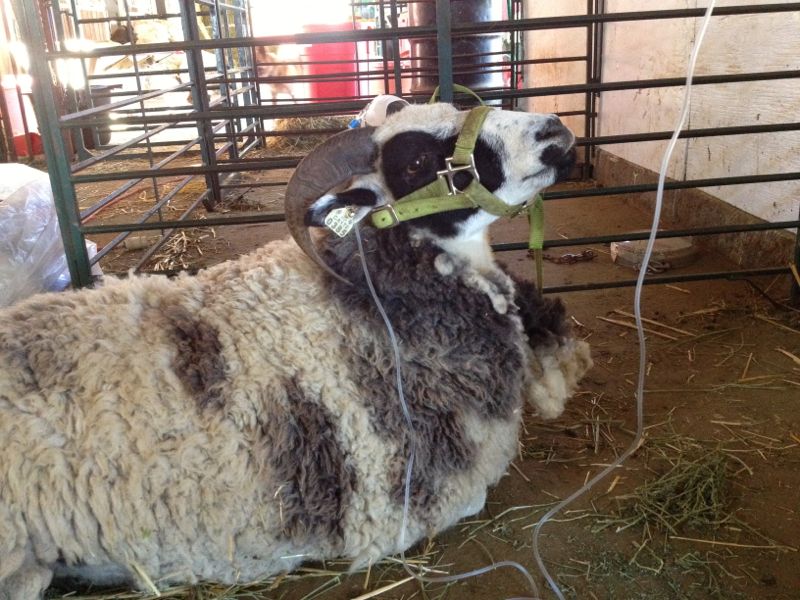 I knew that an injection of thiamine would clear this up if that was the problem so I called my vet (Dr. M) to get some. I gave Hattie the injection and saw no response. I talked to Dr. M and she asked if she could come out and bring some students who were helping her. (She said that if nothing else, I would be adding to the students' experience.) In the long run, we gave Hattie thiamin, calcium, and glucose to no avail. She died within a few hours. I took her to the Food Animal Health and Safety Lab at UC Davis and the necropsy report showed copper toxicity. That could also be the subject of another post someday. There have been a few other deaths associated with Cu toxicity and I don't know the source of the Cu.
I knew that an injection of thiamine would clear this up if that was the problem so I called my vet (Dr. M) to get some. I gave Hattie the injection and saw no response. I talked to Dr. M and she asked if she could come out and bring some students who were helping her. (She said that if nothing else, I would be adding to the students' experience.) In the long run, we gave Hattie thiamin, calcium, and glucose to no avail. She died within a few hours. I took her to the Food Animal Health and Safety Lab at UC Davis and the necropsy report showed copper toxicity. That could also be the subject of another post someday. There have been a few other deaths associated with Cu toxicity and I don't know the source of the Cu.
Problem: Ram lamb with broken horn (and lots of blood and flies).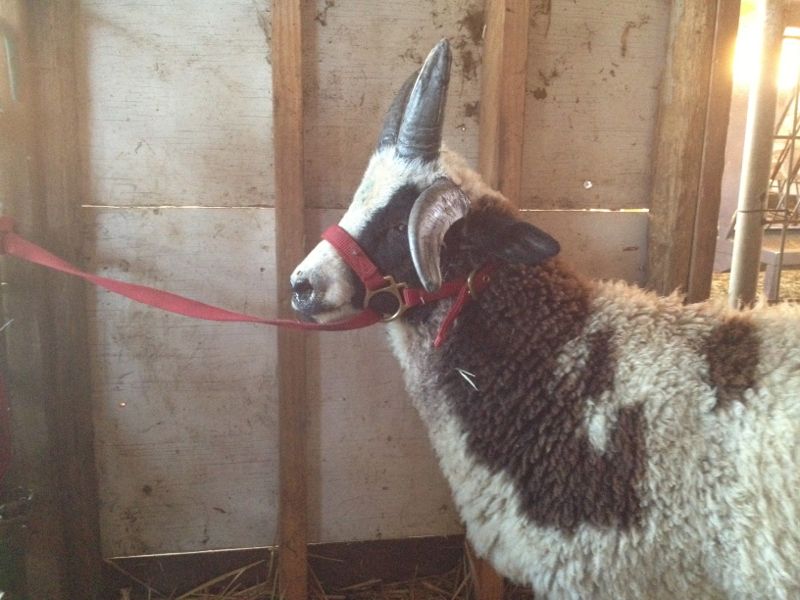 That is not the normal position of a horn. The lambs often break horns when they play and fight, but they usually break the outer covering off the horn, leaving a bloody core. It's messy, but if you do nothing (except use Swat on the head to keep flies away) it will dry up and heal and the horn will continue to grow. But not this one.
That is not the normal position of a horn. The lambs often break horns when they play and fight, but they usually break the outer covering off the horn, leaving a bloody core. It's messy, but if you do nothing (except use Swat on the head to keep flies away) it will dry up and heal and the horn will continue to grow. But not this one.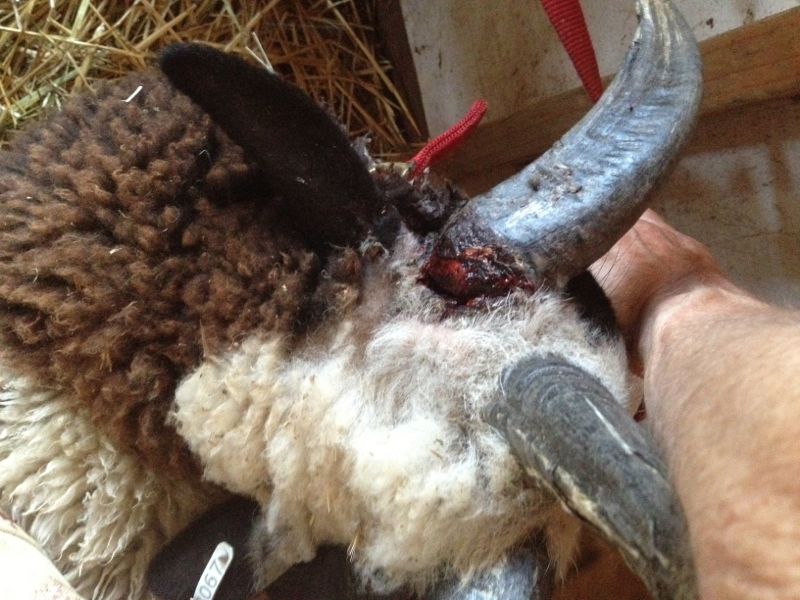 This is looking down on the ram's head. The lower horn broke at the base of the core which leaves a hole in the head. In this case you can't just put the horn back and expect it to reattach...and you have to be careful of infection and fly strike. I ended up taking this horn off entirely and then having to cauterize the wound to stop the bleeding.
This is looking down on the ram's head. The lower horn broke at the base of the core which leaves a hole in the head. In this case you can't just put the horn back and expect it to reattach...and you have to be careful of infection and fly strike. I ended up taking this horn off entirely and then having to cauterize the wound to stop the bleeding. 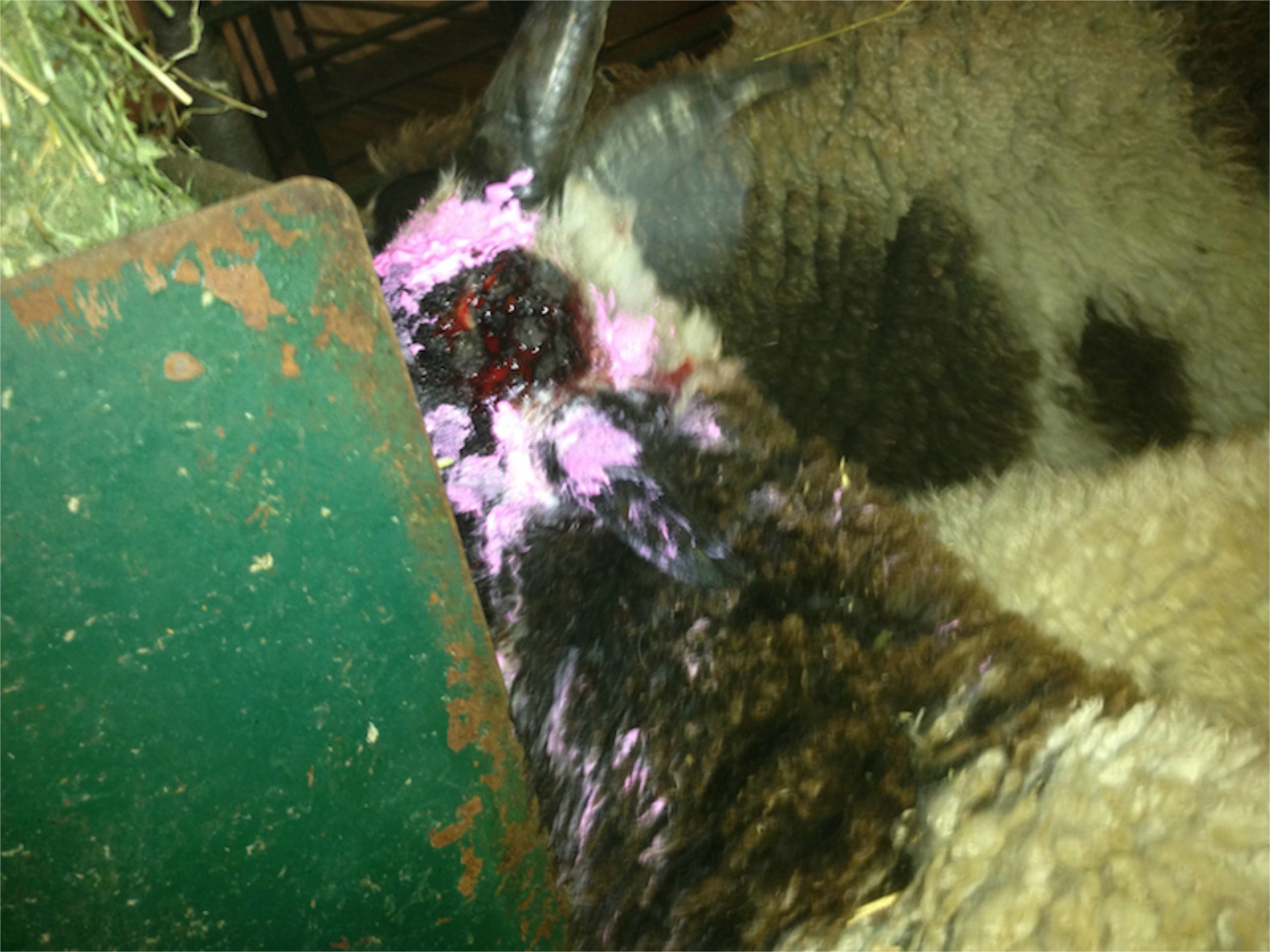 Swat again. I kept the ram in a pen for a day with a fan blowing to hopefully keep the flies off. The second day I decided he was better off in the field instead of the barn. He is now a 3-horn ram and is in the butcher line-up.
Swat again. I kept the ram in a pen for a day with a fan blowing to hopefully keep the flies off. The second day I decided he was better off in the field instead of the barn. He is now a 3-horn ram and is in the butcher line-up.
Problem: Ram with swollen jaw.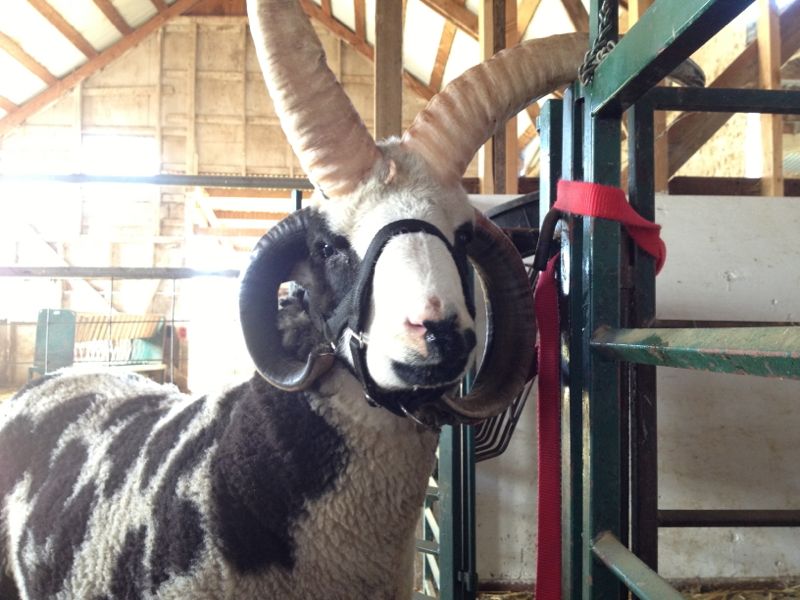 Remember this guy? This is the one from the first photos. I noticed a swollen jaw. My first thought is bottle jaw (caused by worm overload). On closer examination I saw something else.
Remember this guy? This is the one from the first photos. I noticed a swollen jaw. My first thought is bottle jaw (caused by worm overload). On closer examination I saw something else.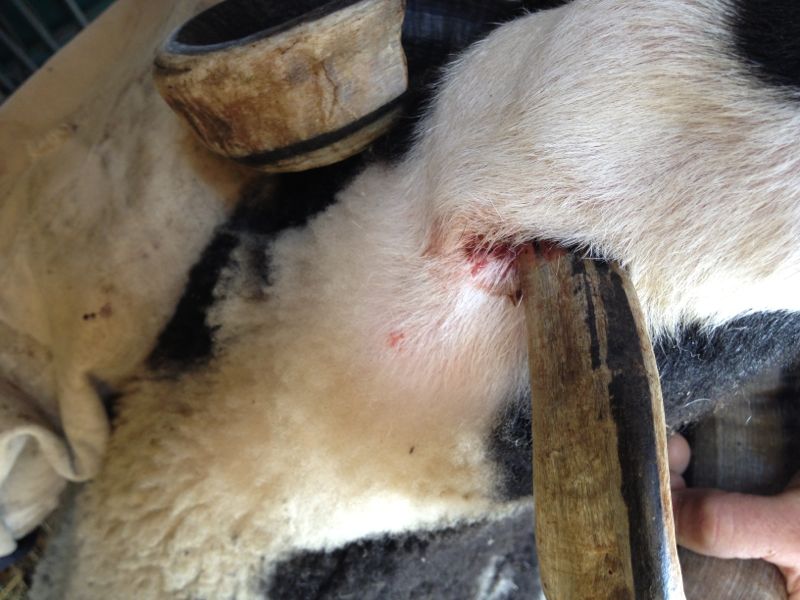 This is a view of the underside of the jaw.
This is a view of the underside of the jaw. 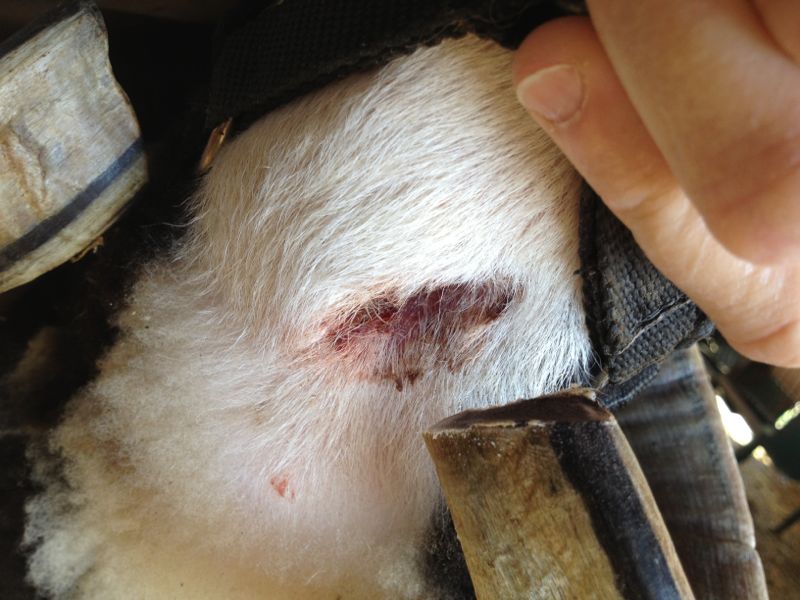 Here is the solution. Cut the horn, take a photo, then apply Swat.
Here is the solution. Cut the horn, take a photo, then apply Swat.
Problem: Ram with gooey eye.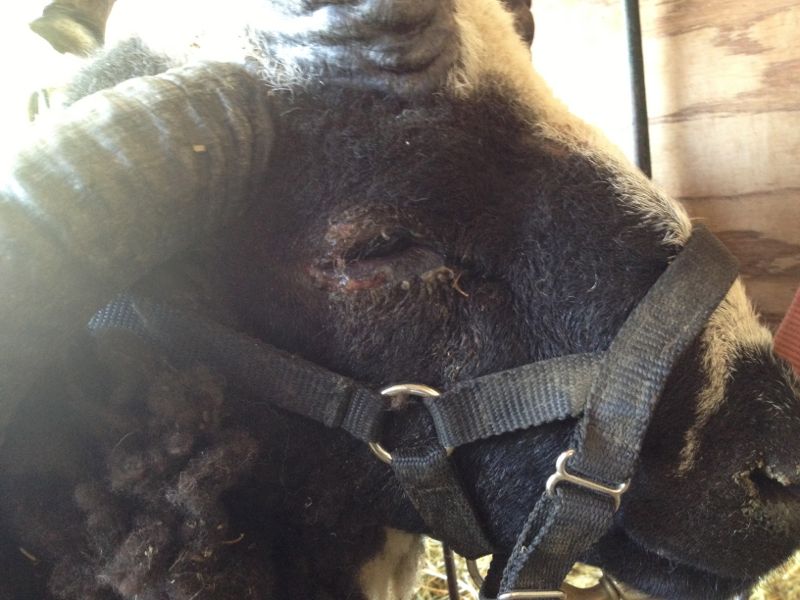 This is Miller again. I noticed eye looking gooey and let this one go for a little while. (It's more work to catch the rams.)
This is Miller again. I noticed eye looking gooey and let this one go for a little while. (It's more work to catch the rams.)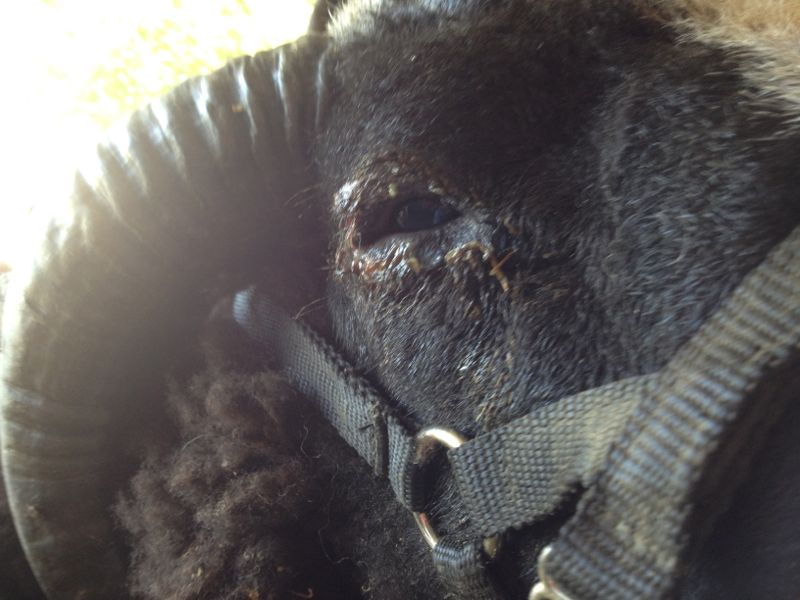 After I took a closer look I realized that the gooey eye was a result of a wound (probably from rams fighting) and not due to illness. It was not only gooey, but the lids were swollen.
After I took a closer look I realized that the gooey eye was a result of a wound (probably from rams fighting) and not due to illness. It was not only gooey, but the lids were swollen.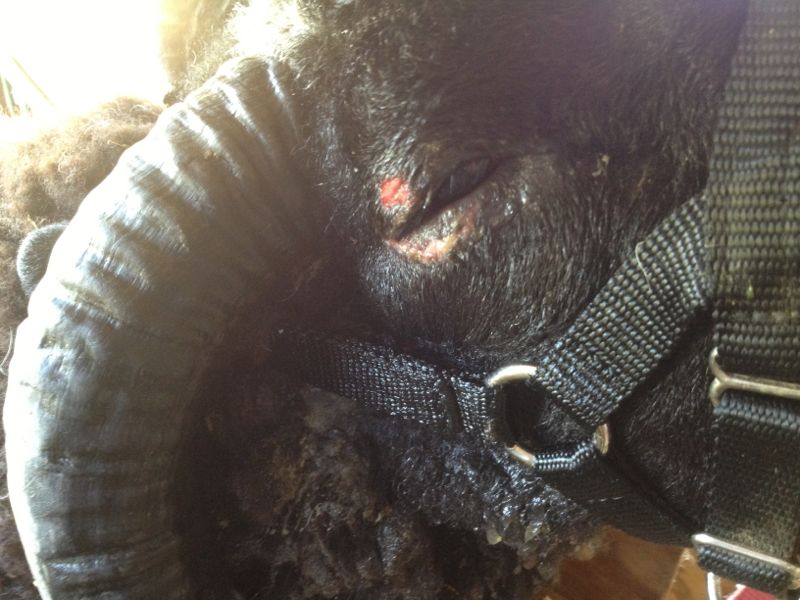 Clean up was in order.
Clean up was in order.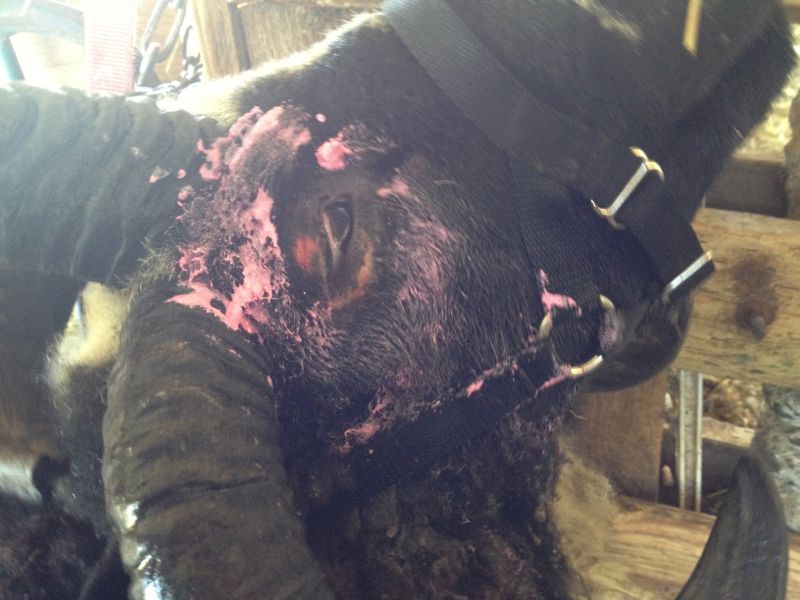 More clean up and then Swat.
More clean up and then Swat.
Problem: Ram with swollen jaw. 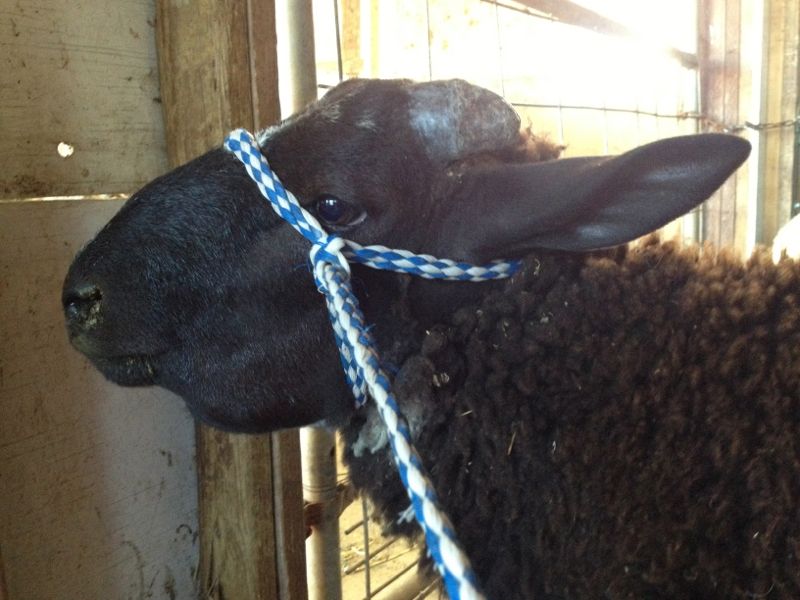 This ram lamb has no horns to speak of so that is not the problem. At first I thought this one was bottle jaw also and I think I treated him with worm medicine. The swelling never subsided and then started to change from an even swelling to something that felt more like an abcess. I just realized that I have no more photos of this one and that's probably a good thing. This was a big abcess, probably from a foxtail. I treated it and kept the ram away from the others, but I could never get it to clear up well. This ram went with the last batch of rams who were butchered.
This ram lamb has no horns to speak of so that is not the problem. At first I thought this one was bottle jaw also and I think I treated him with worm medicine. The swelling never subsided and then started to change from an even swelling to something that felt more like an abcess. I just realized that I have no more photos of this one and that's probably a good thing. This was a big abcess, probably from a foxtail. I treated it and kept the ram away from the others, but I could never get it to clear up well. This ram went with the last batch of rams who were butchered.
Back to pretty pictures next time.
Camera Shy Rams
/I was trying to take ram photos today. It's frustrating because they all stay in one cluster. I think part of that is due to the flies that bother the sheep this time of year. They stand together with their heads down.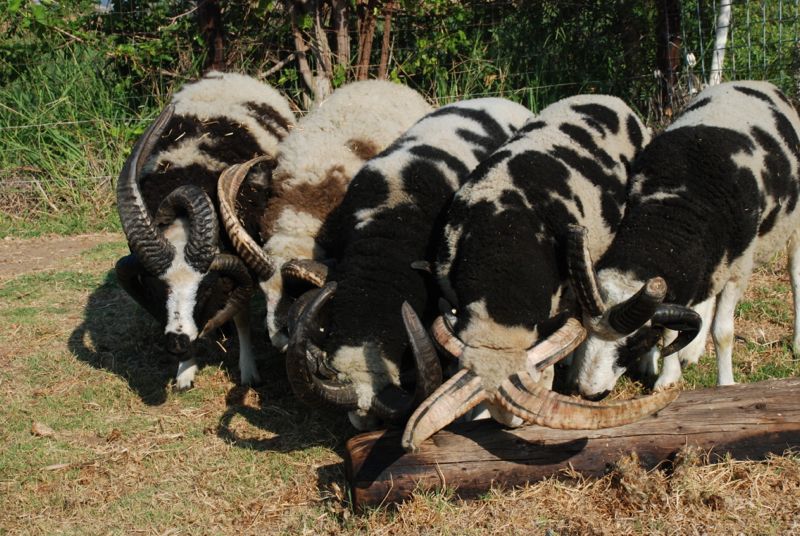 This isn't exactly the kind of photo I'm looking for.
This isn't exactly the kind of photo I'm looking for.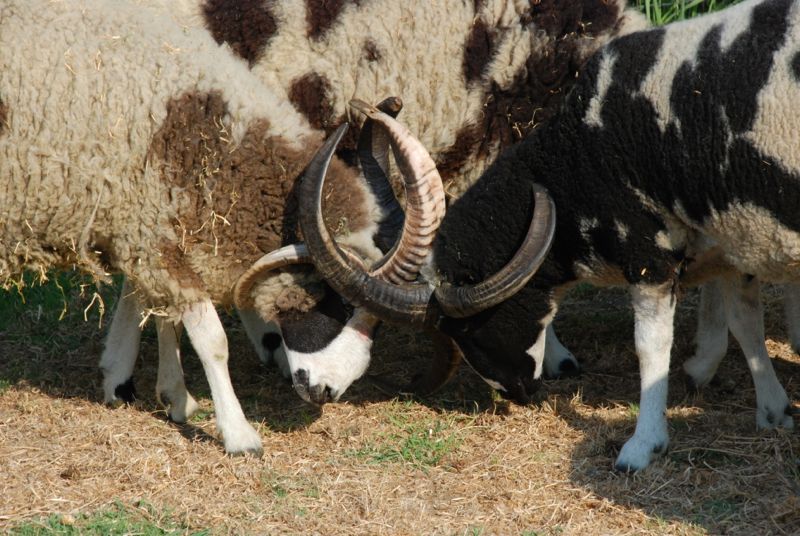 Or this.
Or this.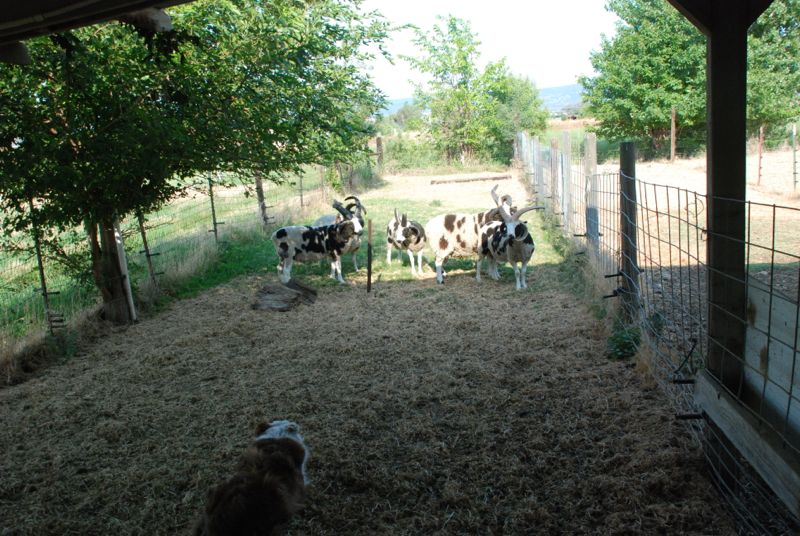 Rusty helps move them around.
Rusty helps move them around.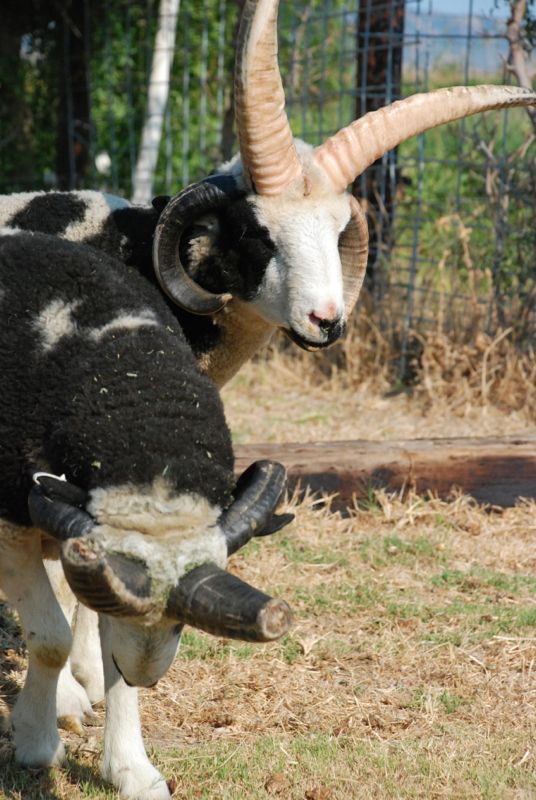 I had the best luck getting photos of this ram with the white horns, but he is not one I'm keeping for a couple of reasons. His lower right horn was already cut to keep it from growing into his cheek. The lower left is almost growing into his jaw and will need to be cut. He also shows no respect for people and as he gets older I think he could become a danger. Both rams in this photo are a year old, born at last year's State Fair in July. I am keeping Hendrix, the one with the black horns, at least for now. He just recently broke his top horns which is unusual for an adult ram.
I had the best luck getting photos of this ram with the white horns, but he is not one I'm keeping for a couple of reasons. His lower right horn was already cut to keep it from growing into his cheek. The lower left is almost growing into his jaw and will need to be cut. He also shows no respect for people and as he gets older I think he could become a danger. Both rams in this photo are a year old, born at last year's State Fair in July. I am keeping Hendrix, the one with the black horns, at least for now. He just recently broke his top horns which is unusual for an adult ram.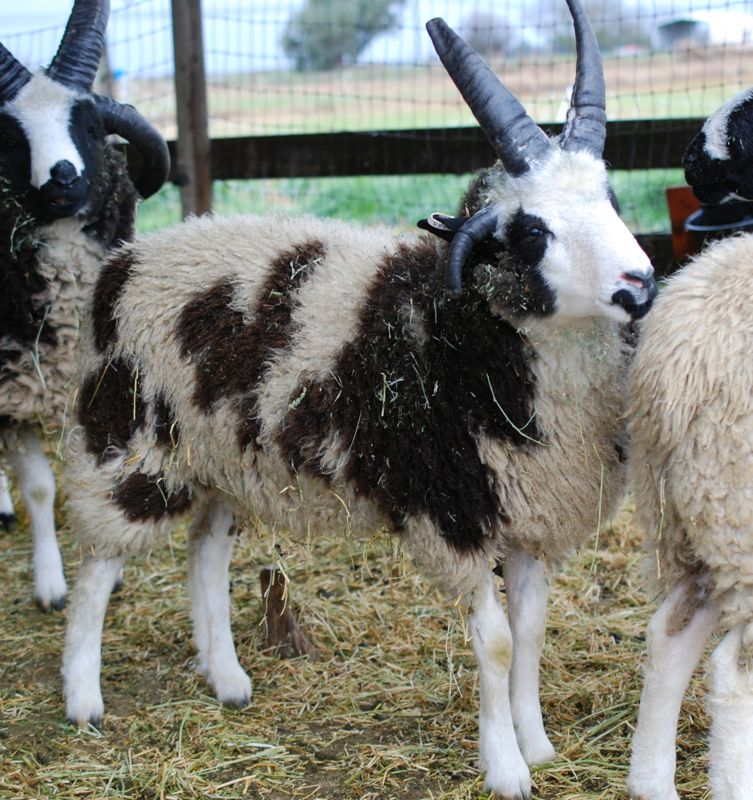 This is a photo of the same ram taken in February. Do you see those ridges on all the horns a few inches from his head? There must have been some kind of stress (illness, parasites??) at that point in growth that results in a weak place in the horns. Now, as he fights or...
This is a photo of the same ram taken in February. Do you see those ridges on all the horns a few inches from his head? There must have been some kind of stress (illness, parasites??) at that point in growth that results in a weak place in the horns. Now, as he fights or...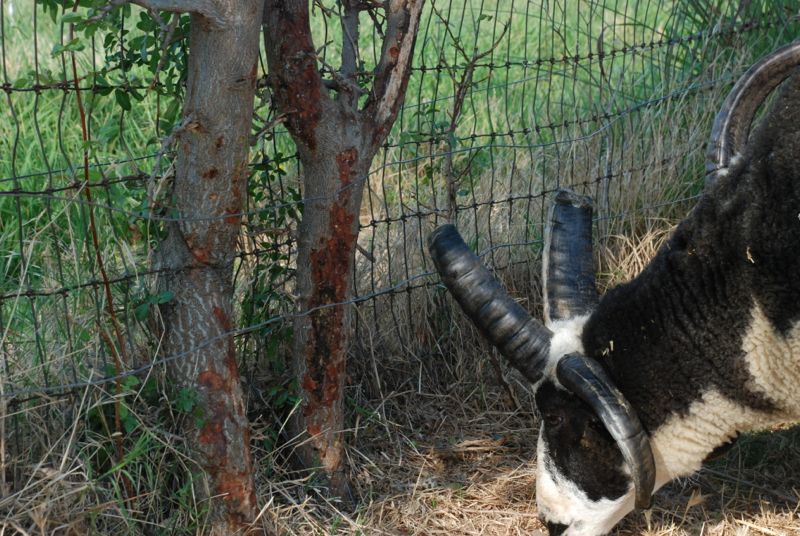 ...rubs on a tree (even with electric fence there...ACHHH!) those horns have broken off where they were weak. (Also notice how far out they have grown since February.)
While we're looking closely at ram horns...
...rubs on a tree (even with electric fence there...ACHHH!) those horns have broken off where they were weak. (Also notice how far out they have grown since February.)
While we're looking closely at ram horns...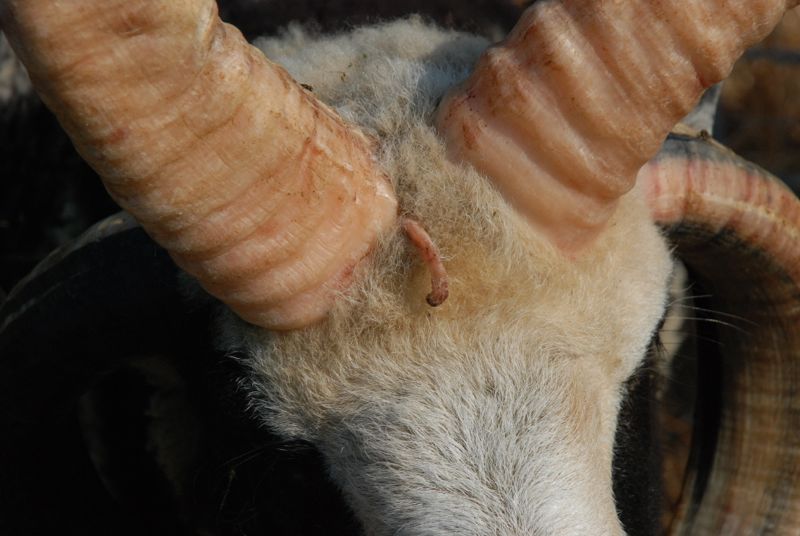 ... take a closer look at the ram with the white horns.
... take a closer look at the ram with the white horns.
So after dozens of photos this morning I didn't end up with the full body shots I had hoped for. I have a few head portraits.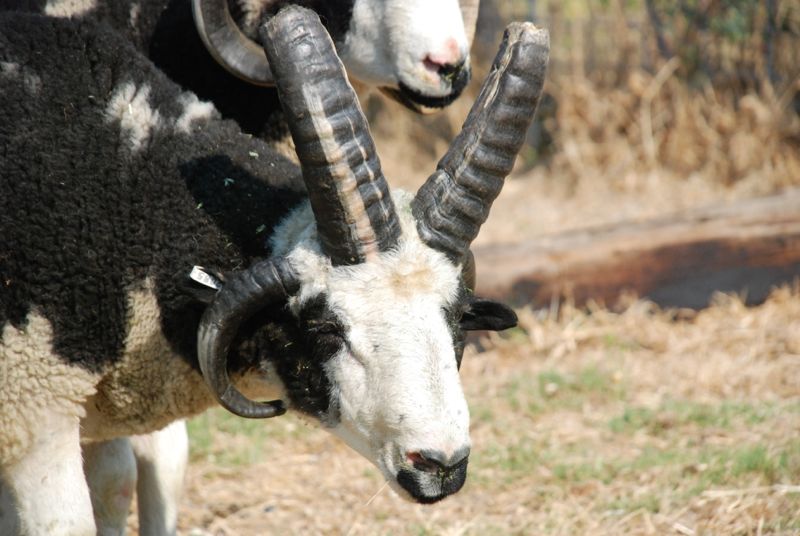 Hendrix (Mud Ranch's Hudson x Meridian Shelby)
Hendrix (Mud Ranch's Hudson x Meridian Shelby)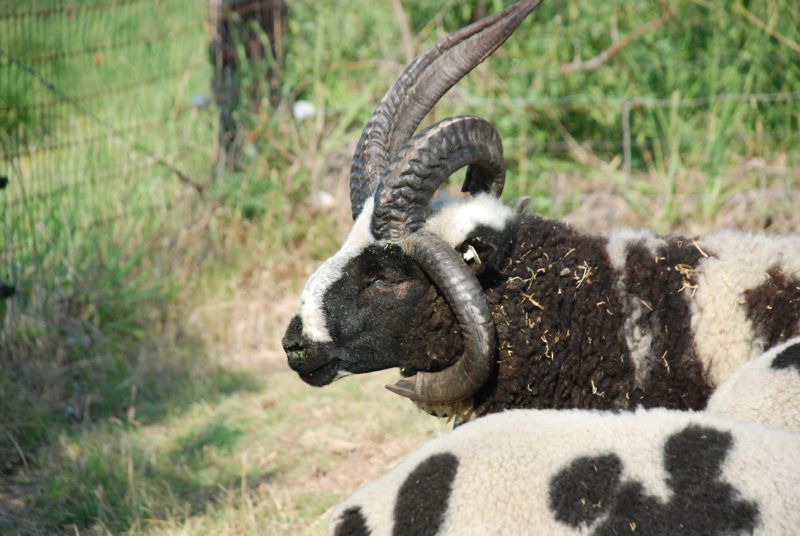 Miller (M. Clapton x M. Mable)
Miller (M. Clapton x M. Mable)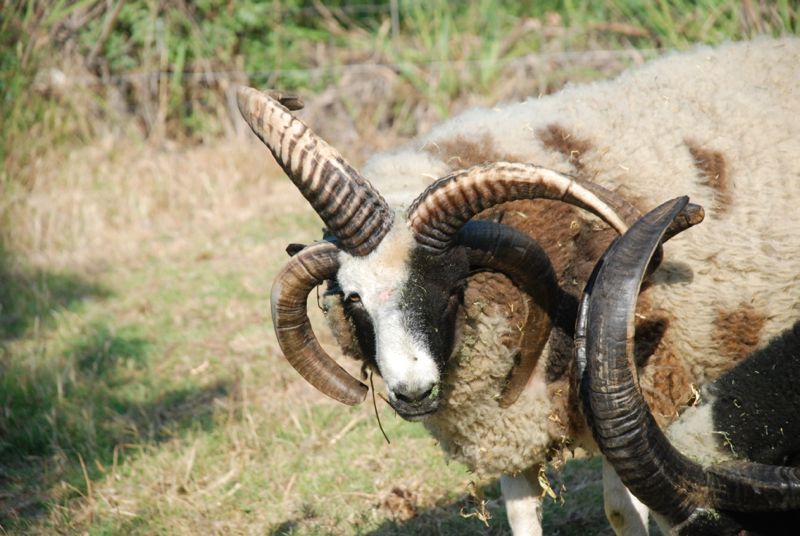 Presley (Sweetgrass Clint x M. Vicki)
Presley (Sweetgrass Clint x M. Vicki)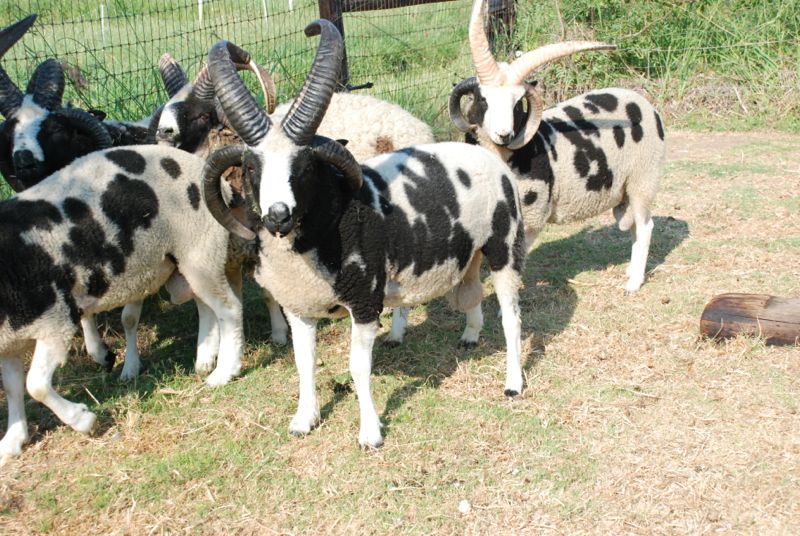 Larry (Ruby Peak Linden x M. Spring)
Larry (Ruby Peak Linden x M. Spring)
Relaxing at Someone Else's Farm
/A couple of weeks ago I went to Auburn, about an hour away, to the Shepherd's Picnic hosted by Dan Macon and Flying Mule Farm. I went as a visitor even though I brought a table with books and a few supplies. I did not set up a booth though, so I was free to enjoy the day at liberty. Dan had the day set up kind of like we did for Meet the Sheep, with activities scheduled every hour or so.
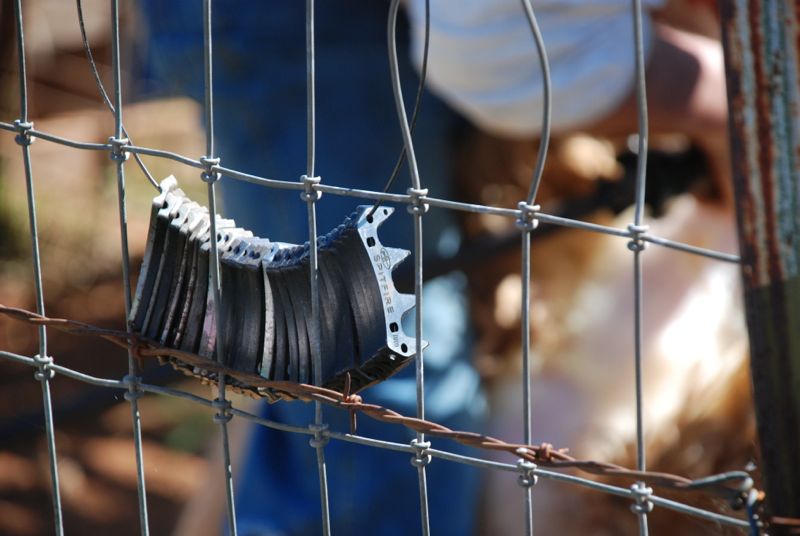 Shearing was first.
Shearing was first.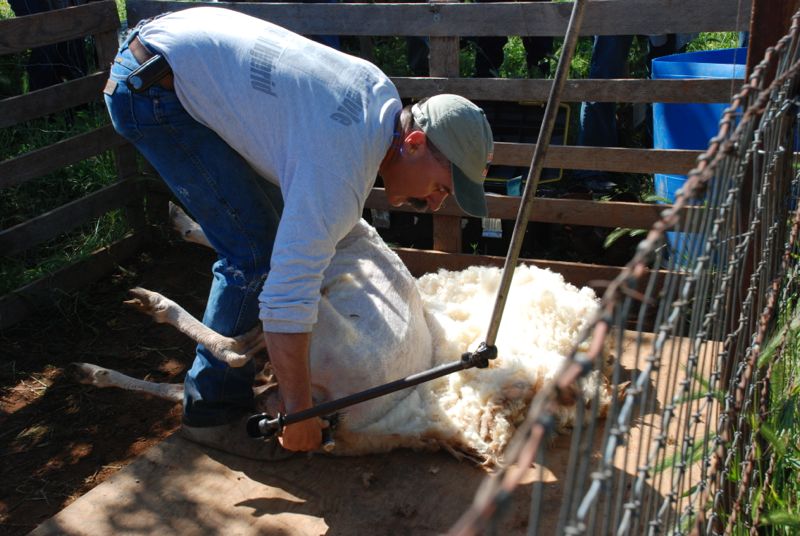 Dan does his own shearing.
Dan does his own shearing.
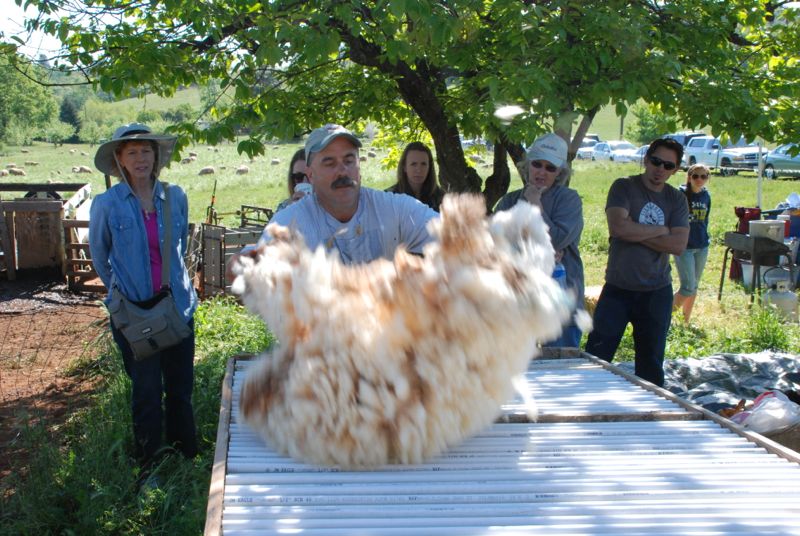 Here Dan throws a fleece onto the skirting table.
Here Dan throws a fleece onto the skirting table. 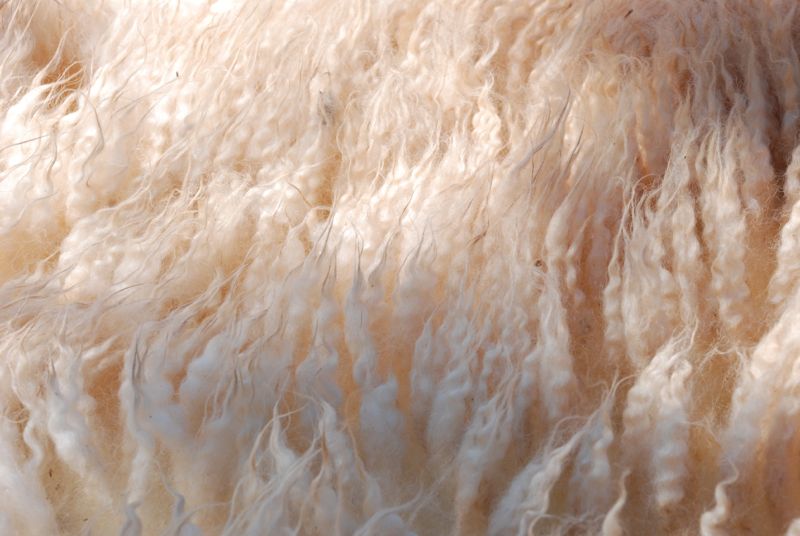 Beautiful, clean wool.
Beautiful, clean wool.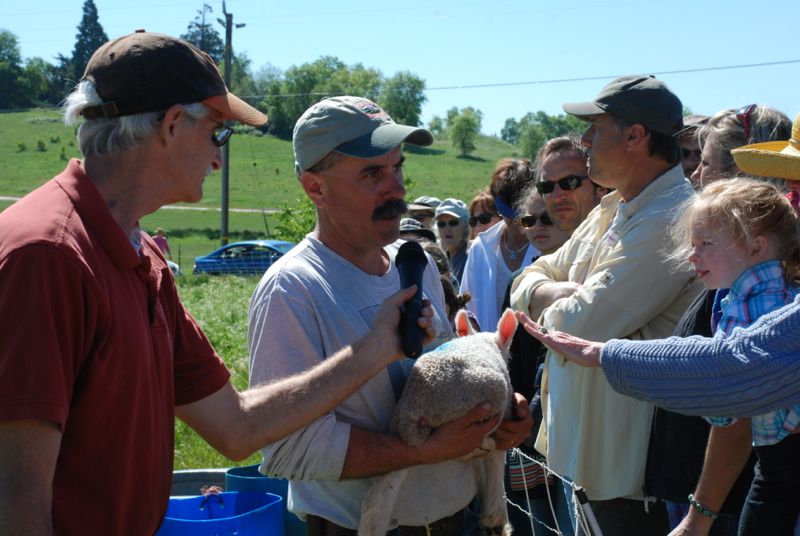 Next was a discussion of pasture management and flock management. Another friend, Farm Advisor, Roger Ingram, also helped out. I recorded some of what Dan and Roger talked about because I thought it would be great to share with Farm Club and others. One of these days I'll get around to editing it so others can listen.
Next was a discussion of pasture management and flock management. Another friend, Farm Advisor, Roger Ingram, also helped out. I recorded some of what Dan and Roger talked about because I thought it would be great to share with Farm Club and others. One of these days I'll get around to editing it so others can listen.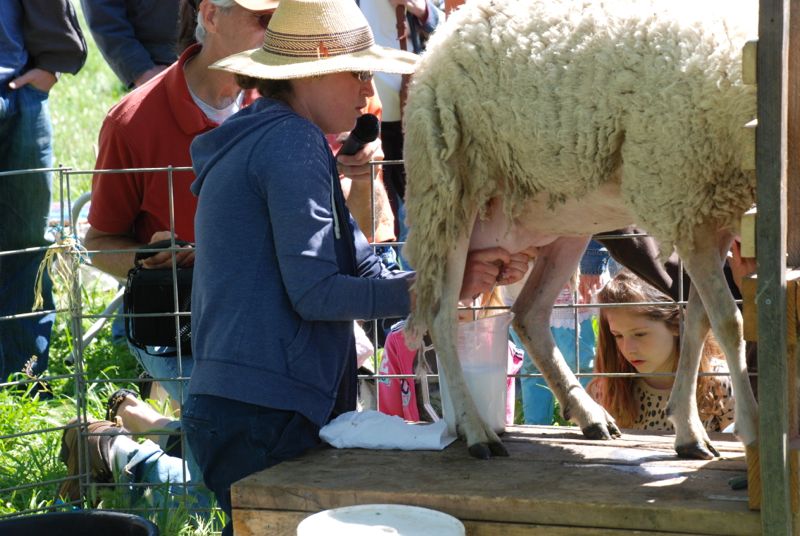 One of Dan's former interns brought one of her milking sheep so that she could demonstrate milking.
One of Dan's former interns brought one of her milking sheep so that she could demonstrate milking.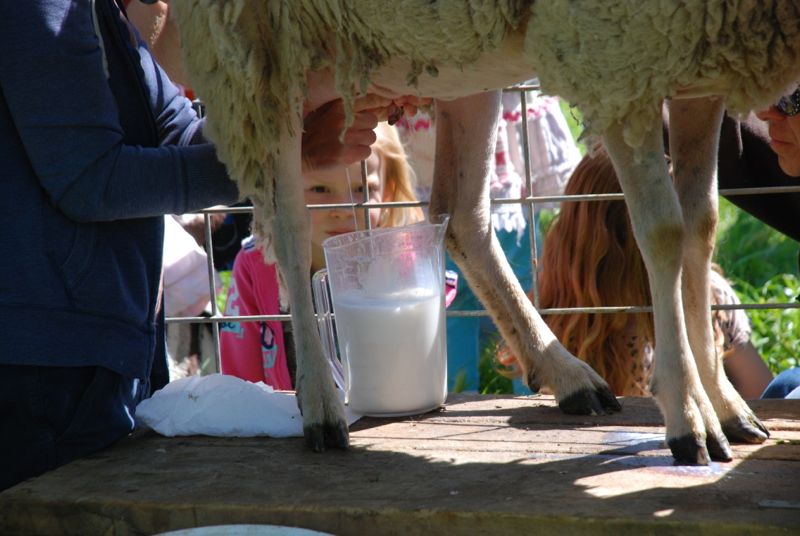 After milking she shared previously pasteurized and cold sheep milk. That was my first taste of sheep milk and it was great!
After milking she shared previously pasteurized and cold sheep milk. That was my first taste of sheep milk and it was great!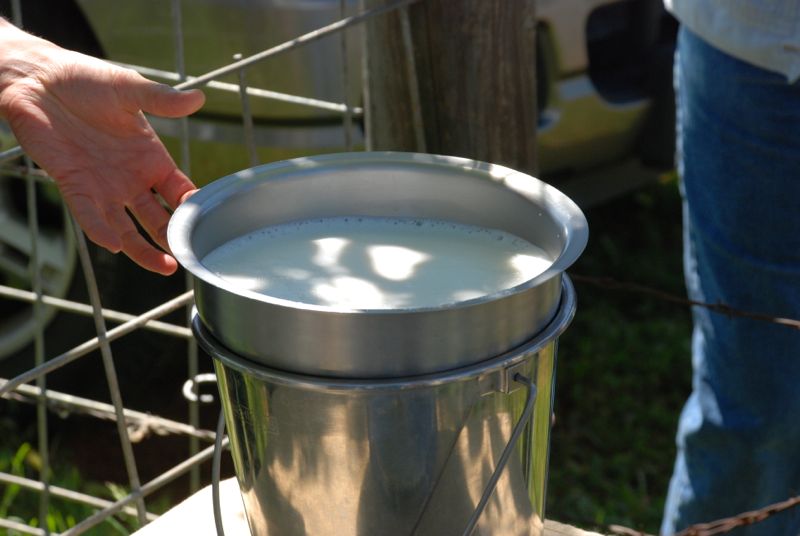
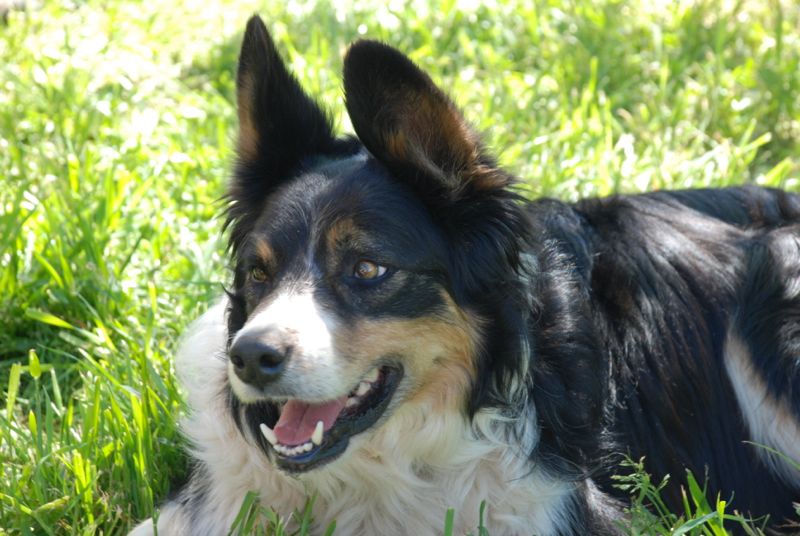 Dan's co-workers are invaluable assets to his farm. Mo, Taff, and Ernie have starring roles in Dan's blog as well.
Dan's co-workers are invaluable assets to his farm. Mo, Taff, and Ernie have starring roles in Dan's blog as well.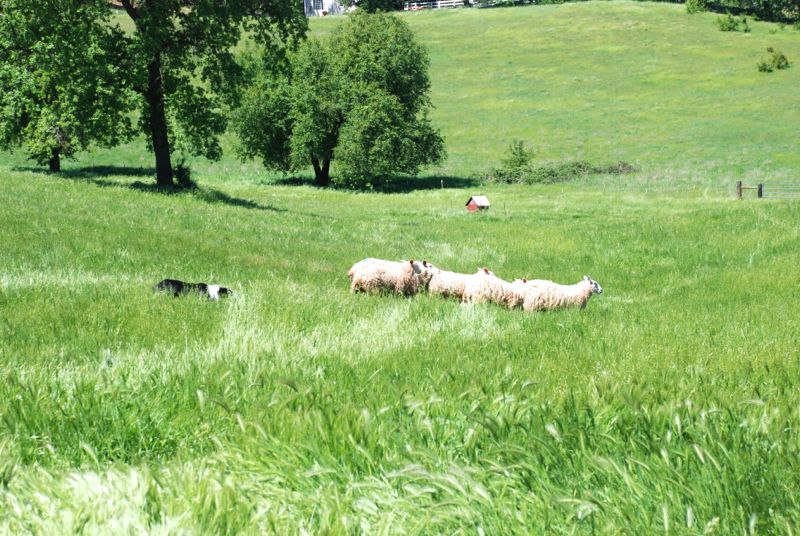 Dan, his daughter, and the dogs put on a herding demonstration.
Dan, his daughter, and the dogs put on a herding demonstration.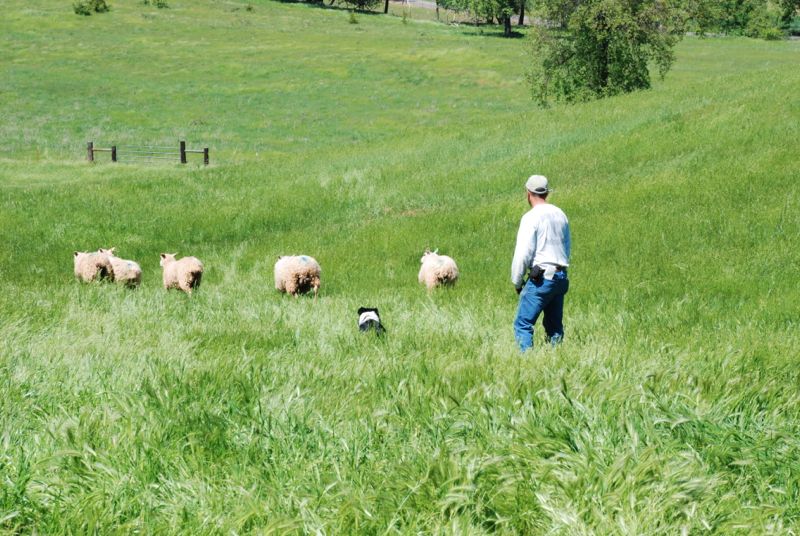
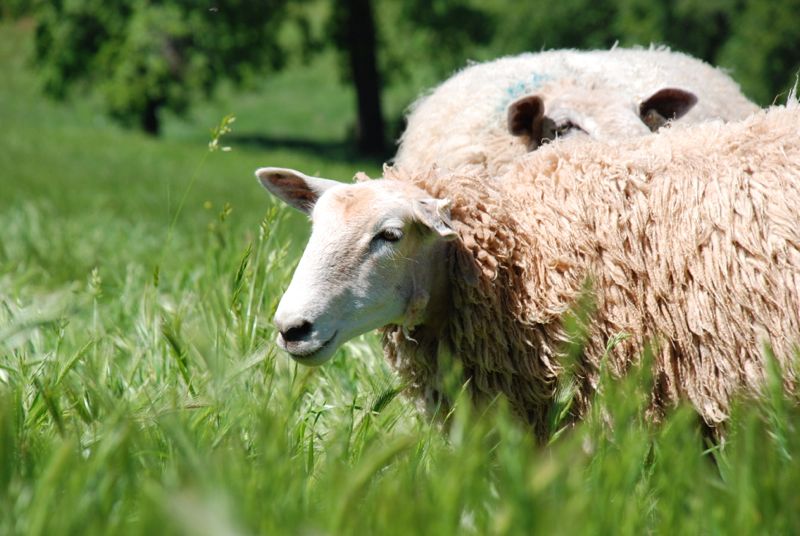 What a beautiful spring day in the Sierra foothills! This is gorgeous country, especially when it is so green this time of year. I will admit that during lunch I lay down in the grass and the warm sun and fell asleep. I don't do that very often!
What a beautiful spring day in the Sierra foothills! This is gorgeous country, especially when it is so green this time of year. I will admit that during lunch I lay down in the grass and the warm sun and fell asleep. I don't do that very often!
Field Trip Season
/I found a new Season. Field Trip Season. I've had 4 field trips here in the last couple of weeks. I don't get very good photos during field trips because I'm the one who is leading the field trip, but I'll use a few. Today I'll share yesterday's field trip because I got to be a participant (as opposed to leader) of part of it.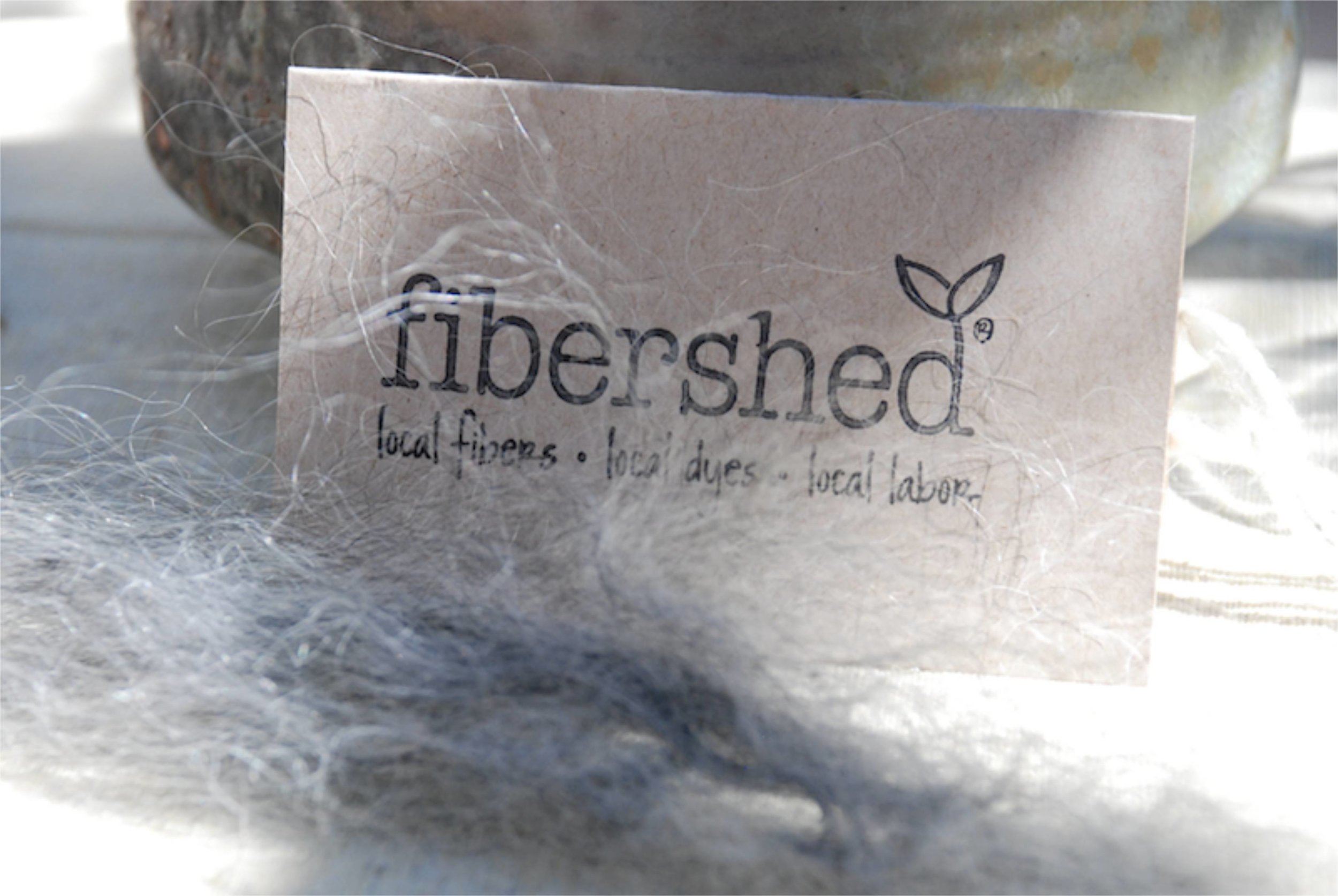 Fibershed sponsored a field trip for representatives of Smartwool, Northface, Lucy (and maybe others) to learn about our end of textile production. Many (most?) people who purchase and use fabric, individually or commercially, don't necessarily have a sense of where it comes from. The goal of this trip was to expand the awareness of fiber production--the animals, the farmers, the soil and plants--and the importance of supporting sustainable local farms, and the idea that there is plenty of wool grown in N. CA but not the infrastructure to turn it into cloth. That is a primary goal of Fibershed--to set in motion the creation of that infrastructure and to create thriving businesses that support farmers, designers, fiber processers, and consumers. Whew! Pretty lofty goals? I am always amazed at what Rebecca (creator of Fibershed) has coming up next. I really hope that you'll spend some time on the Fibershed website because I think it's one of the most important non-profit groups you'll find.
On to the field trip. I expected 5-6 people. There was a busload! First stop for us was the pasture.
Fibershed sponsored a field trip for representatives of Smartwool, Northface, Lucy (and maybe others) to learn about our end of textile production. Many (most?) people who purchase and use fabric, individually or commercially, don't necessarily have a sense of where it comes from. The goal of this trip was to expand the awareness of fiber production--the animals, the farmers, the soil and plants--and the importance of supporting sustainable local farms, and the idea that there is plenty of wool grown in N. CA but not the infrastructure to turn it into cloth. That is a primary goal of Fibershed--to set in motion the creation of that infrastructure and to create thriving businesses that support farmers, designers, fiber processers, and consumers. Whew! Pretty lofty goals? I am always amazed at what Rebecca (creator of Fibershed) has coming up next. I really hope that you'll spend some time on the Fibershed website because I think it's one of the most important non-profit groups you'll find.
On to the field trip. I expected 5-6 people. There was a busload! First stop for us was the pasture.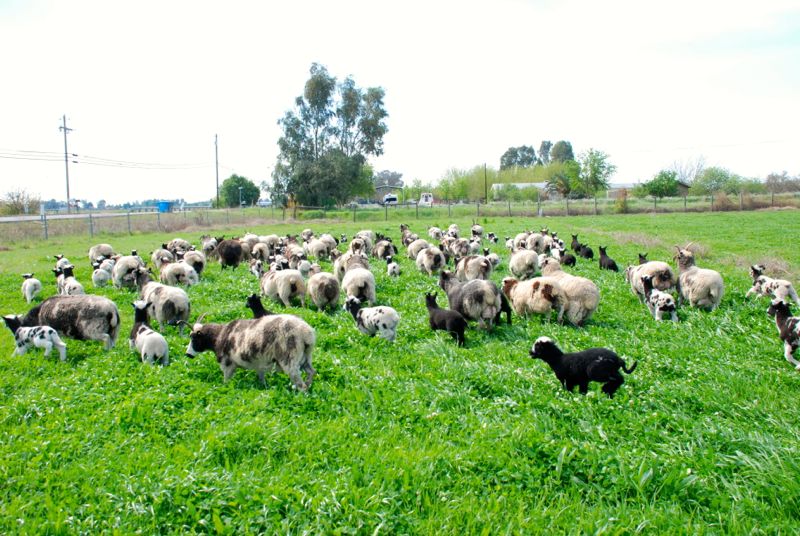 The sheep performed admirably. I had waited to move the fence for the day's grazing until the field trip was here. The sheep rushed to the fresh pasture just like they always do.
The sheep performed admirably. I had waited to move the fence for the day's grazing until the field trip was here. The sheep rushed to the fresh pasture just like they always do.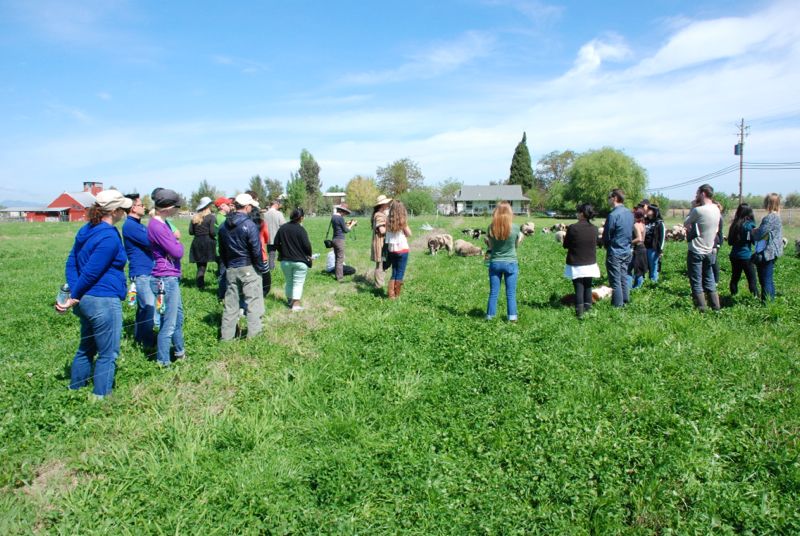 This is the group in the pasture. We spent a lot of time discussing pasture management, irrigation, choice of breed, wool types, etc.
This is the group in the pasture. We spent a lot of time discussing pasture management, irrigation, choice of breed, wool types, etc.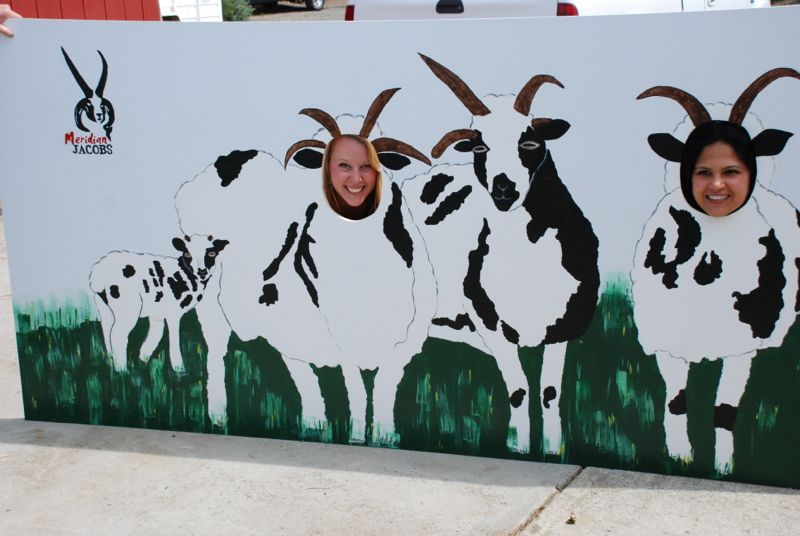 Friend, Dona, brought this board over, getting ready for Meet the Sheep on Saturday. Some of the braver visitors tried it out.
Friend, Dona, brought this board over, getting ready for Meet the Sheep on Saturday. Some of the braver visitors tried it out.
The second part of the tour was a trip to Mary Pettis-Sarley's ranch in the hills west of Napa. 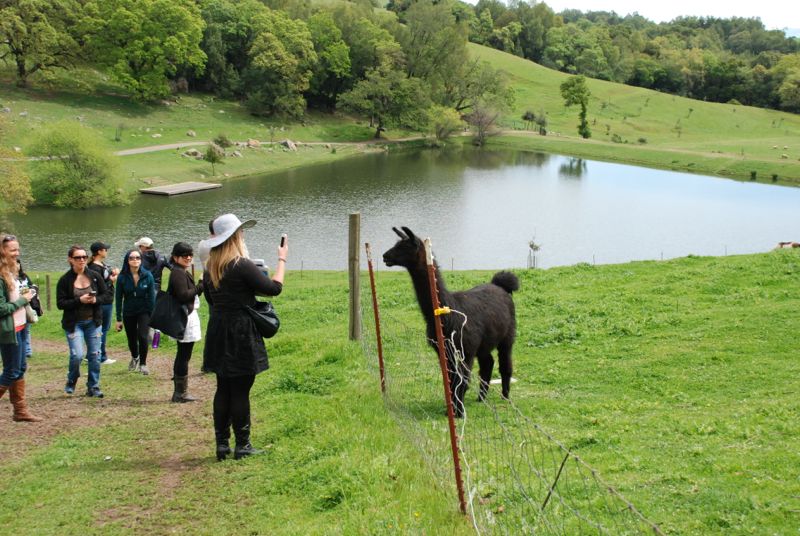 Mary has a variety of sheep, cattle, and alpacas who live in a beautiful setting.
Mary has a variety of sheep, cattle, and alpacas who live in a beautiful setting.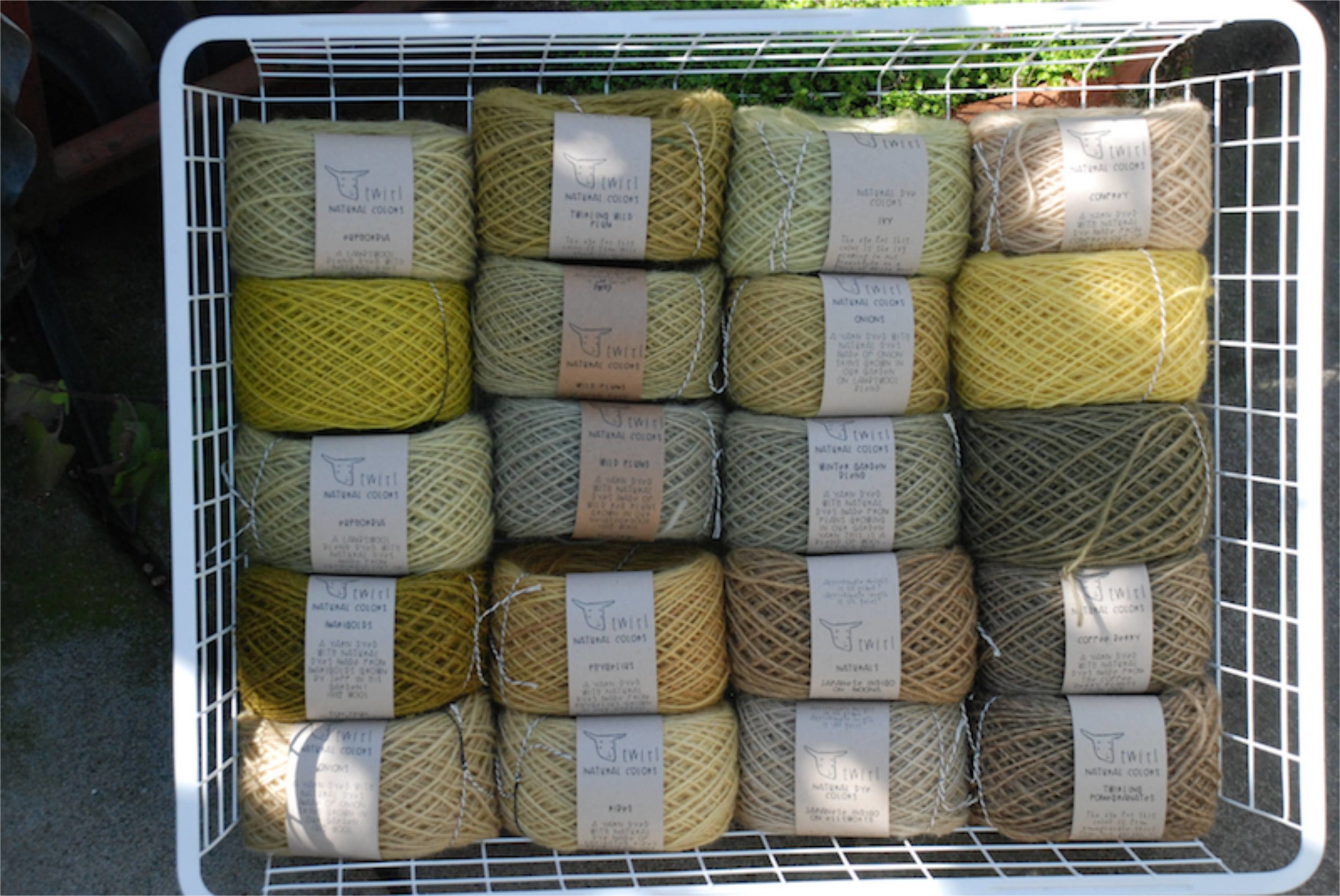 She creates Twirl yarn using unique blends of the fibers she grows.
She creates Twirl yarn using unique blends of the fibers she grows.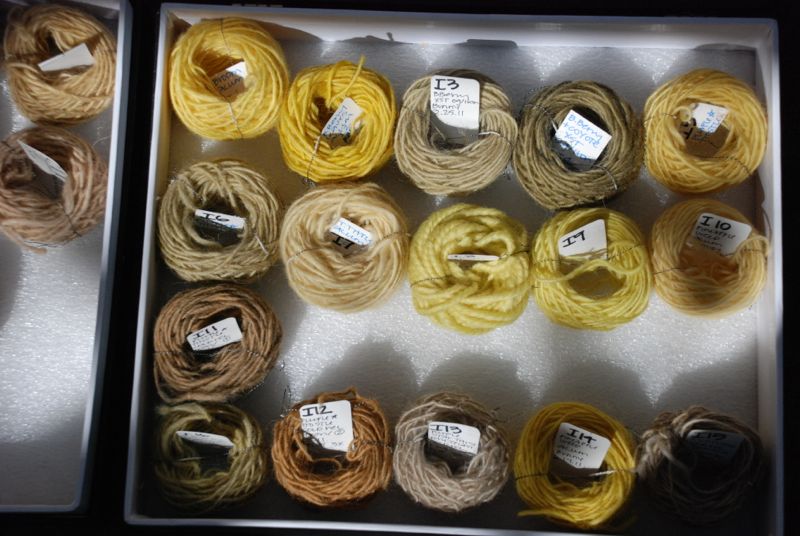 The yarns are all natural colored or dyed with natural dyes from plants that grow on the ranch. The "I" in these labels indicates that the dyeplants are invasive species.
The yarns are all natural colored or dyed with natural dyes from plants that grow on the ranch. The "I" in these labels indicates that the dyeplants are invasive species.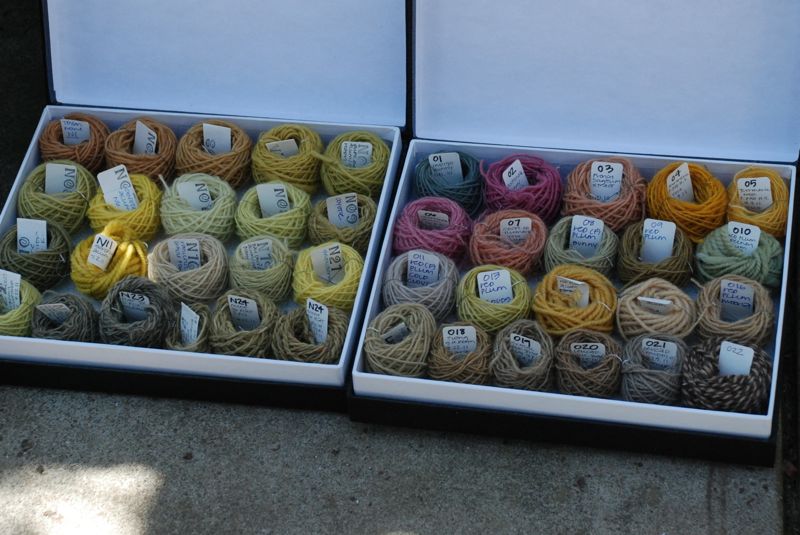
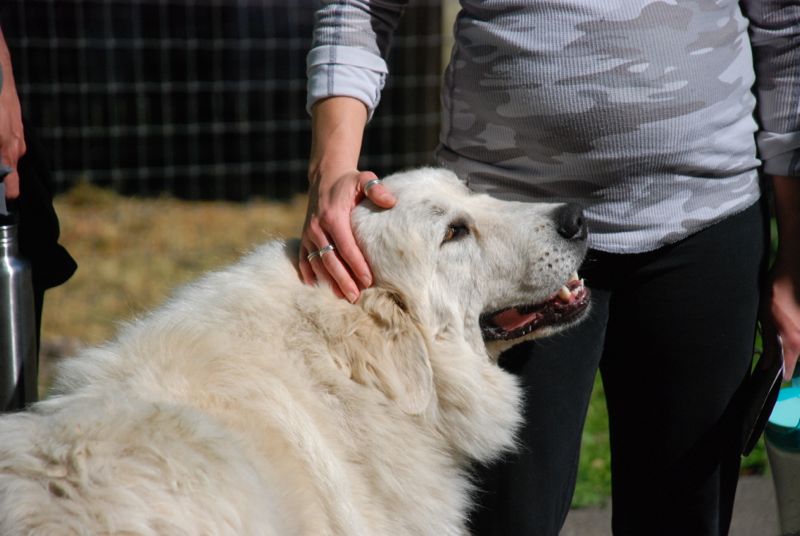 A major challenge of raising livestock in the hills is the predator problem. Mary has 17 dogs, most of whom are various breeds of livestock guardian dogs (LGD). They can be intimidating when you drive onto the property, but aren't so scary once they know you're on the approved list (or maybe that you're not a 4-legged hungry visitor).
A major challenge of raising livestock in the hills is the predator problem. Mary has 17 dogs, most of whom are various breeds of livestock guardian dogs (LGD). They can be intimidating when you drive onto the property, but aren't so scary once they know you're on the approved list (or maybe that you're not a 4-legged hungry visitor).
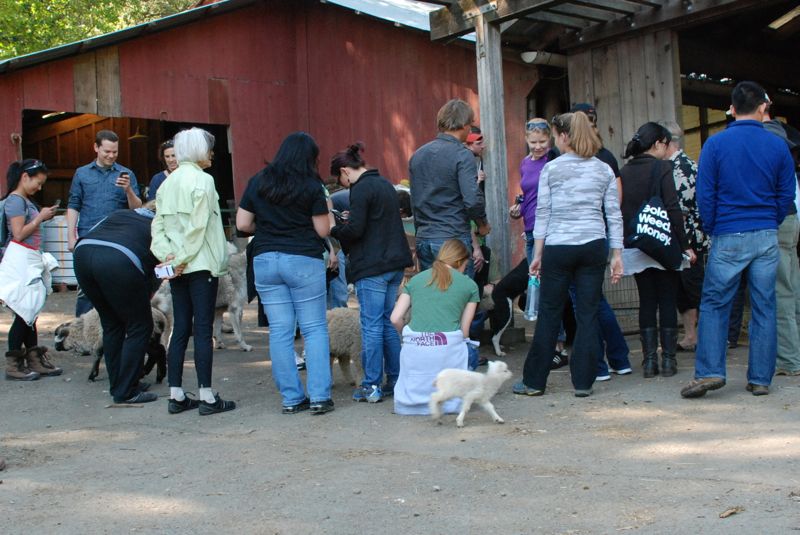 Mary let out the bottle babies...
Mary let out the bottle babies...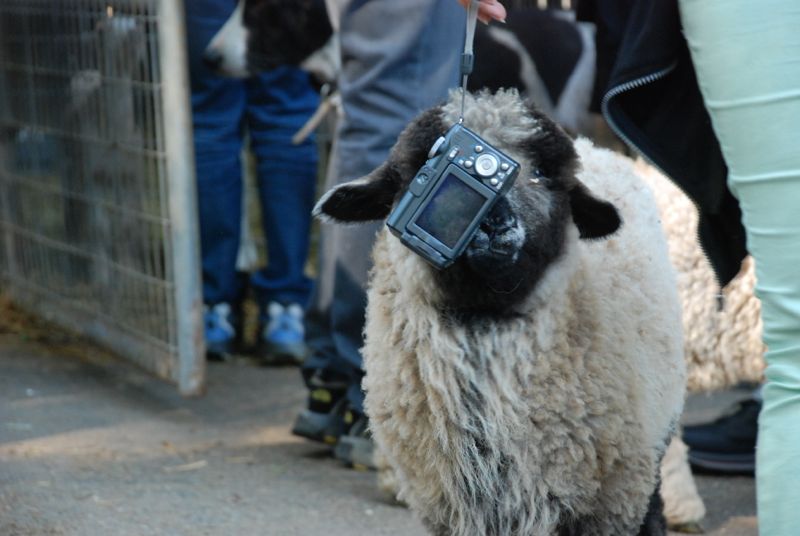 ...and I think her part of the field trip won the Cuteness Factor award.
...and I think her part of the field trip won the Cuteness Factor award.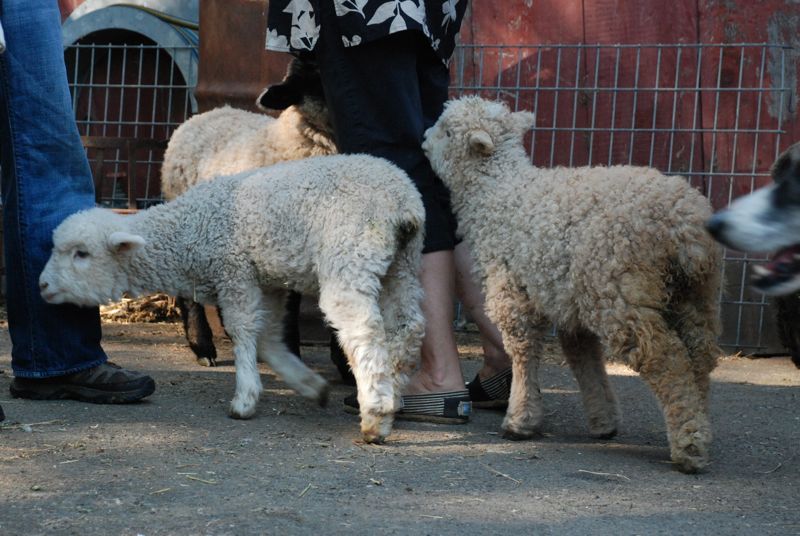
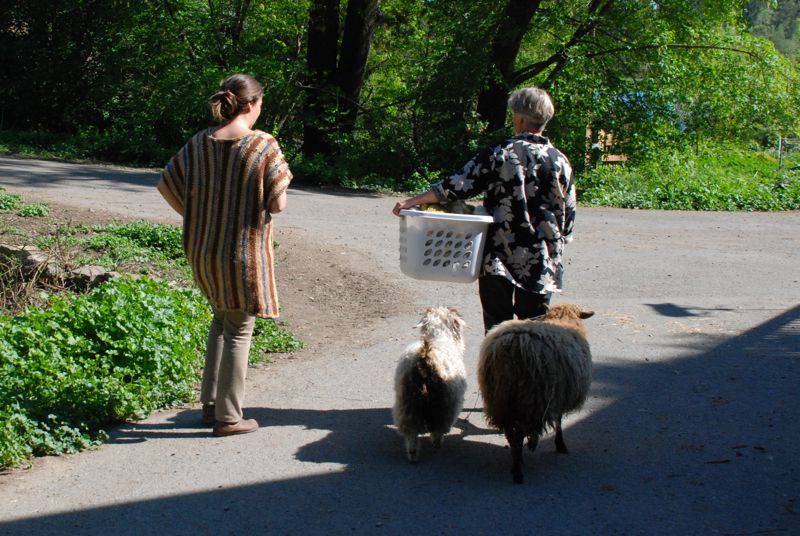 We were accompanied by two of the pets on the way to Mary's wool washing station.
We were accompanied by two of the pets on the way to Mary's wool washing station.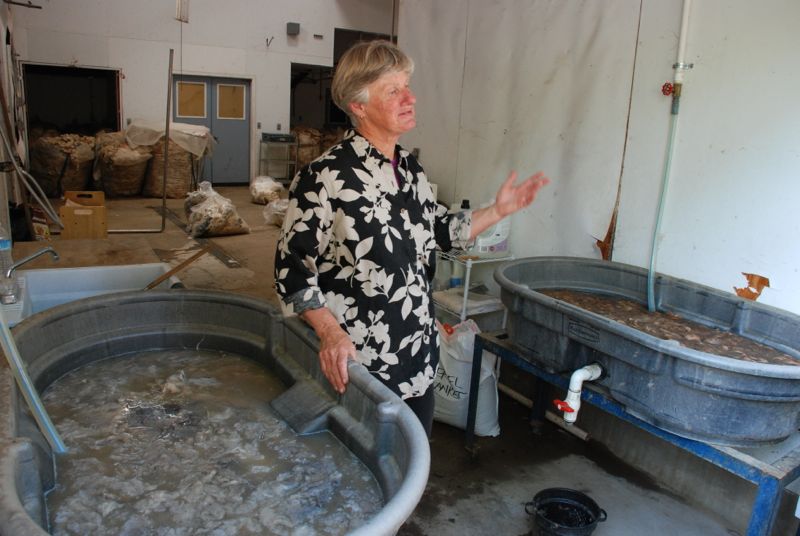 Now I'm jealous, not only of the property, but of this. Maybe I'd wash more of my own fleeces if I could figure out a set-up like this.
Now I'm jealous, not only of the property, but of this. Maybe I'd wash more of my own fleeces if I could figure out a set-up like this.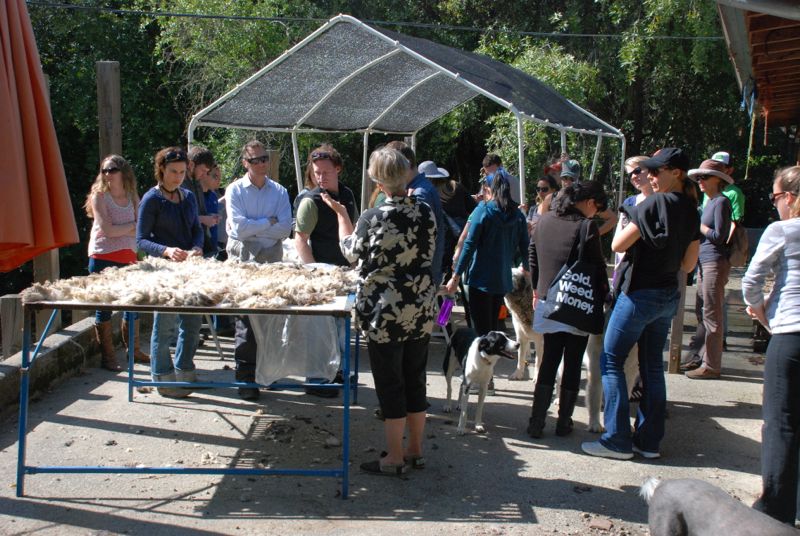 Here is where the fleeces are dried. Mary had several fleeces spread out so that the visitors could handle them and feel the characteristics that we'd been talking about all day.
Here is where the fleeces are dried. Mary had several fleeces spread out so that the visitors could handle them and feel the characteristics that we'd been talking about all day.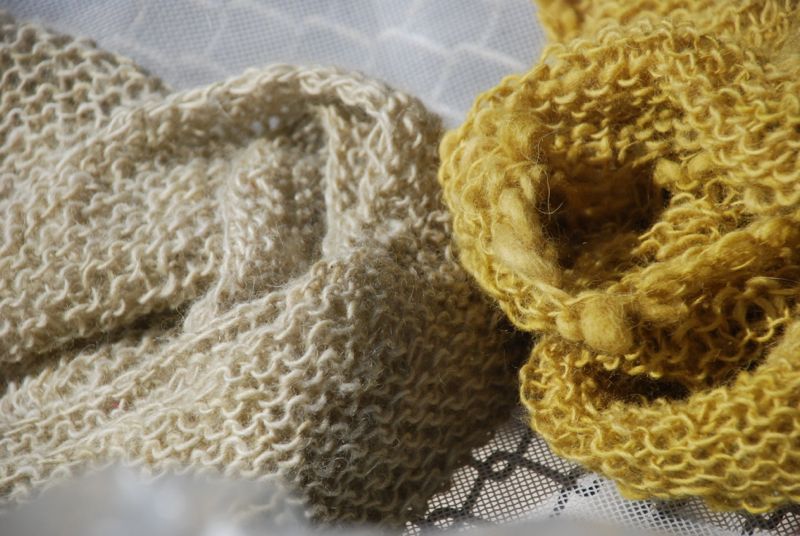 A couple of scarves knit with Mary's yarn.
A couple of scarves knit with Mary's yarn.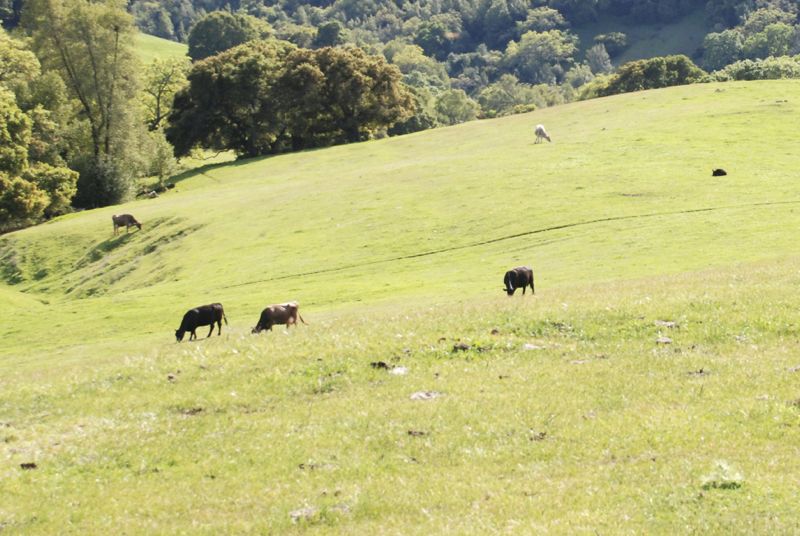 As I drove way I saw some of Mary's cows. As it happens, these cows are the daughters and granddaughters of Jennie, a Brown Swiss cow that Mary got from us when we left our dairy life in 1998. Talk about happy CA cows. These truly have a happy life.
As I drove way I saw some of Mary's cows. As it happens, these cows are the daughters and granddaughters of Jennie, a Brown Swiss cow that Mary got from us when we left our dairy life in 1998. Talk about happy CA cows. These truly have a happy life.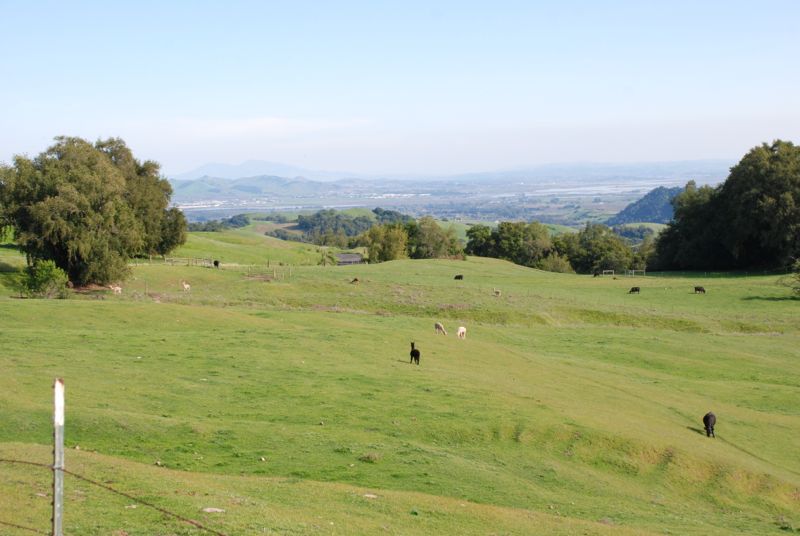 Look at their view of the Napa Valley if they choose to look up from all that grass. (Alpacas in this photo--they were right next to the cows.)
Look at their view of the Napa Valley if they choose to look up from all that grass. (Alpacas in this photo--they were right next to the cows.)
Lambs everywhere
/Eight lambs today brought us to 22 lambs in five days since lambing began. It was hectic today. I had a Lambtown Fiber Committee meeting scheduled here from 1 to 3. One ewe (Delilah) lambed with twins and I put another ewe (Belinda) in a lambing pen just before the meeting started. One of the participants in the meeting brought her kids and the kids needed something to do. They were charged with the task of telling us if Belinda started having a lamb. About half way through the meeting the kids told us that a different ewe had just had a lamb. That was Terraza and I brought her into the barn. By the time the meeting was over there were 5 more lambs (2 for Terraza, 2 for Belinda, and 1 more for Delilah, giving her triplets). 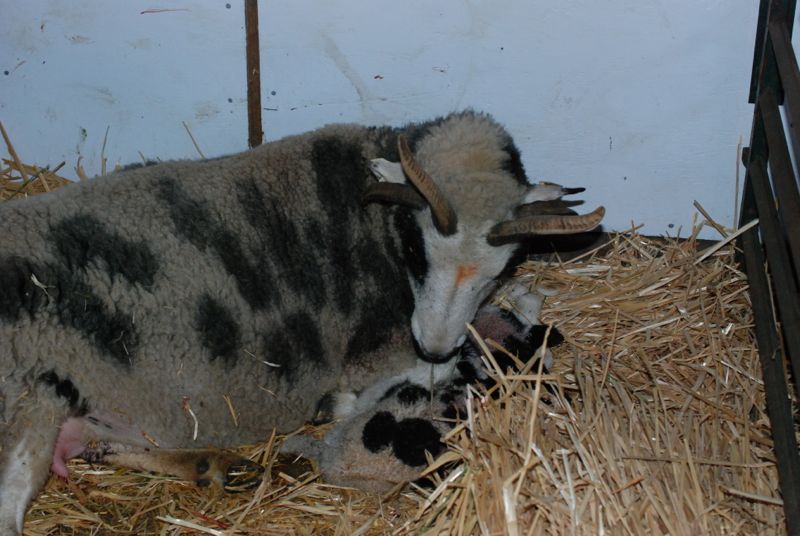 The morning began with finding Summer's lambs. Unfortunately one was dead. (This is not a very good photo but it is of the live lamb.)
The morning began with finding Summer's lambs. Unfortunately one was dead. (This is not a very good photo but it is of the live lamb.)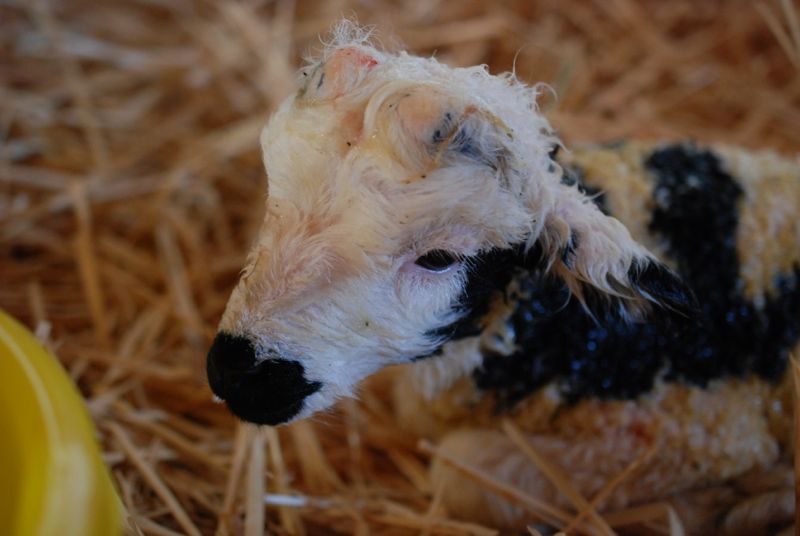 The third of Delilah's triplets. Look at those horns.
The third of Delilah's triplets. Look at those horns.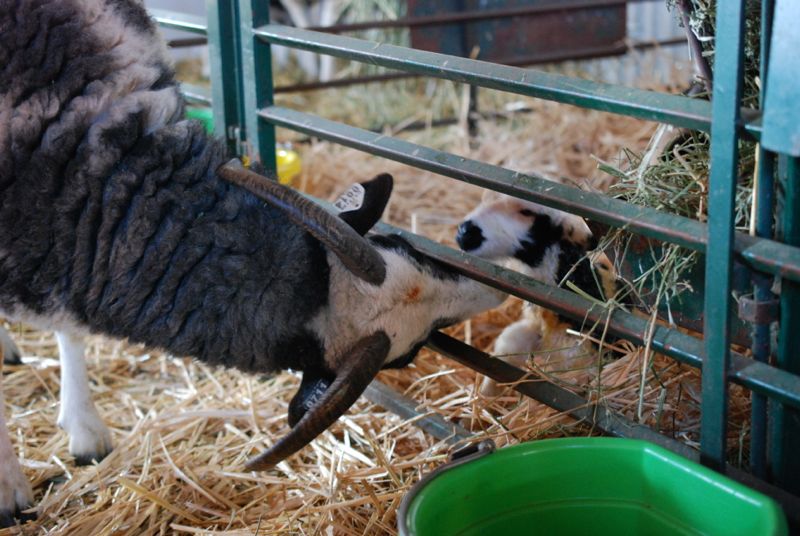 This is Belinda. It's no wonder that lambs and ewes get mixed up when lambing in a confined area. Belinda was desperate to have a lamb, any lamb.
This is Belinda. It's no wonder that lambs and ewes get mixed up when lambing in a confined area. Belinda was desperate to have a lamb, any lamb.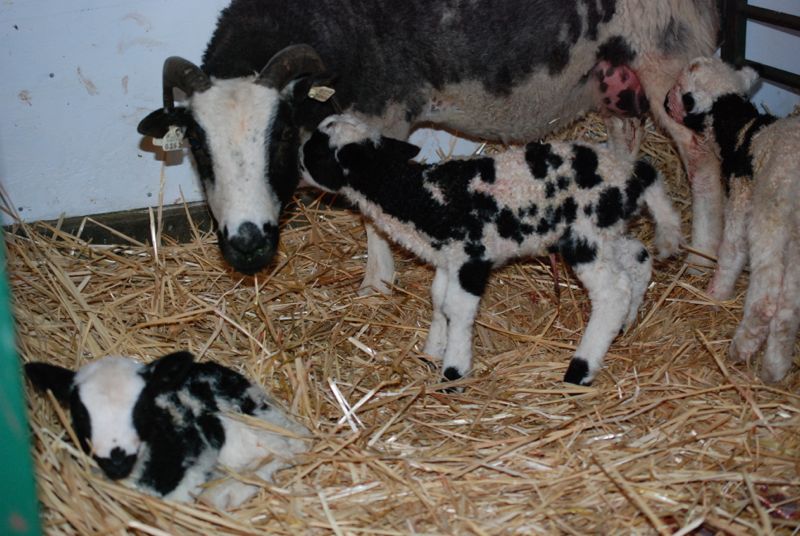 Delilah and her triplets.
Delilah and her triplets.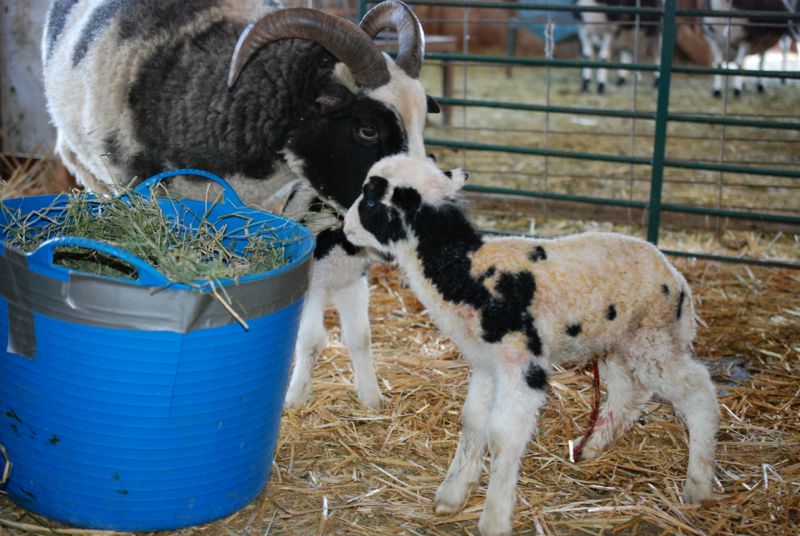 Terraza and twins.
Terraza and twins.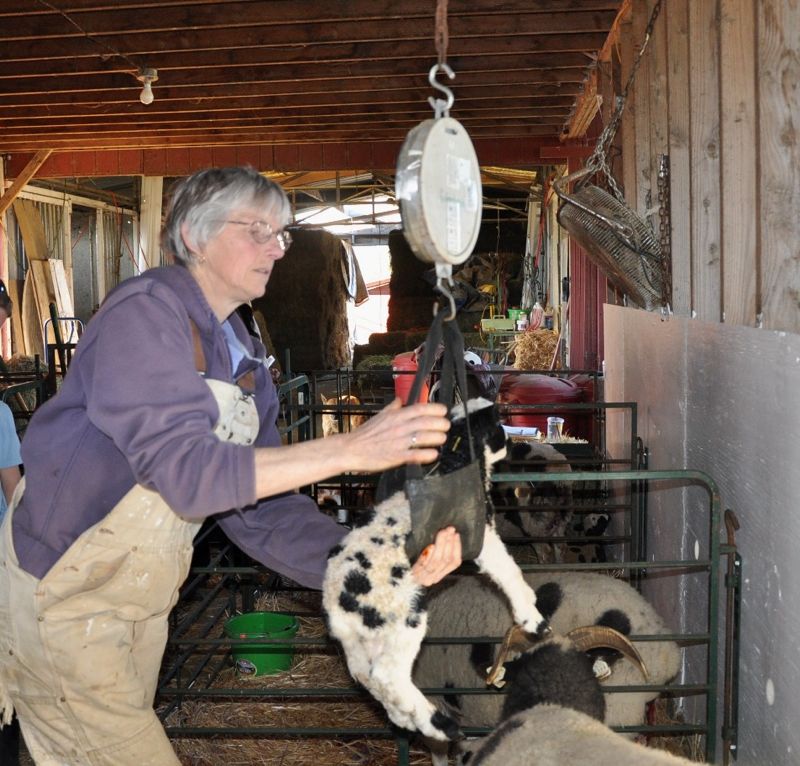 Dona came for the meeting and she took some photos. I like to weigh the lambs so I have an answer when people ask me "how much do they weigh when they are born?"
Dona came for the meeting and she took some photos. I like to weigh the lambs so I have an answer when people ask me "how much do they weigh when they are born?"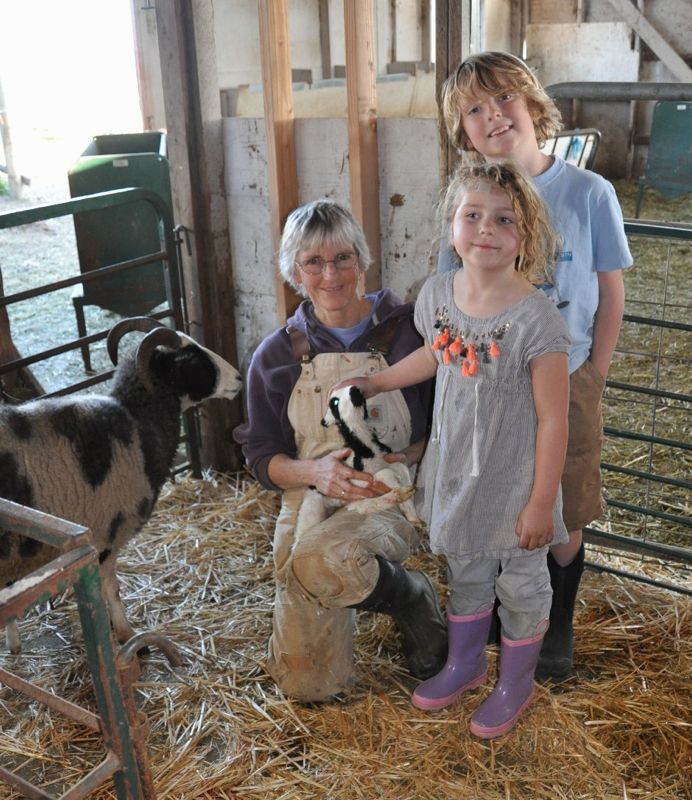 Here are the official Lamb Watchers of the day.
Here are the official Lamb Watchers of the day.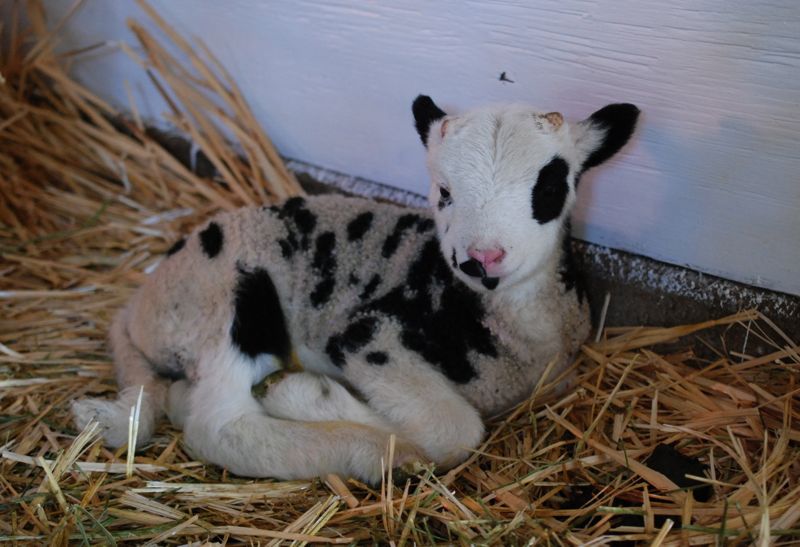 This is one of Eliza's lambs, born a couple of days ago.
This is one of Eliza's lambs, born a couple of days ago.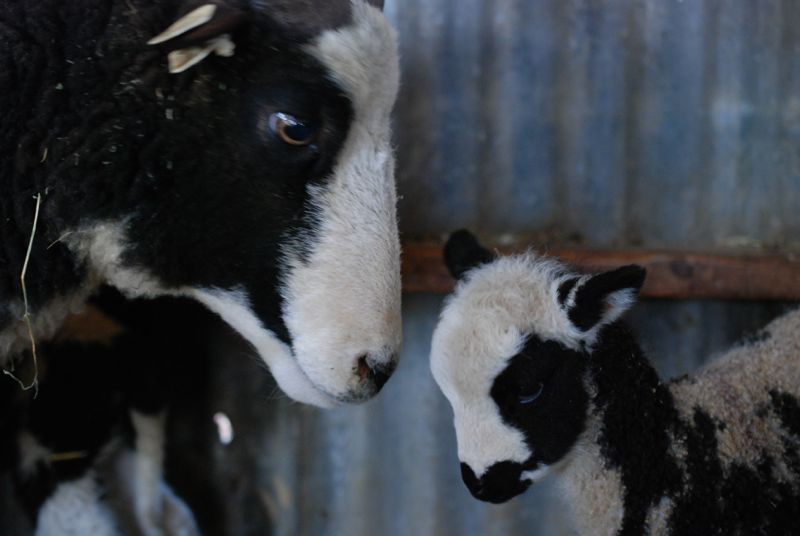 Hot Lips and one of her lambs.
Hot Lips and one of her lambs.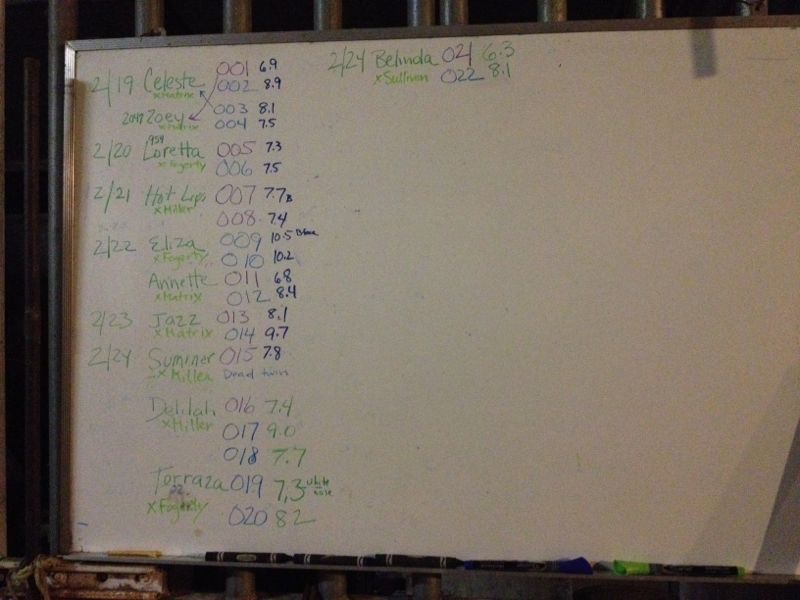 The Lambing Board.
The Lambing Board.
Lambs are Here!
/Lambs were due on Thursday, 148 days after the first breeding date. I've started watching for early arrivals. Last night I went out at about 12:30 a.m. (after finishing bookkeeping for the night) and found two ewes with four lambs. I brought them into the lambing pen area and tried to sort out moms and babies. I finally assigned two lambs to each ewe and they all seemed happy. In the light of day I realize that the sets of twins are split up. But that's OK as long as each lamb has a happy mom.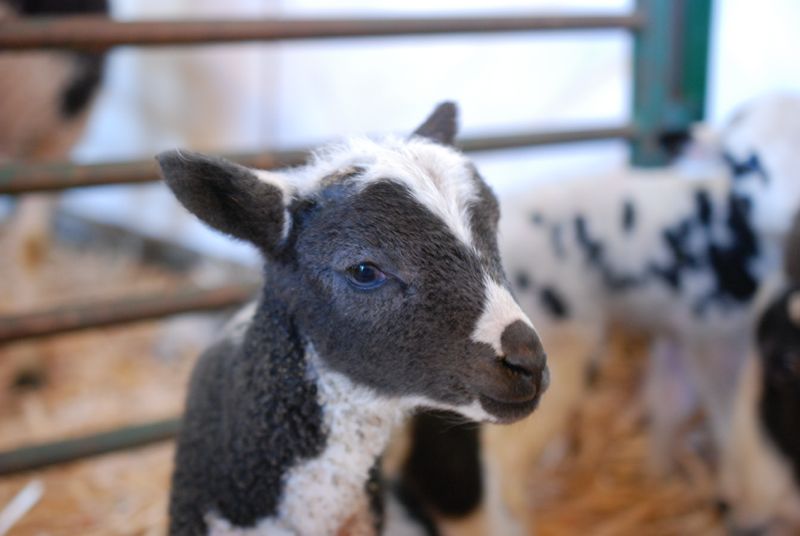 This is a beautifully marked ram lamb. Meridian Celeste x Kenleigh's Matrix. The two parents are both lilac (the color of this lamb) and they should have lilac offspring.
This is a beautifully marked ram lamb. Meridian Celeste x Kenleigh's Matrix. The two parents are both lilac (the color of this lamb) and they should have lilac offspring. 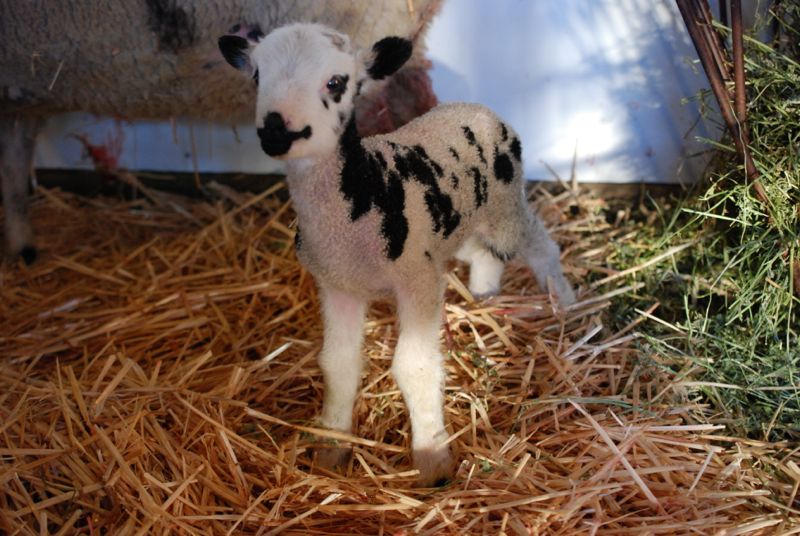 This is his adopted twin, but he is black so I think belongs to the other mom. (Meridian Zoey x Meridian Fogerty)
This is his adopted twin, but he is black so I think belongs to the other mom. (Meridian Zoey x Meridian Fogerty)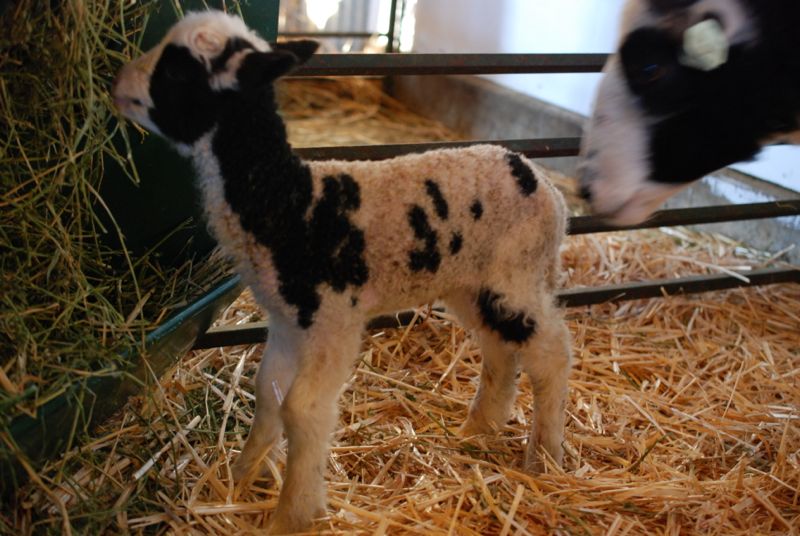 Here is a lilac ewe lamb (although in the photo she looks black) so this is the twin to the first one.
Here is a lilac ewe lamb (although in the photo she looks black) so this is the twin to the first one. 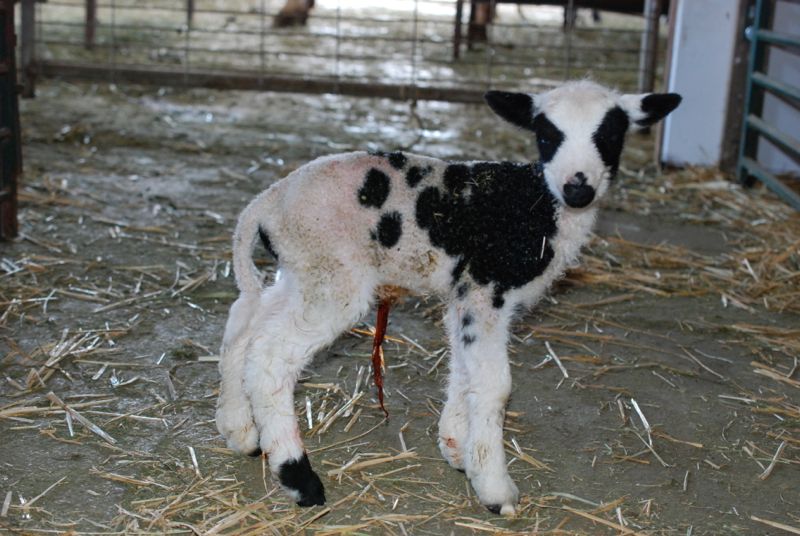 Meridian Loretta lambed with twins in the middle of the day. I put Loretta in a pen and came back an hour later. No muss, no fuss. Twins clean and nursing. This is a ewe lamb. Meridian Loretta x Kenleigh's Matrix.
Meridian Loretta lambed with twins in the middle of the day. I put Loretta in a pen and came back an hour later. No muss, no fuss. Twins clean and nursing. This is a ewe lamb. Meridian Loretta x Kenleigh's Matrix.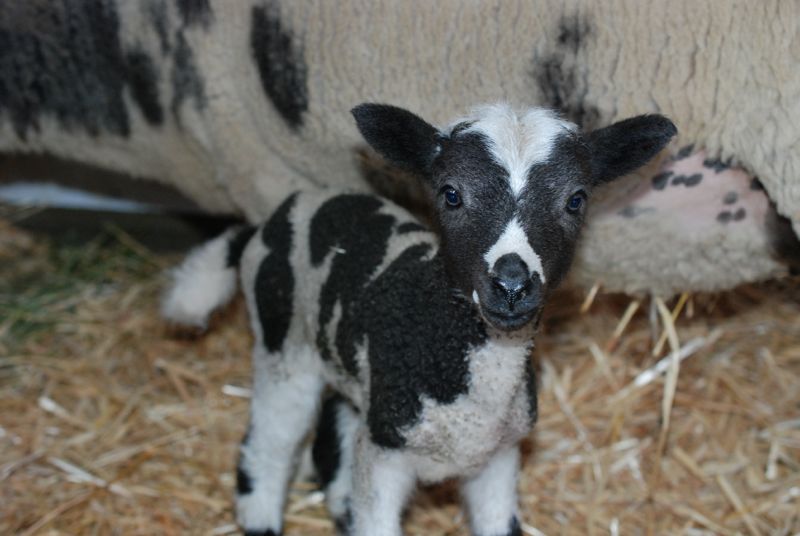 Here is that first lamb again. I usually just number the lambs and let buyers give them names. This lamb is tempting me to name all my lambs. I don't have his name yet, but I'll think of one.
Here is that first lamb again. I usually just number the lambs and let buyers give them names. This lamb is tempting me to name all my lambs. I don't have his name yet, but I'll think of one. 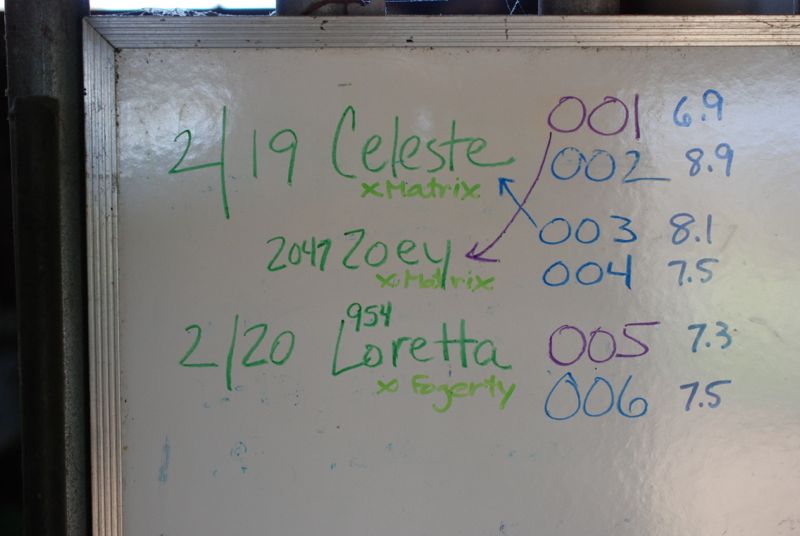 Lambing season has started.
Lambing season has started.
Ultrasounds and other veterinary observations
/
The veterinarians from UC Davis VMTH were here on Monday. The VMTH sponsors the State Fair Nursery so they will come here to ultrasound ewes. I will be breeding 3 or 4 ewes at the same time as all the others are lambing. This fall, while I was breeding ewes to 6 different rams I also had a non-breeding group. Unfortunately, one of the rams got in with that group on the last day of my breeding season. I gave the 2 ewes he bred the sheep equivalent of the morning-after pill, so Monday was the day to see if it had worked.
No! Shelby is pregnant with a single and Mary has triplets. I think this is the photo of triplets. (If you must know, I can't always tell what I'm seeing in these.) By the way, a lamb at 42 days gestation is about the size of a gummy bear. That's not something that you find in a veterinary text, but vet students have pointed out the relationship to their teachers.
Here is one that I could see. There is a large (relatively) single lamb here in the middle just under that dark line. (It doesn't show up in this photo as well as it did seeing it on the screen.)
While the vets were here I showed them a wool sample from the fleece of a ram lamb, Presley.
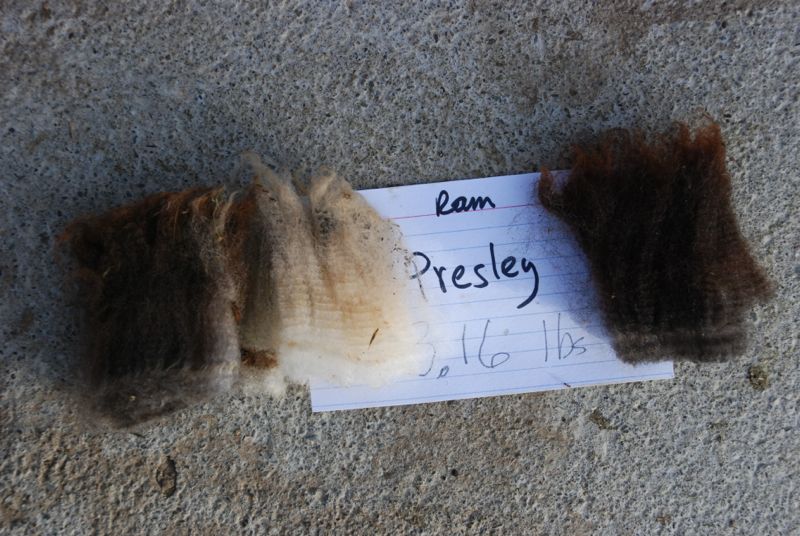 It isn't all that obvious in this photo, but can you see that distinct change in color and texture at the bottom of the locks? It is not weak at that point, but the fleece definitely changes color. That is the cut end, so the change occurred a couple of months before shearing. I thought that maybe this related to selenium deficiency or some other mineral issue. We looked at the ram.
It isn't all that obvious in this photo, but can you see that distinct change in color and texture at the bottom of the locks? It is not weak at that point, but the fleece definitely changes color. That is the cut end, so the change occurred a couple of months before shearing. I thought that maybe this related to selenium deficiency or some other mineral issue. We looked at the ram.
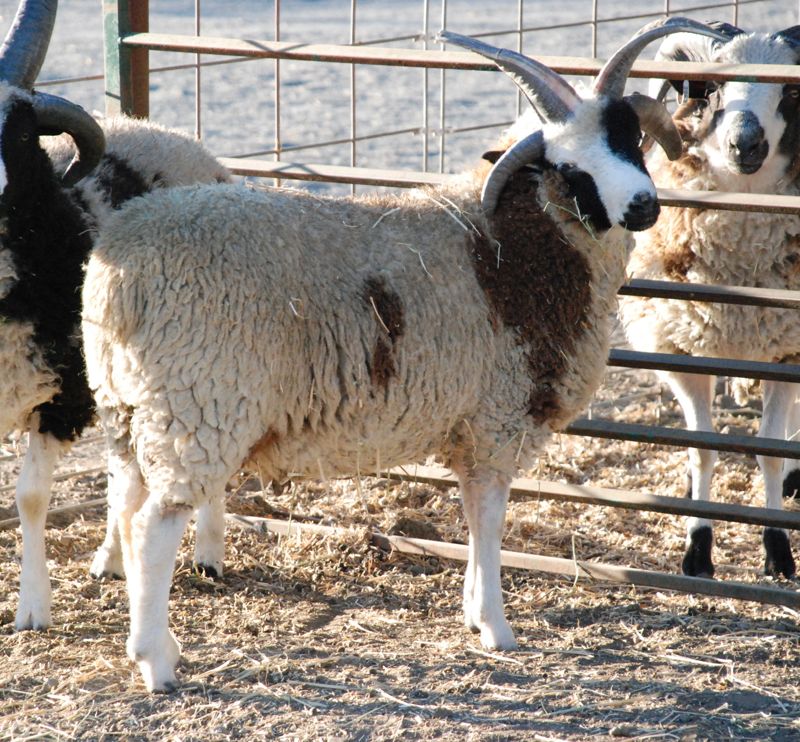 This is Presley, taken in mid-September. One observation of mine is that he won't register as a lilac ram, but his fleece is the brown/gray of a lilac and definitely not black and white. (In this photo the dark wool just shows sun-bleaching, but when you look at the fleece sample you can see that is is not black.) However his facial markings look black. I think this is what some people are calling a chocolate lilac.
This is Presley, taken in mid-September. One observation of mine is that he won't register as a lilac ram, but his fleece is the brown/gray of a lilac and definitely not black and white. (In this photo the dark wool just shows sun-bleaching, but when you look at the fleece sample you can see that is is not black.) However his facial markings look black. I think this is what some people are calling a chocolate lilac.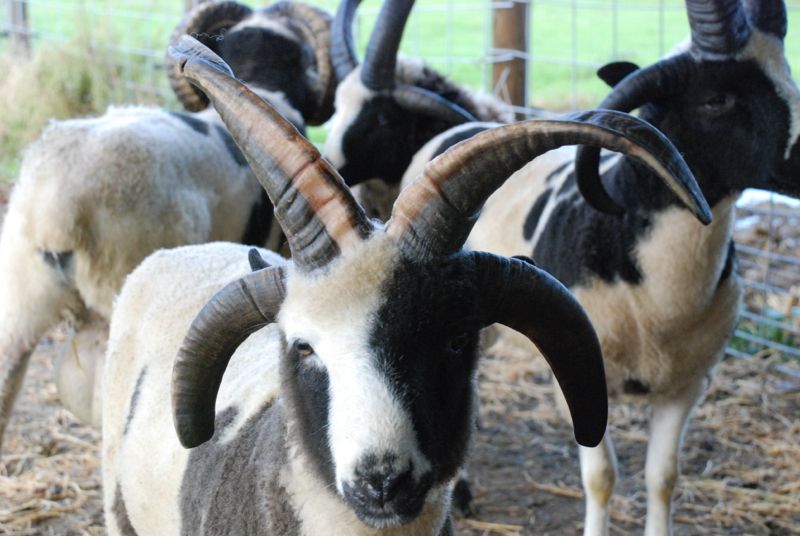 This is Presley now. Take a look at his horns.
This is Presley now. Take a look at his horns.
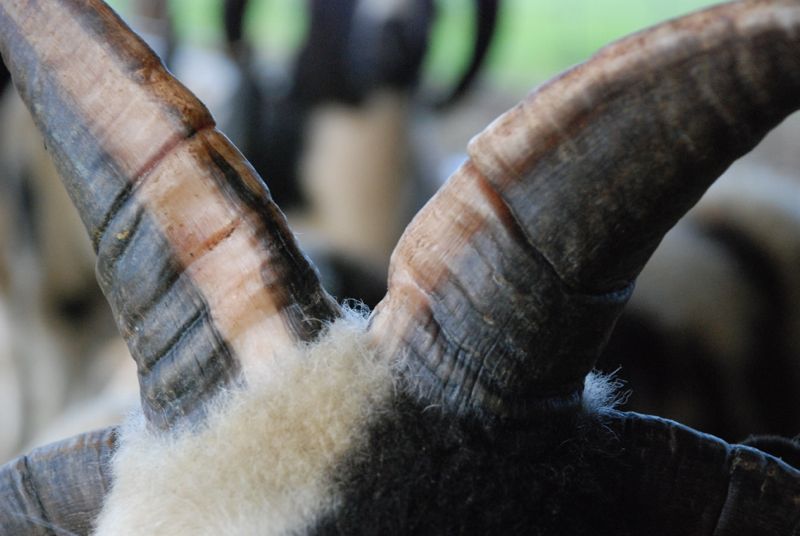 I hadn't noticed before, but all 4 horns have a ridge in the same place and the vets wondered if this related to the same conditions that caused the change in the fleece sample. When you look back at the first photo of Presley from September 17 you see that his horns are smooth. I posted a video of Presley taken September 24 that shows what I think is one of the many possible symptoms of bluetongue. The last two photos were taken 3 months after that. Did the illness result in the change in horn growth and the fleece observations? It is not any matter of earth-shaking importance, but I find it an interesting idea. My simple question about the fleece has led to a lot of other inquiries.
I hadn't noticed before, but all 4 horns have a ridge in the same place and the vets wondered if this related to the same conditions that caused the change in the fleece sample. When you look back at the first photo of Presley from September 17 you see that his horns are smooth. I posted a video of Presley taken September 24 that shows what I think is one of the many possible symptoms of bluetongue. The last two photos were taken 3 months after that. Did the illness result in the change in horn growth and the fleece observations? It is not any matter of earth-shaking importance, but I find it an interesting idea. My simple question about the fleece has led to a lot of other inquiries.
We looked at the rest of the rams while the vets were here.
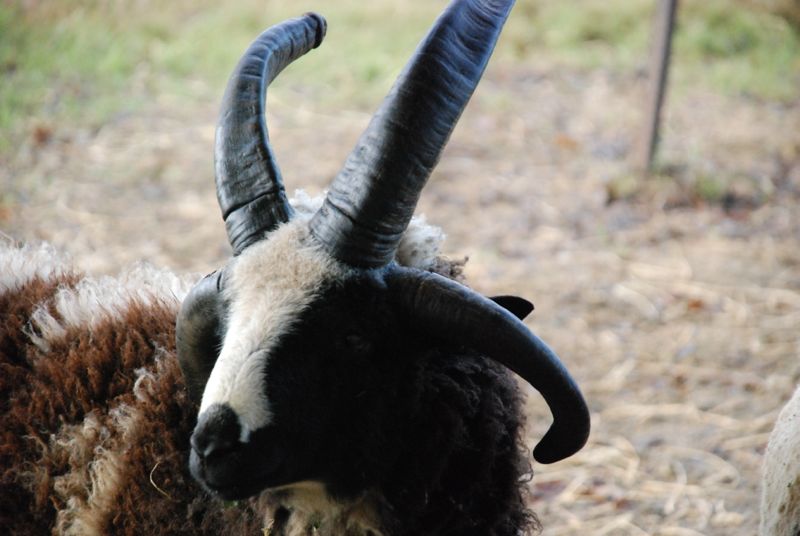 This is Larry, who was breeding a friend's flock and just came home. The friend told me that she thought Larry had blue tongue also. Note the ridges on his horns.
This is Larry, who was breeding a friend's flock and just came home. The friend told me that she thought Larry had blue tongue also. Note the ridges on his horns.
The reason that I asked the vets about Presley's fleece is that I had remembered seeing another fleece with the same discoloration. I had taken a photo of it at the time.
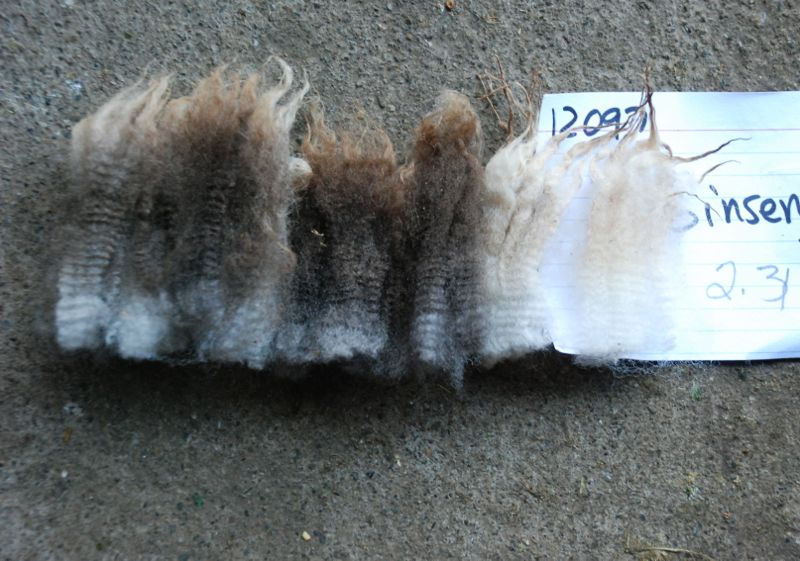 Ginseng is also a lilac lamb and her fleece shows the color change at the same place as does Presley's.
Ginseng is also a lilac lamb and her fleece shows the color change at the same place as does Presley's.
I have no answers yet (except that Mary and Shelby won't be going to the fair), but I'm going to examine the rest of the fleeces as I sort through them and I think I'll pay more attention to horn growth after this. I'll report back if the vets give me any answers.
A Riot of Rams
/You've heard of a Flock of Sheep, a Herd of Horses, a Gaggle of Geese. How about a Riot of Rams as a subset of the Flock? Larry came home yesterday. He is a ram born last February (still called a lamb up to his first birthday) and was with a nearby flock of ewes. Whenever rams that have reached sexual maturity (and that could be 5 to 6 months) are to be reunited there are apt to be fights until they have figured out the pecking order. The shepherd's job is to prevent injury, death, and property damage. Most of the time that means putting all the rams together in a pen that is small enough that they can't back up and put their whole body force into the inevitable ramming that occurs.
This is Larry. He is a nice looking ram lamb. Since I was going to be moving all the rams I took the opportunity to trim all their feet.
 This is one of the ram lambs born at the State Fair in July.
This is one of the ram lambs born at the State Fair in July.
 Here is Sullivan, a yearling ram. He was shorn along with the rest of the flock last month. Larry missed shearing so I'll have to shear him by hand, and I didn't shear those lambs that are going to be sold. Do you notice a swelling just under and behind the two spots on his shoulders?
Here is Sullivan, a yearling ram. He was shorn along with the rest of the flock last month. Larry missed shearing so I'll have to shear him by hand, and I didn't shear those lambs that are going to be sold. Do you notice a swelling just under and behind the two spots on his shoulders?
 Here is what it is like close-up. I noticed it a few days ago and I think it is a hematoma, probably a result of rams tussling.
Here is what it is like close-up. I noticed it a few days ago and I think it is a hematoma, probably a result of rams tussling.
How do I put the rams in close quarters? I don't want them near the ewes because that would be asking for trouble. I particularly don't want any of these rams trying to get over or through the fence to get in with the ewes. So I use one of the stalls, but a 12' x 12' stall is way too big. I use panels to make a pen in the corner of a stall.
 There is a feeder just out of this photo at the bottom of this photo. The two shorn rams at the feeder are the February lambs. The two rams with wool at the feeder and the one in the top corner are the July lambs. Sullivan is the 2-horn ram in the center and Larry is the 4-horn ram next to Sullivan. Small enough pen?
There is a feeder just out of this photo at the bottom of this photo. The two shorn rams at the feeder are the February lambs. The two rams with wool at the feeder and the one in the top corner are the July lambs. Sullivan is the 2-horn ram in the center and Larry is the 4-horn ram next to Sullivan. Small enough pen?
 Evidently not. I tried to take video so I could share the real impact (pun intended) of this, but it was too dark in here. In this photo Larry goes for Sullivan.
Evidently not. I tried to take video so I could share the real impact (pun intended) of this, but it was too dark in here. In this photo Larry goes for Sullivan.
 Now it's Sullivan's turn. You can't tell in these photos but there is real power behind these hits.
Now it's Sullivan's turn. You can't tell in these photos but there is real power behind these hits.
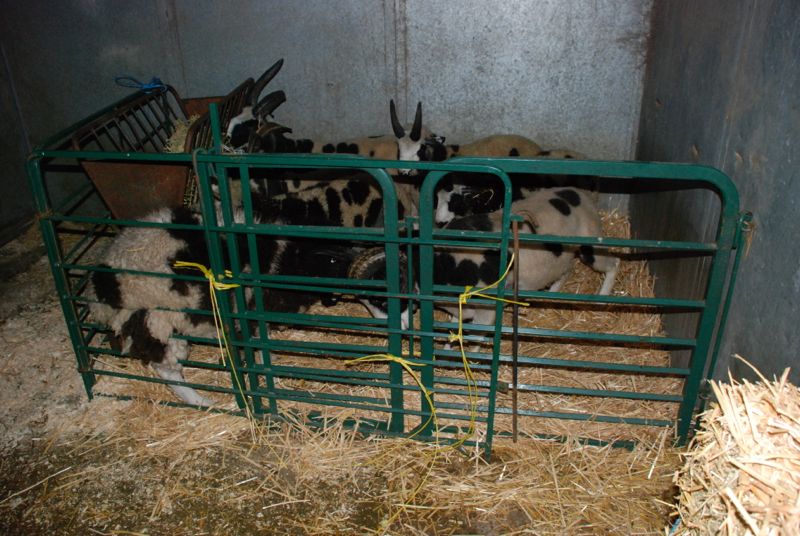 Another view. They are still fighting.
Another view. They are still fighting.
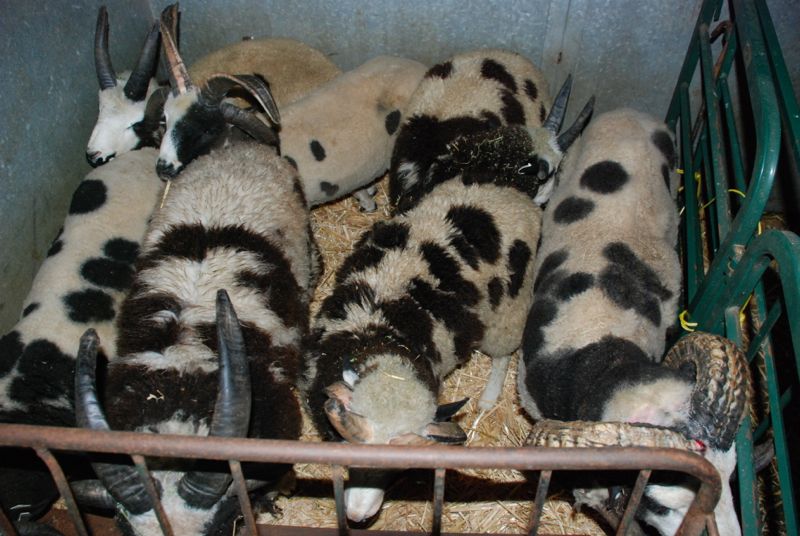 I collapsed the pen a bit more and they gave it up. Or maybe it took the fun out of the fight when they couldn't back up to bash each other.
I collapsed the pen a bit more and they gave it up. Or maybe it took the fun out of the fight when they couldn't back up to bash each other.
This morning all the rams were behaving so I gave them more space. Tomorrow they will go out to the ram pen and live happily ever after...











